Quick filters:
Achaemenid period Stock Photos and Images
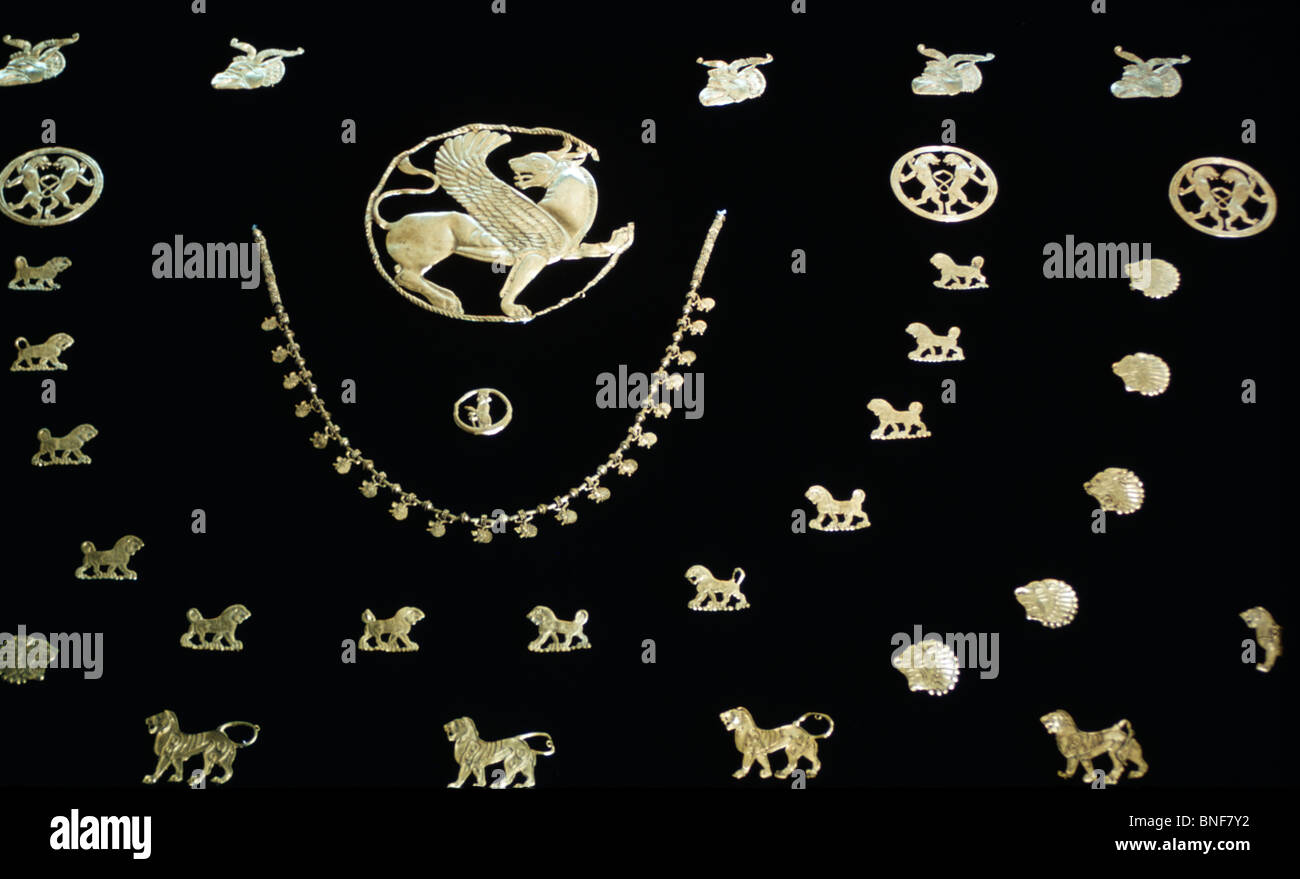 Necklace, Gold Ornaments from Achaemenid Period Persian Antiques-Jewelry Stock Photohttps://www.alamy.com/image-license-details/?v=1https://www.alamy.com/stock-photo-necklace-gold-ornaments-from-achaemenid-period-persian-antiques-jewelry-30453670.html
Necklace, Gold Ornaments from Achaemenid Period Persian Antiques-Jewelry Stock Photohttps://www.alamy.com/image-license-details/?v=1https://www.alamy.com/stock-photo-necklace-gold-ornaments-from-achaemenid-period-persian-antiques-jewelry-30453670.htmlRMBNF7Y2–Necklace, Gold Ornaments from Achaemenid Period Persian Antiques-Jewelry
 Appliques to ornament courtly costume, Iran, Achaemenid Period, 521 330 BC, gold Museum of Fine Arts, Boston DSC02831 Stock Photohttps://www.alamy.com/image-license-details/?v=1https://www.alamy.com/appliques-to-ornament-courtly-costume-iran-achaemenid-period-521-330-image155516084.html
Appliques to ornament courtly costume, Iran, Achaemenid Period, 521 330 BC, gold Museum of Fine Arts, Boston DSC02831 Stock Photohttps://www.alamy.com/image-license-details/?v=1https://www.alamy.com/appliques-to-ornament-courtly-costume-iran-achaemenid-period-521-330-image155516084.htmlRMK10A9T–Appliques to ornament courtly costume, Iran, Achaemenid Period, 521 330 BC, gold Museum of Fine Arts, Boston DSC02831
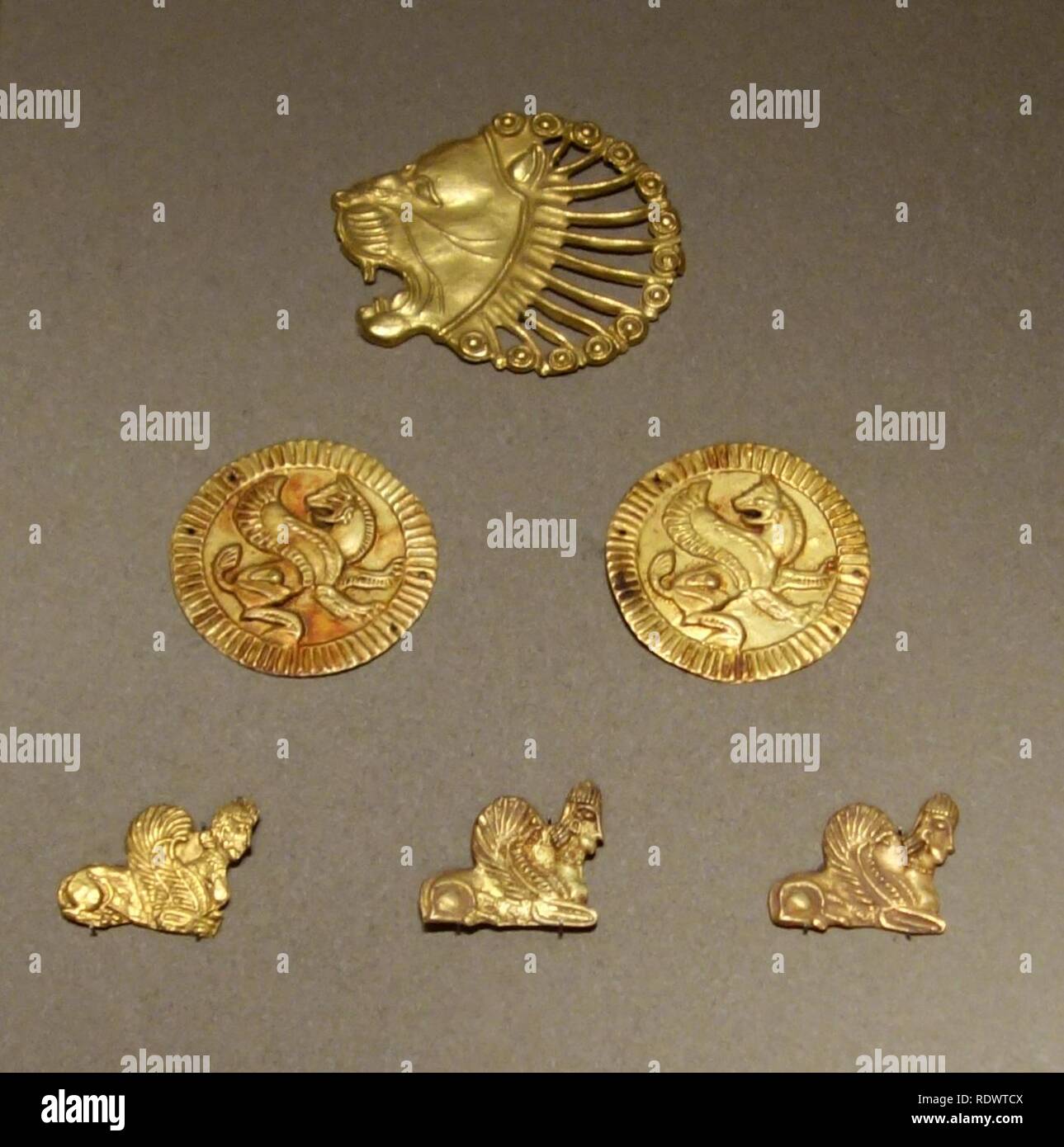 Appliques to ornament courtly costume, Iran, Achaemenid Period, 521-330 BC, gold - Stock Photohttps://www.alamy.com/image-license-details/?v=1https://www.alamy.com/appliques-to-ornament-courtly-costume-iran-achaemenid-period-521-330-bc-gold-image232293290.html
Appliques to ornament courtly costume, Iran, Achaemenid Period, 521-330 BC, gold - Stock Photohttps://www.alamy.com/image-license-details/?v=1https://www.alamy.com/appliques-to-ornament-courtly-costume-iran-achaemenid-period-521-330-bc-gold-image232293290.htmlRMRDWTCX–Appliques to ornament courtly costume, Iran, Achaemenid Period, 521-330 BC, gold -
 Archers, frieze of archers Achaemenid period, reign of Darius the first 510 before J-C Stock Photohttps://www.alamy.com/image-license-details/?v=1https://www.alamy.com/stock-photo-archers-frieze-of-archers-achaemenid-period-reign-of-darius-the-first-57229477.html
Archers, frieze of archers Achaemenid period, reign of Darius the first 510 before J-C Stock Photohttps://www.alamy.com/image-license-details/?v=1https://www.alamy.com/stock-photo-archers-frieze-of-archers-achaemenid-period-reign-of-darius-the-first-57229477.htmlRMD930NW–Archers, frieze of archers Achaemenid period, reign of Darius the first 510 before J-C
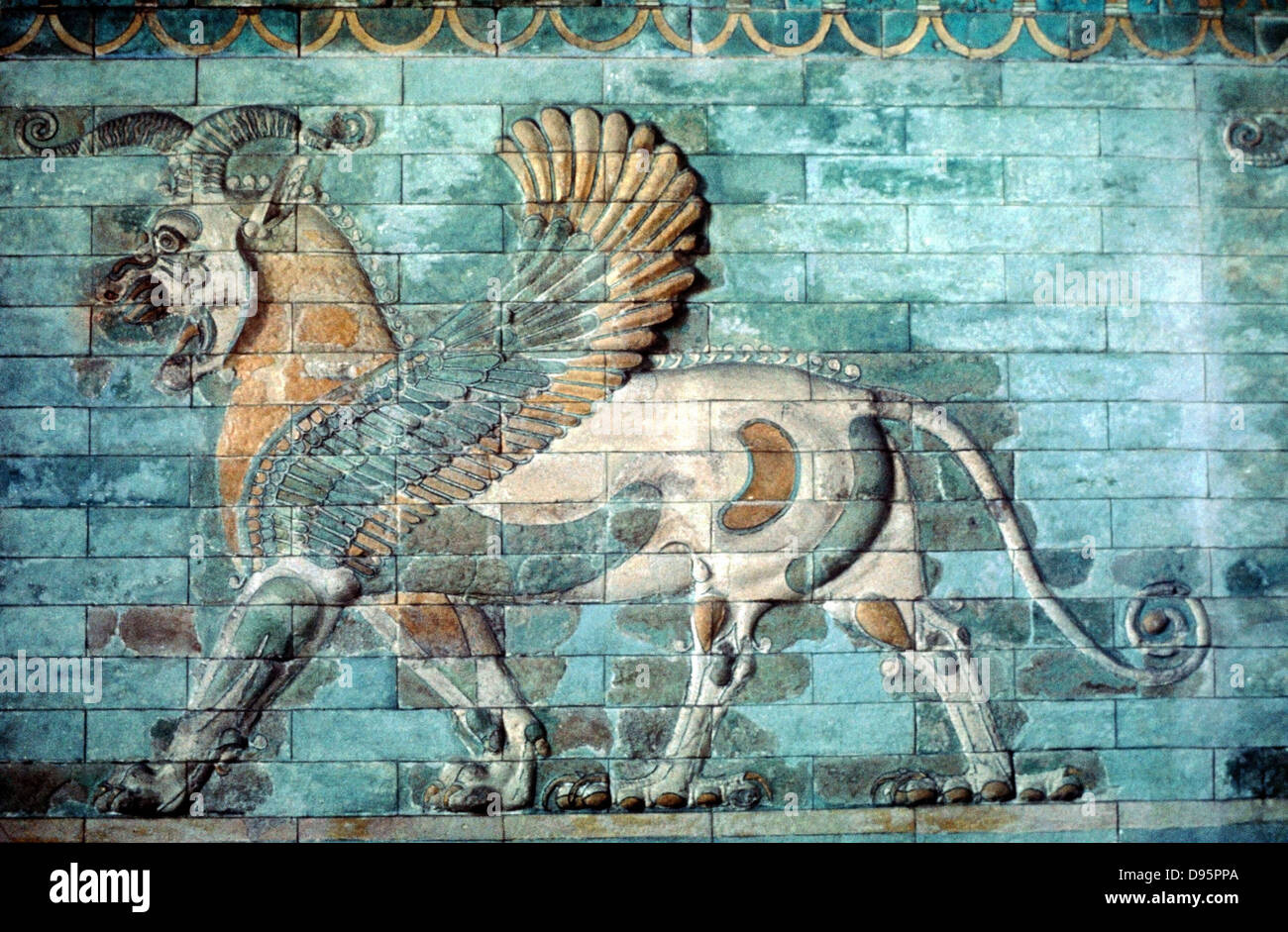 Ancient Persia, Achaemenid Period (530-330 BC) Griffin-Lion relief in glazed brickwork. Louvre, Paris. Stock Photohttps://www.alamy.com/image-license-details/?v=1https://www.alamy.com/stock-photo-ancient-persia-achaemenid-period-530-330-bc-griffin-lion-relief-in-57290642.html
Ancient Persia, Achaemenid Period (530-330 BC) Griffin-Lion relief in glazed brickwork. Louvre, Paris. Stock Photohttps://www.alamy.com/image-license-details/?v=1https://www.alamy.com/stock-photo-ancient-persia-achaemenid-period-530-330-bc-griffin-lion-relief-in-57290642.htmlRMD95PPA–Ancient Persia, Achaemenid Period (530-330 BC) Griffin-Lion relief in glazed brickwork. Louvre, Paris.
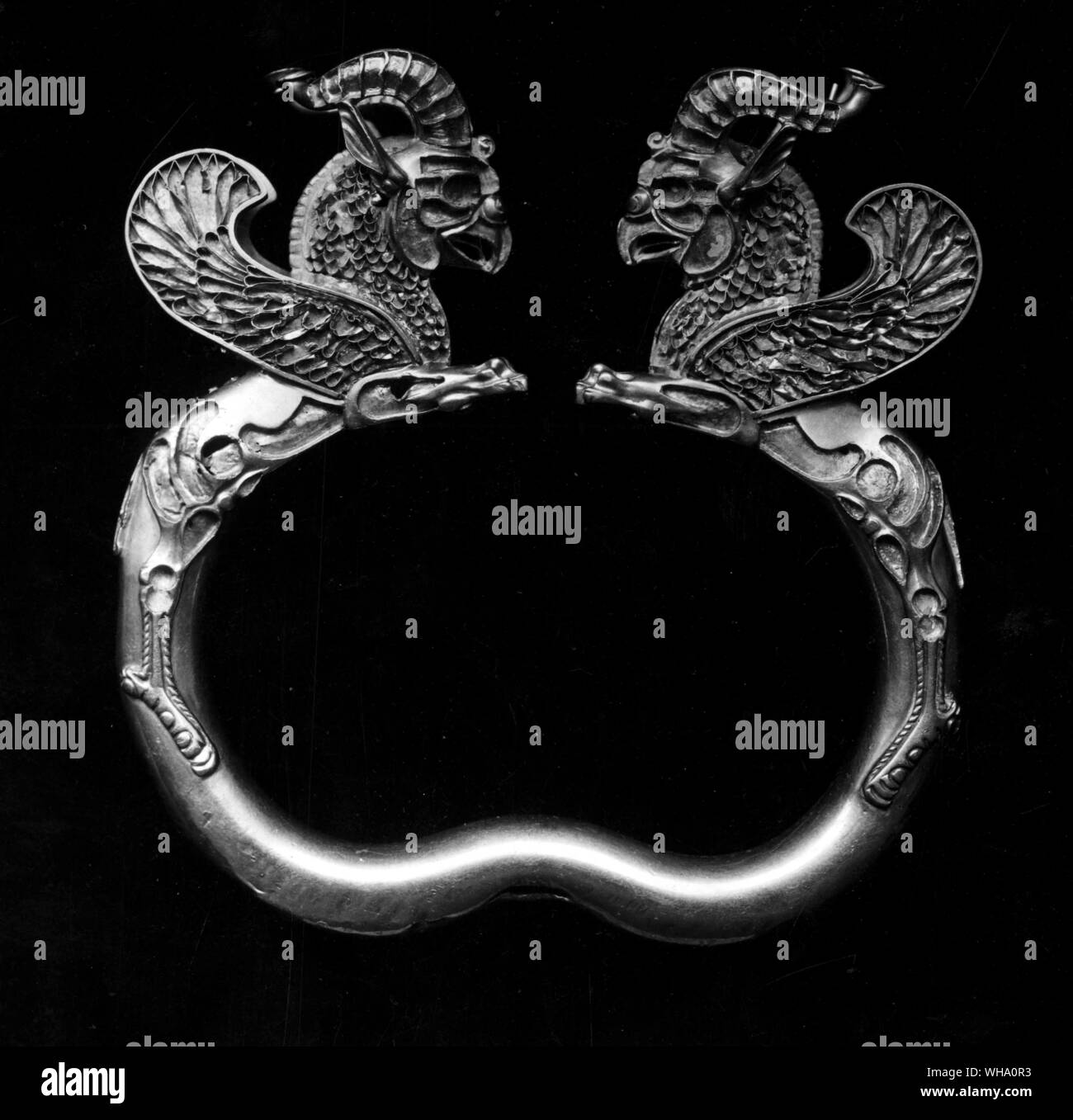 Gold amulet with finials in the form of griffins. Persian. Achaemenid period. 5th Century. B.C. Stock Photohttps://www.alamy.com/image-license-details/?v=1https://www.alamy.com/gold-amulet-with-finials-in-the-form-of-griffins-persian-achaemenid-period-5th-century-bc-image268824839.html
Gold amulet with finials in the form of griffins. Persian. Achaemenid period. 5th Century. B.C. Stock Photohttps://www.alamy.com/image-license-details/?v=1https://www.alamy.com/gold-amulet-with-finials-in-the-form-of-griffins-persian-achaemenid-period-5th-century-bc-image268824839.htmlRMWHA0R3–Gold amulet with finials in the form of griffins. Persian. Achaemenid period. 5th Century. B.C.
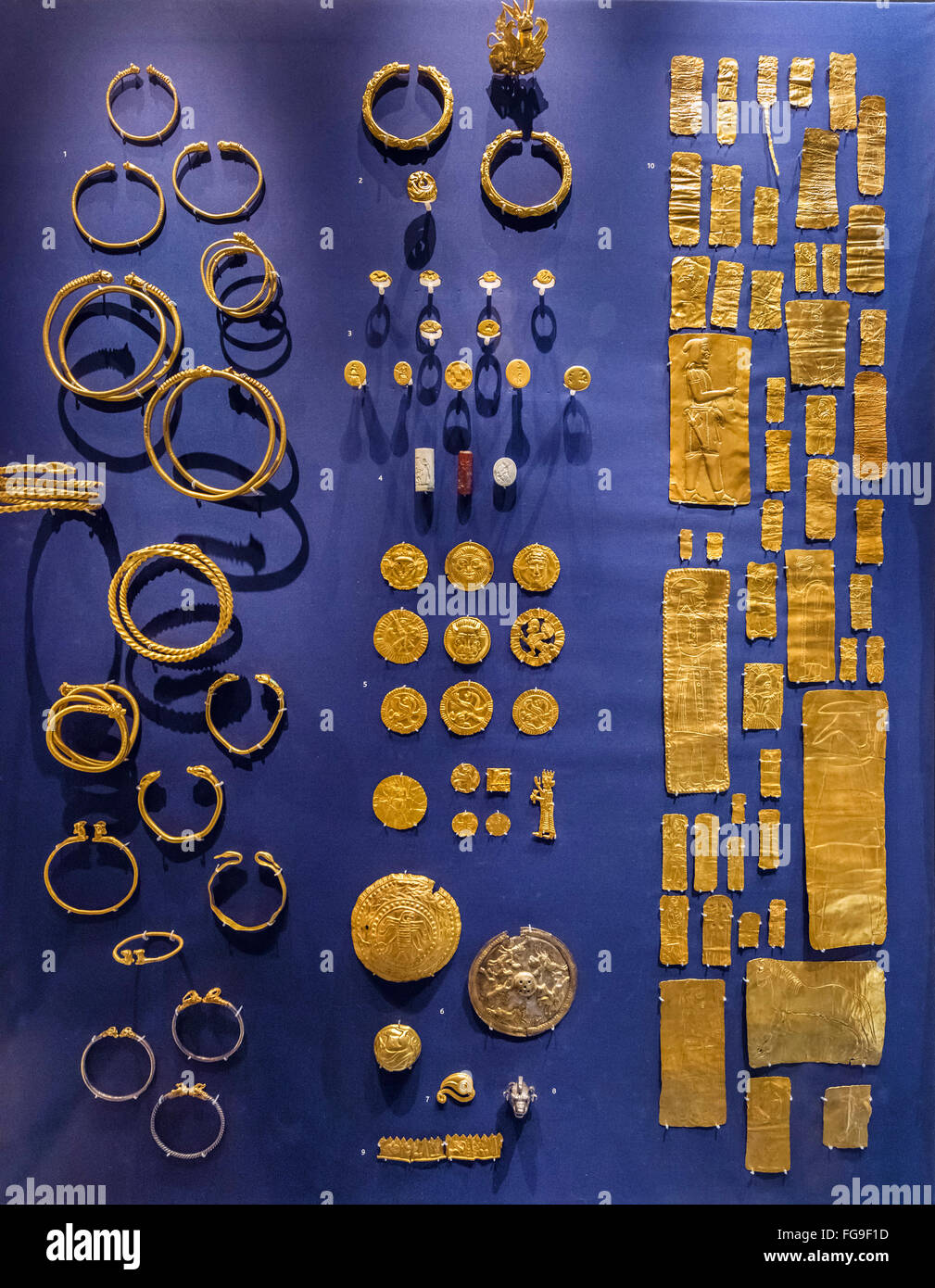 Pieces from the Oxus Treasure from the Achaemenid Persian period, Ancient Iran gallery, British Museum, London, UK Stock Photohttps://www.alamy.com/image-license-details/?v=1https://www.alamy.com/stock-photo-pieces-from-the-oxus-treasure-from-the-achaemenid-persian-period-ancient-96095705.html
Pieces from the Oxus Treasure from the Achaemenid Persian period, Ancient Iran gallery, British Museum, London, UK Stock Photohttps://www.alamy.com/image-license-details/?v=1https://www.alamy.com/stock-photo-pieces-from-the-oxus-treasure-from-the-achaemenid-persian-period-ancient-96095705.htmlRMFG9F1D–Pieces from the Oxus Treasure from the Achaemenid Persian period, Ancient Iran gallery, British Museum, London, UK
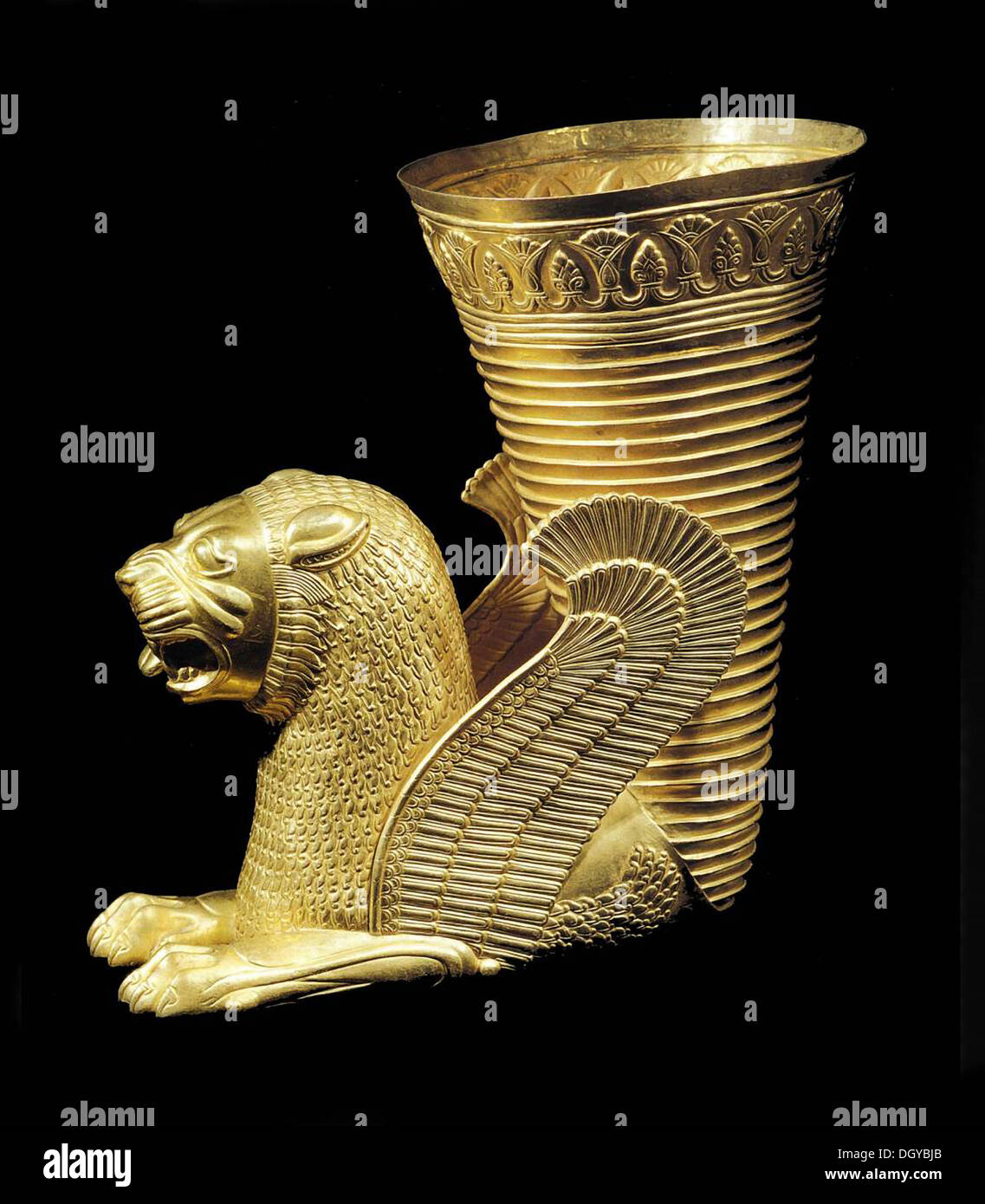 5712. Golden rhyton from Iran's Achaemenid period (c. 550–330 BCE), also known as the First Persian Empire, founded in the 6th century BCE by King Cyrus the Great Stock Photohttps://www.alamy.com/image-license-details/?v=1https://www.alamy.com/5712-golden-rhyton-from-irans-achaemenid-period-c-550330-bce-also-image62067443.html
5712. Golden rhyton from Iran's Achaemenid period (c. 550–330 BCE), also known as the First Persian Empire, founded in the 6th century BCE by King Cyrus the Great Stock Photohttps://www.alamy.com/image-license-details/?v=1https://www.alamy.com/5712-golden-rhyton-from-irans-achaemenid-period-c-550330-bce-also-image62067443.htmlRMDGYBJB–5712. Golden rhyton from Iran's Achaemenid period (c. 550–330 BCE), also known as the First Persian Empire, founded in the 6th century BCE by King Cyrus the Great
 Column base from the Achaemenid period, glazed tiles with handrails from the same period and small fire altar in glazed earthenware from the Pasthe period. Old 19th century engraved illustration from La Nature 1889 Stock Photohttps://www.alamy.com/image-license-details/?v=1https://www.alamy.com/column-base-from-the-achaemenid-period-glazed-tiles-with-handrails-from-the-same-period-and-small-fire-altar-in-glazed-earthenware-from-the-pasthe-period-old-19th-century-engraved-illustration-from-la-nature-1889-image418817966.html
Column base from the Achaemenid period, glazed tiles with handrails from the same period and small fire altar in glazed earthenware from the Pasthe period. Old 19th century engraved illustration from La Nature 1889 Stock Photohttps://www.alamy.com/image-license-details/?v=1https://www.alamy.com/column-base-from-the-achaemenid-period-glazed-tiles-with-handrails-from-the-same-period-and-small-fire-altar-in-glazed-earthenware-from-the-pasthe-period-old-19th-century-engraved-illustration-from-la-nature-1889-image418817966.htmlRM2F9APGE–Column base from the Achaemenid period, glazed tiles with handrails from the same period and small fire altar in glazed earthenware from the Pasthe period. Old 19th century engraved illustration from La Nature 1889
 Achaemenid period. 5th century BC. Legendary creature with human head and bull body. Possibly it was part of a capital. From Persepolis. National Museum of Iran. Tehran, Islamic Republic of Iran. Stock Photohttps://www.alamy.com/image-license-details/?v=1https://www.alamy.com/achaemenid-period-5th-century-bc-legendary-creature-with-human-head-and-bull-body-possibly-it-was-part-of-a-capital-from-persepolis-national-museum-of-iran-tehran-islamic-republic-of-iran-image222284385.html
Achaemenid period. 5th century BC. Legendary creature with human head and bull body. Possibly it was part of a capital. From Persepolis. National Museum of Iran. Tehran, Islamic Republic of Iran. Stock Photohttps://www.alamy.com/image-license-details/?v=1https://www.alamy.com/achaemenid-period-5th-century-bc-legendary-creature-with-human-head-and-bull-body-possibly-it-was-part-of-a-capital-from-persepolis-national-museum-of-iran-tehran-islamic-republic-of-iran-image222284385.htmlRMPWHX01–Achaemenid period. 5th century BC. Legendary creature with human head and bull body. Possibly it was part of a capital. From Persepolis. National Museum of Iran. Tehran, Islamic Republic of Iran.
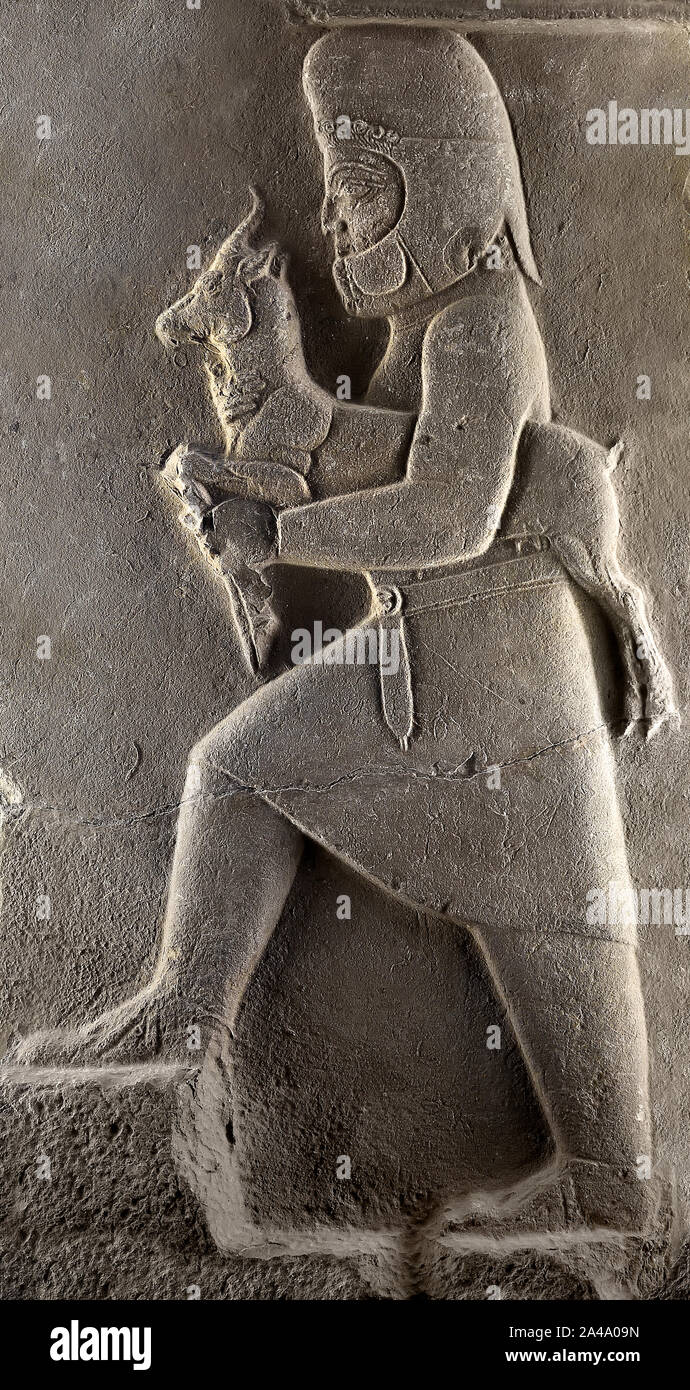 Deer carrier climbing a ladder 5th century BC Achaemenid period, Persepolis, Limestone. ( Persepolis was the ceremonial capital of the Achaemenid Empire (ca. 550–330 BC). It is situated 60 km northeast of the city of Shiraz in Fars Province, Iran. ) Stock Photohttps://www.alamy.com/image-license-details/?v=1https://www.alamy.com/deer-carrier-climbing-a-ladder-5th-century-bc-achaemenid-period-persepolis-limestone-persepolis-was-the-ceremonial-capital-of-the-achaemenid-empire-ca-550330-bc-it-is-situated-60-km-northeast-of-the-city-of-shiraz-in-fars-province-iran-image329675409.html
Deer carrier climbing a ladder 5th century BC Achaemenid period, Persepolis, Limestone. ( Persepolis was the ceremonial capital of the Achaemenid Empire (ca. 550–330 BC). It is situated 60 km northeast of the city of Shiraz in Fars Province, Iran. ) Stock Photohttps://www.alamy.com/image-license-details/?v=1https://www.alamy.com/deer-carrier-climbing-a-ladder-5th-century-bc-achaemenid-period-persepolis-limestone-persepolis-was-the-ceremonial-capital-of-the-achaemenid-empire-ca-550330-bc-it-is-situated-60-km-northeast-of-the-city-of-shiraz-in-fars-province-iran-image329675409.htmlRM2A4A09N–Deer carrier climbing a ladder 5th century BC Achaemenid period, Persepolis, Limestone. ( Persepolis was the ceremonial capital of the Achaemenid Empire (ca. 550–330 BC). It is situated 60 km northeast of the city of Shiraz in Fars Province, Iran. )
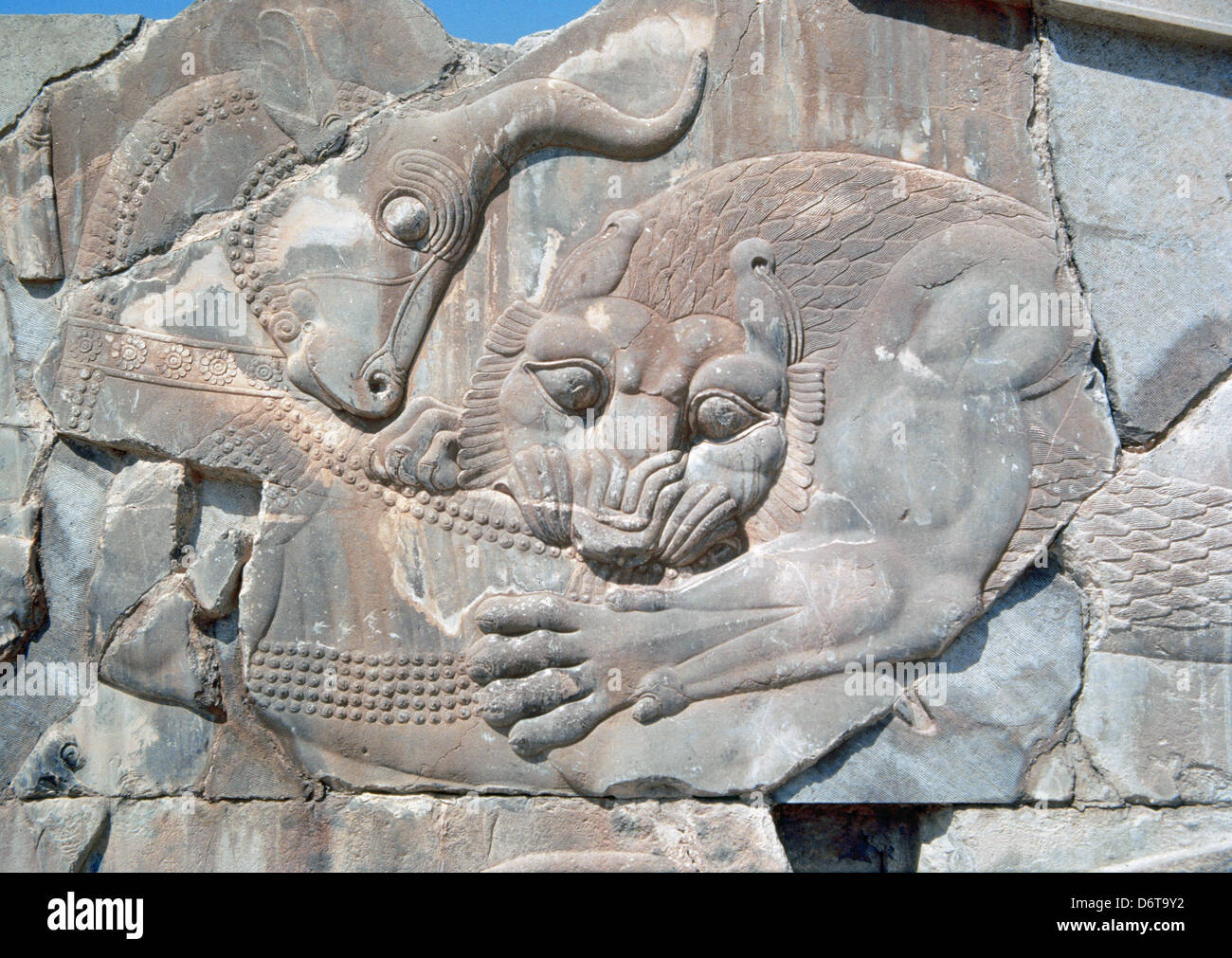 Persepolis. Achaemenid period. Apadana Palace. Lion and bull combat. Relief. 6th century and 5th centuries BC. Stock Photohttps://www.alamy.com/image-license-details/?v=1https://www.alamy.com/stock-photo-persepolis-achaemenid-period-apadana-palace-lion-and-bull-combat-relief-55853702.html
Persepolis. Achaemenid period. Apadana Palace. Lion and bull combat. Relief. 6th century and 5th centuries BC. Stock Photohttps://www.alamy.com/image-license-details/?v=1https://www.alamy.com/stock-photo-persepolis-achaemenid-period-apadana-palace-lion-and-bull-combat-relief-55853702.htmlRMD6T9Y2–Persepolis. Achaemenid period. Apadana Palace. Lion and bull combat. Relief. 6th century and 5th centuries BC.
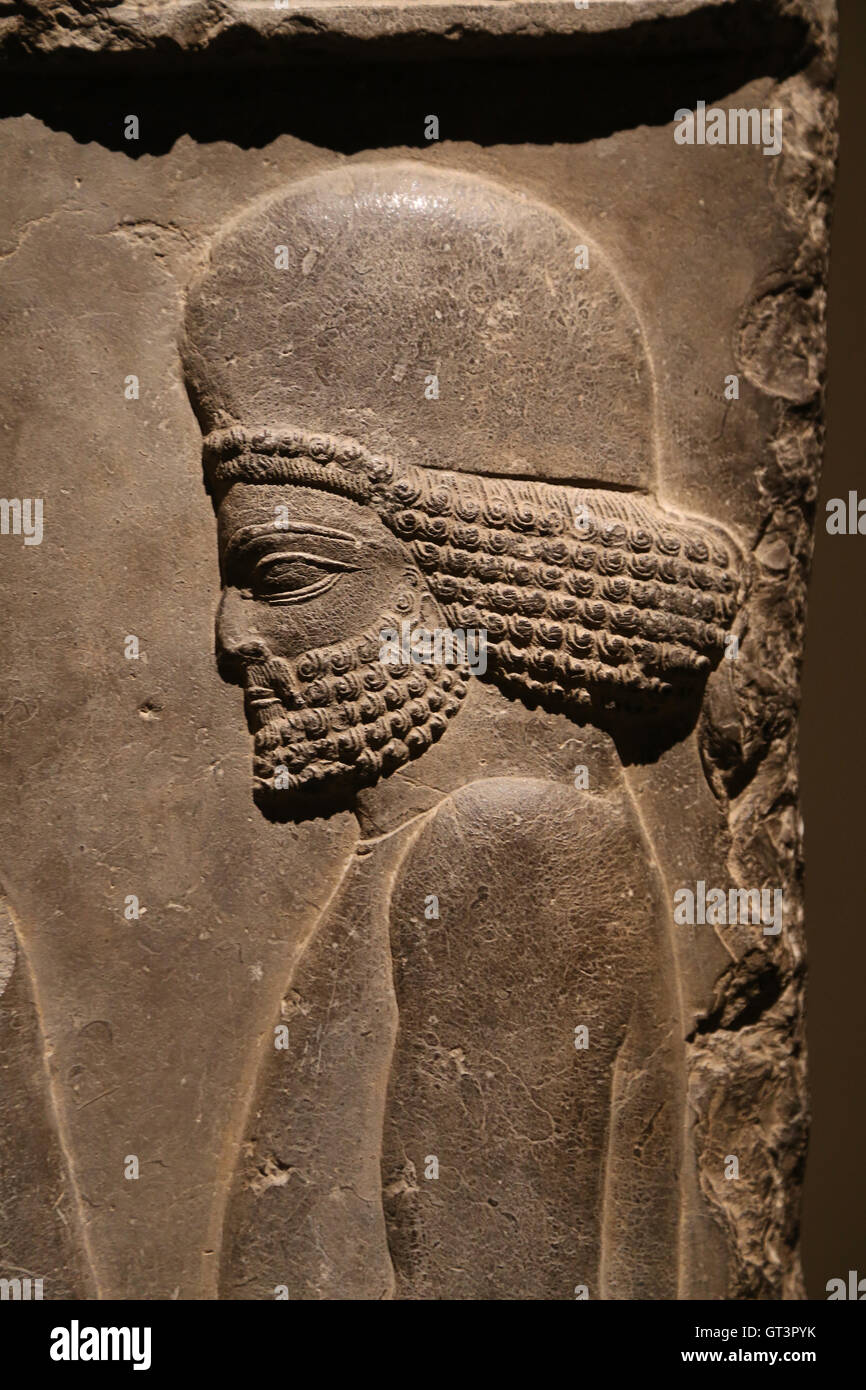 Achaemenid period. Reign of Artaxerxes II, 405-360 B.C. Figure in a procession. Palace of Darius I. Persepolis. Iran. Stock Photohttps://www.alamy.com/image-license-details/?v=1https://www.alamy.com/stock-photo-achaemenid-period-reign-of-artaxerxes-ii-405-360-bc-figure-in-a-procession-118097831.html
Achaemenid period. Reign of Artaxerxes II, 405-360 B.C. Figure in a procession. Palace of Darius I. Persepolis. Iran. Stock Photohttps://www.alamy.com/image-license-details/?v=1https://www.alamy.com/stock-photo-achaemenid-period-reign-of-artaxerxes-ii-405-360-bc-figure-in-a-procession-118097831.htmlRMGT3PYK–Achaemenid period. Reign of Artaxerxes II, 405-360 B.C. Figure in a procession. Palace of Darius I. Persepolis. Iran.
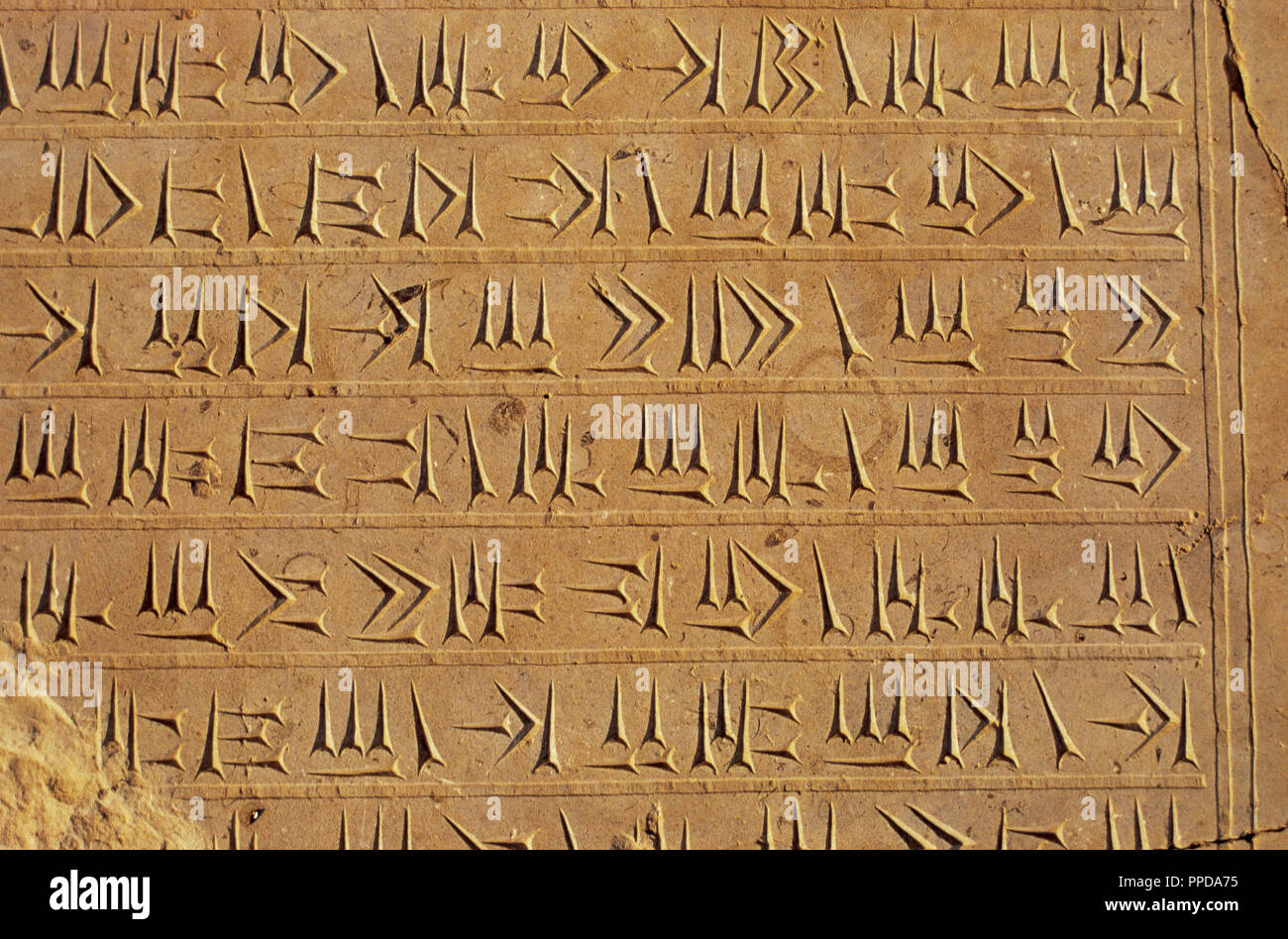 Persian Empire. Achaemenid period. Cuneiform writing on the wall of the Palace of Persepolis. 5th century B.C. Islamic Republic of Iran. Stock Photohttps://www.alamy.com/image-license-details/?v=1https://www.alamy.com/persian-empire-achaemenid-period-cuneiform-writing-on-the-wall-of-the-palace-of-persepolis-5th-century-bc-islamic-republic-of-iran-image220340265.html
Persian Empire. Achaemenid period. Cuneiform writing on the wall of the Palace of Persepolis. 5th century B.C. Islamic Republic of Iran. Stock Photohttps://www.alamy.com/image-license-details/?v=1https://www.alamy.com/persian-empire-achaemenid-period-cuneiform-writing-on-the-wall-of-the-palace-of-persepolis-5th-century-bc-islamic-republic-of-iran-image220340265.htmlRMPPDA75–Persian Empire. Achaemenid period. Cuneiform writing on the wall of the Palace of Persepolis. 5th century B.C. Islamic Republic of Iran.
 a huge building with columns of the ceremonial capital of the kings of the Achaemenid period Stock Photohttps://www.alamy.com/image-license-details/?v=1https://www.alamy.com/a-huge-building-with-columns-of-the-ceremonial-capital-of-the-kings-of-the-achaemenid-period-image554075628.html
a huge building with columns of the ceremonial capital of the kings of the Achaemenid period Stock Photohttps://www.alamy.com/image-license-details/?v=1https://www.alamy.com/a-huge-building-with-columns-of-the-ceremonial-capital-of-the-kings-of-the-achaemenid-period-image554075628.htmlRF2R5C938–a huge building with columns of the ceremonial capital of the kings of the Achaemenid period
 Perseppolis relief. Apadana. Darius the Great on the throne. Achaemenid Period. Stock Photohttps://www.alamy.com/image-license-details/?v=1https://www.alamy.com/stock-photo-perseppolis-relief-apadana-darius-the-great-on-the-throne-achaemenid-17843165.html
Perseppolis relief. Apadana. Darius the Great on the throne. Achaemenid Period. Stock Photohttps://www.alamy.com/image-license-details/?v=1https://www.alamy.com/stock-photo-perseppolis-relief-apadana-darius-the-great-on-the-throne-achaemenid-17843165.htmlRMB10R3W–Perseppolis relief. Apadana. Darius the Great on the throne. Achaemenid Period.
 Art inspired by Relief: two servants bearing food and drink, Achaemenid, ca. 358–338 B.C., Iran, Persepolis, Achaemenid, Limestone, H. 86.5 cm, Stone-Reliefs, The monumental art and architecture of the Achaemenid period are best exemplified by the ruins of Persepolis, the large, Classic works modernized by Artotop with a splash of modernity. Shapes, color and value, eye-catching visual impact on art. Emotions through freedom of artworks in a contemporary way. A timeless message pursuing a wildly creative new direction. Artists turning to the digital medium and creating the Artotop NFT Stock Photohttps://www.alamy.com/image-license-details/?v=1https://www.alamy.com/art-inspired-by-relief-two-servants-bearing-food-and-drink-achaemenid-ca-358338-bc-iran-persepolis-achaemenid-limestone-h-865-cm-stone-reliefs-the-monumental-art-and-architecture-of-the-achaemenid-period-are-best-exemplified-by-the-ruins-of-persepolis-the-large-classic-works-modernized-by-artotop-with-a-splash-of-modernity-shapes-color-and-value-eye-catching-visual-impact-on-art-emotions-through-freedom-of-artworks-in-a-contemporary-way-a-timeless-message-pursuing-a-wildly-creative-new-direction-artists-turning-to-the-digital-medium-and-creating-the-artotop-nft-image462944576.html
Art inspired by Relief: two servants bearing food and drink, Achaemenid, ca. 358–338 B.C., Iran, Persepolis, Achaemenid, Limestone, H. 86.5 cm, Stone-Reliefs, The monumental art and architecture of the Achaemenid period are best exemplified by the ruins of Persepolis, the large, Classic works modernized by Artotop with a splash of modernity. Shapes, color and value, eye-catching visual impact on art. Emotions through freedom of artworks in a contemporary way. A timeless message pursuing a wildly creative new direction. Artists turning to the digital medium and creating the Artotop NFT Stock Photohttps://www.alamy.com/image-license-details/?v=1https://www.alamy.com/art-inspired-by-relief-two-servants-bearing-food-and-drink-achaemenid-ca-358338-bc-iran-persepolis-achaemenid-limestone-h-865-cm-stone-reliefs-the-monumental-art-and-architecture-of-the-achaemenid-period-are-best-exemplified-by-the-ruins-of-persepolis-the-large-classic-works-modernized-by-artotop-with-a-splash-of-modernity-shapes-color-and-value-eye-catching-visual-impact-on-art-emotions-through-freedom-of-artworks-in-a-contemporary-way-a-timeless-message-pursuing-a-wildly-creative-new-direction-artists-turning-to-the-digital-medium-and-creating-the-artotop-nft-image462944576.htmlRF2HW4XET–Art inspired by Relief: two servants bearing food and drink, Achaemenid, ca. 358–338 B.C., Iran, Persepolis, Achaemenid, Limestone, H. 86.5 cm, Stone-Reliefs, The monumental art and architecture of the Achaemenid period are best exemplified by the ruins of Persepolis, the large, Classic works modernized by Artotop with a splash of modernity. Shapes, color and value, eye-catching visual impact on art. Emotions through freedom of artworks in a contemporary way. A timeless message pursuing a wildly creative new direction. Artists turning to the digital medium and creating the Artotop NFT
 Griffin-lion relief in glazed brickwork, Achaemenid Period, Ancient Persia, 530-330 BC. Artist: Unknown Stock Photohttps://www.alamy.com/image-license-details/?v=1https://www.alamy.com/griffin-lion-relief-in-glazed-brickwork-achaemenid-period-ancient-persia-530-330-bc-artist-unknown-image262742510.html
Griffin-lion relief in glazed brickwork, Achaemenid Period, Ancient Persia, 530-330 BC. Artist: Unknown Stock Photohttps://www.alamy.com/image-license-details/?v=1https://www.alamy.com/griffin-lion-relief-in-glazed-brickwork-achaemenid-period-ancient-persia-530-330-bc-artist-unknown-image262742510.htmlRMW7CXN2–Griffin-lion relief in glazed brickwork, Achaemenid Period, Ancient Persia, 530-330 BC. Artist: Unknown
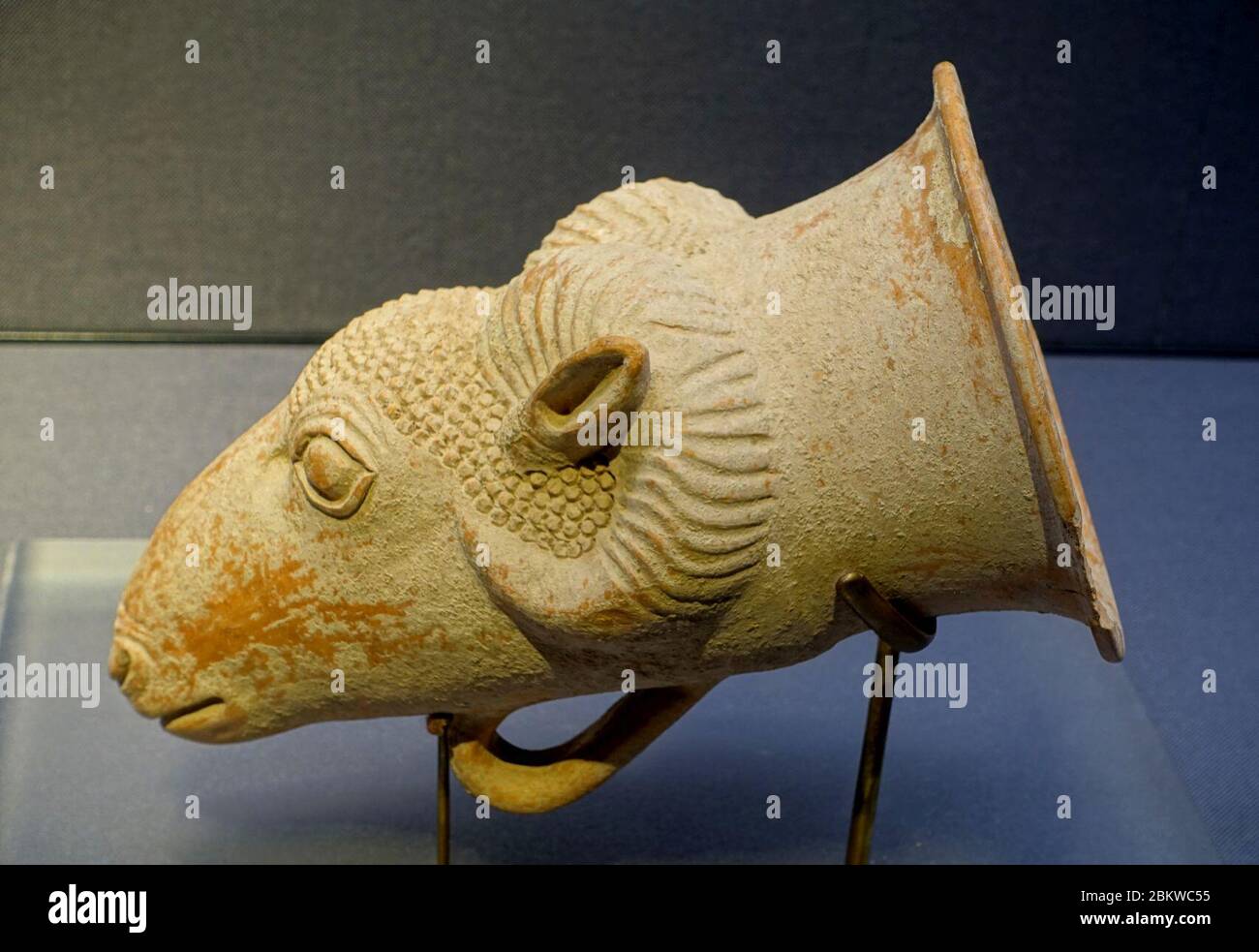 Ibex head-shaped rhyton, excavated in Gilan, Iran, Achaemenid period, 6th-5th century BC, earthenware Stock Photohttps://www.alamy.com/image-license-details/?v=1https://www.alamy.com/ibex-head-shaped-rhyton-excavated-in-gilan-iran-achaemenid-period-6th-5th-century-bc-earthenware-image356444177.html
Ibex head-shaped rhyton, excavated in Gilan, Iran, Achaemenid period, 6th-5th century BC, earthenware Stock Photohttps://www.alamy.com/image-license-details/?v=1https://www.alamy.com/ibex-head-shaped-rhyton-excavated-in-gilan-iran-achaemenid-period-6th-5th-century-bc-earthenware-image356444177.htmlRM2BKWC55–Ibex head-shaped rhyton, excavated in Gilan, Iran, Achaemenid period, 6th-5th century BC, earthenware
 Achaemenid trial piece, probably from Egypt, Achaemenid Period, 550 330 BC, limestone Oriental Institute Museum, University of Chicago DSC08004 Stock Photohttps://www.alamy.com/image-license-details/?v=1https://www.alamy.com/achaemenid-trial-piece-probably-from-egypt-achaemenid-period-550-330-image155517597.html
Achaemenid trial piece, probably from Egypt, Achaemenid Period, 550 330 BC, limestone Oriental Institute Museum, University of Chicago DSC08004 Stock Photohttps://www.alamy.com/image-license-details/?v=1https://www.alamy.com/achaemenid-trial-piece-probably-from-egypt-achaemenid-period-550-330-image155517597.htmlRMK10C7W–Achaemenid trial piece, probably from Egypt, Achaemenid Period, 550 330 BC, limestone Oriental Institute Museum, University of Chicago DSC08004
 Achaemenid trial piece, probably from Egypt, Achaemenid Period, 550-330 BC, limestone - Oriental Institute Museum, University of Chicago - DSC08004. Stock Photohttps://www.alamy.com/image-license-details/?v=1https://www.alamy.com/achaemenid-trial-piece-probably-from-egypt-achaemenid-period-550-330-bc-limestone-oriental-institute-museum-university-of-chicago-dsc08004-image231073918.html
Achaemenid trial piece, probably from Egypt, Achaemenid Period, 550-330 BC, limestone - Oriental Institute Museum, University of Chicago - DSC08004. Stock Photohttps://www.alamy.com/image-license-details/?v=1https://www.alamy.com/achaemenid-trial-piece-probably-from-egypt-achaemenid-period-550-330-bc-limestone-oriental-institute-museum-university-of-chicago-dsc08004-image231073918.htmlRMRBX93X–Achaemenid trial piece, probably from Egypt, Achaemenid Period, 550-330 BC, limestone - Oriental Institute Museum, University of Chicago - DSC08004.
 Persian Architecture is a stair parapet, achaemenid period, monumental style in which relief sculpture, vintage line drawing or engraving illustratio Stock Vectorhttps://www.alamy.com/image-license-details/?v=1https://www.alamy.com/persian-architecture-is-a-stair-parapet-achaemenid-period-monumental-style-in-which-relief-sculpture-vintage-line-drawing-or-engraving-illustratio-image348654471.html
Persian Architecture is a stair parapet, achaemenid period, monumental style in which relief sculpture, vintage line drawing or engraving illustratio Stock Vectorhttps://www.alamy.com/image-license-details/?v=1https://www.alamy.com/persian-architecture-is-a-stair-parapet-achaemenid-period-monumental-style-in-which-relief-sculpture-vintage-line-drawing-or-engraving-illustratio-image348654471.htmlRF2B76G9B–Persian Architecture is a stair parapet, achaemenid period, monumental style in which relief sculpture, vintage line drawing or engraving illustratio
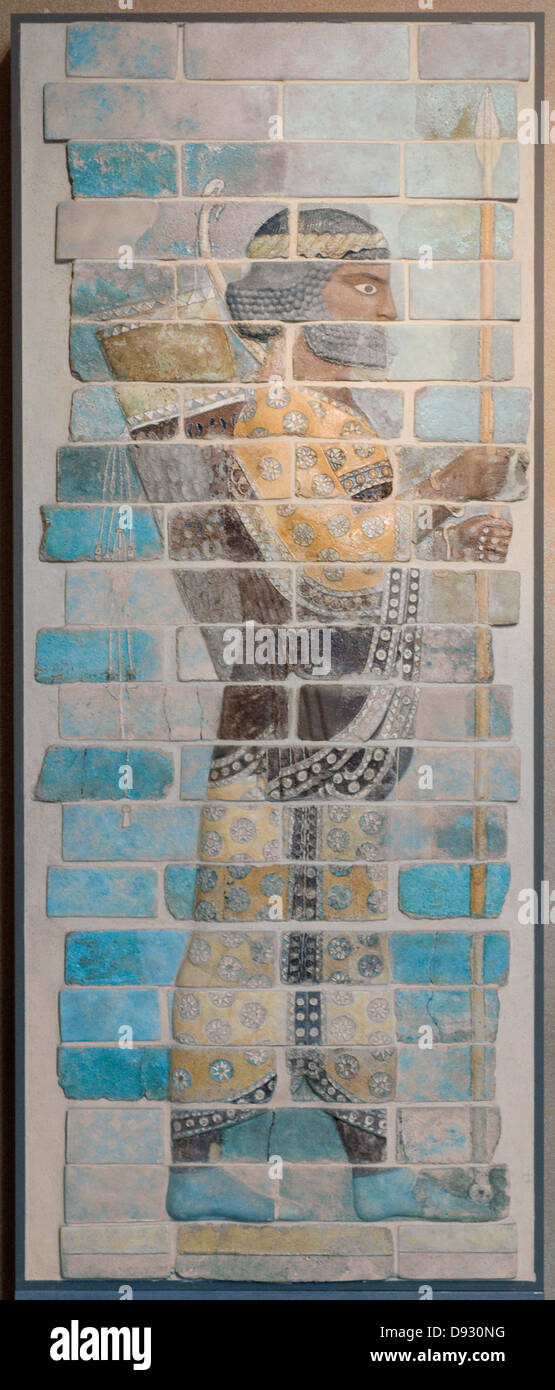 Archers (retail), frieze of archers Achaemenid period, reign of Darius the first 510 before J-C Stock Photohttps://www.alamy.com/image-license-details/?v=1https://www.alamy.com/stock-photo-archers-retail-frieze-of-archers-achaemenid-period-reign-of-darius-57229468.html
Archers (retail), frieze of archers Achaemenid period, reign of Darius the first 510 before J-C Stock Photohttps://www.alamy.com/image-license-details/?v=1https://www.alamy.com/stock-photo-archers-retail-frieze-of-archers-achaemenid-period-reign-of-darius-57229468.htmlRMD930NG–Archers (retail), frieze of archers Achaemenid period, reign of Darius the first 510 before J-C
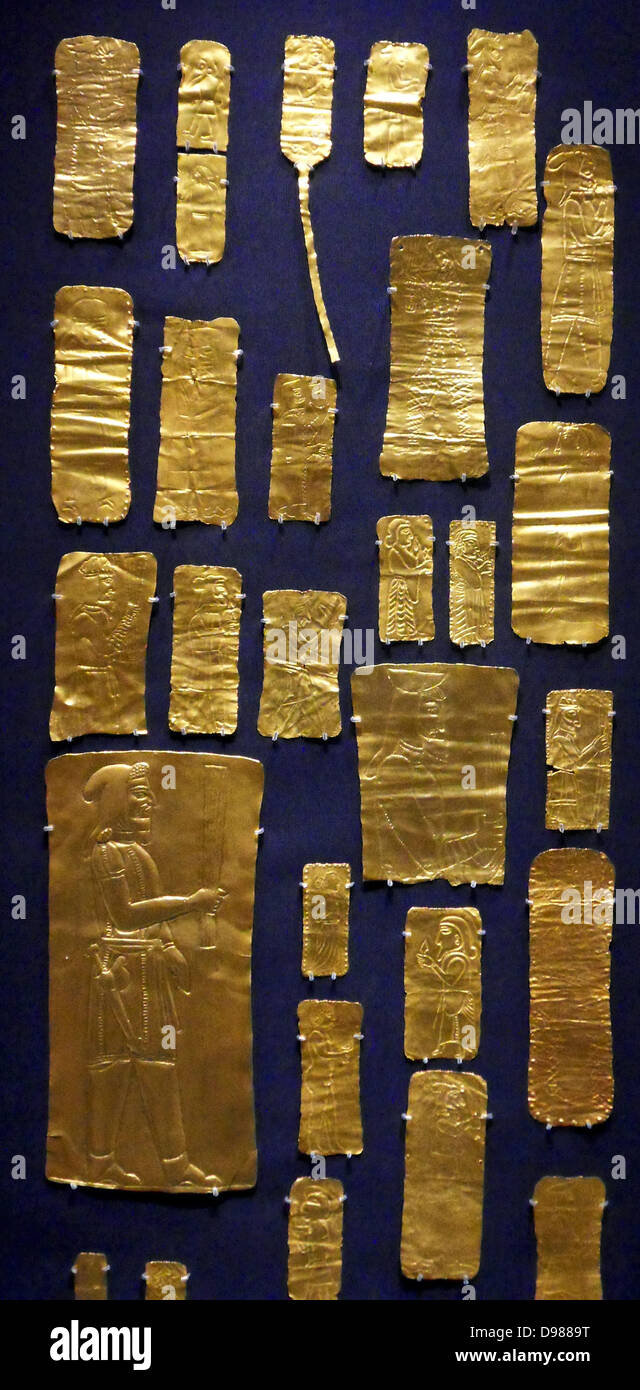 Gold plaque from the Oxus treasure. From Tadjikistan. A Mede involved in a religious ritual. This embossed ornament is part of the Oxus treasure, the most important collection of silver and gold to have survived from the Achaemenid period. The treasure is from a temple and dates mainly from the fifth and fourth centuries BC. Stock Photohttps://www.alamy.com/image-license-details/?v=1https://www.alamy.com/stock-photo-gold-plaque-from-the-oxus-treasure-from-tadjikistan-a-mede-involved-57345172.html
Gold plaque from the Oxus treasure. From Tadjikistan. A Mede involved in a religious ritual. This embossed ornament is part of the Oxus treasure, the most important collection of silver and gold to have survived from the Achaemenid period. The treasure is from a temple and dates mainly from the fifth and fourth centuries BC. Stock Photohttps://www.alamy.com/image-license-details/?v=1https://www.alamy.com/stock-photo-gold-plaque-from-the-oxus-treasure-from-tadjikistan-a-mede-involved-57345172.htmlRMD9889T–Gold plaque from the Oxus treasure. From Tadjikistan. A Mede involved in a religious ritual. This embossed ornament is part of the Oxus treasure, the most important collection of silver and gold to have survived from the Achaemenid period. The treasure is from a temple and dates mainly from the fifth and fourth centuries BC.
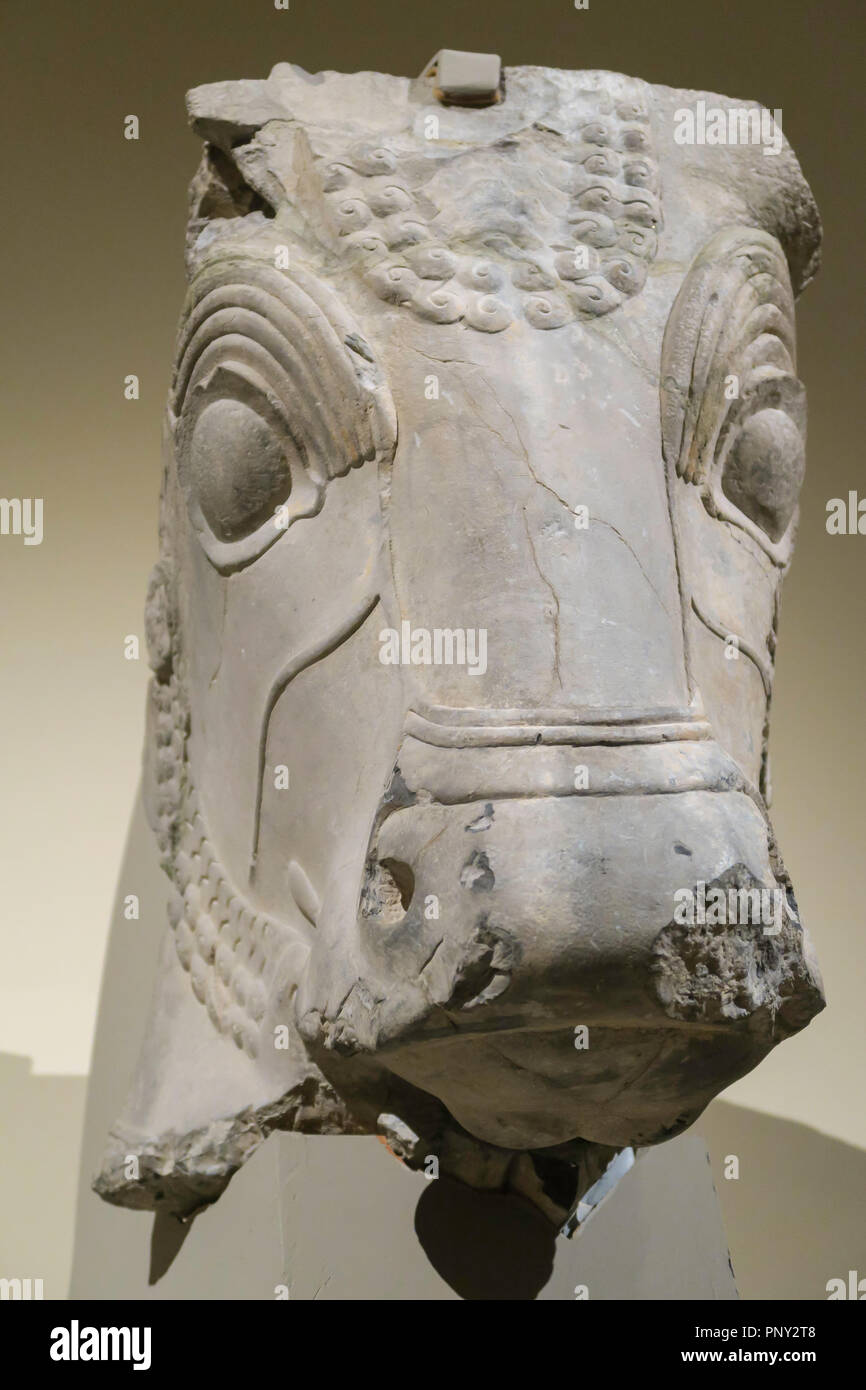 Later South Asian Galleries in the Metropolitan Museum of Art, NYC, USA Stock Photohttps://www.alamy.com/image-license-details/?v=1https://www.alamy.com/later-south-asian-galleries-in-the-metropolitan-museum-of-art-nyc-usa-image220027144.html
Later South Asian Galleries in the Metropolitan Museum of Art, NYC, USA Stock Photohttps://www.alamy.com/image-license-details/?v=1https://www.alamy.com/later-south-asian-galleries-in-the-metropolitan-museum-of-art-nyc-usa-image220027144.htmlRMPNY2T8–Later South Asian Galleries in the Metropolitan Museum of Art, NYC, USA
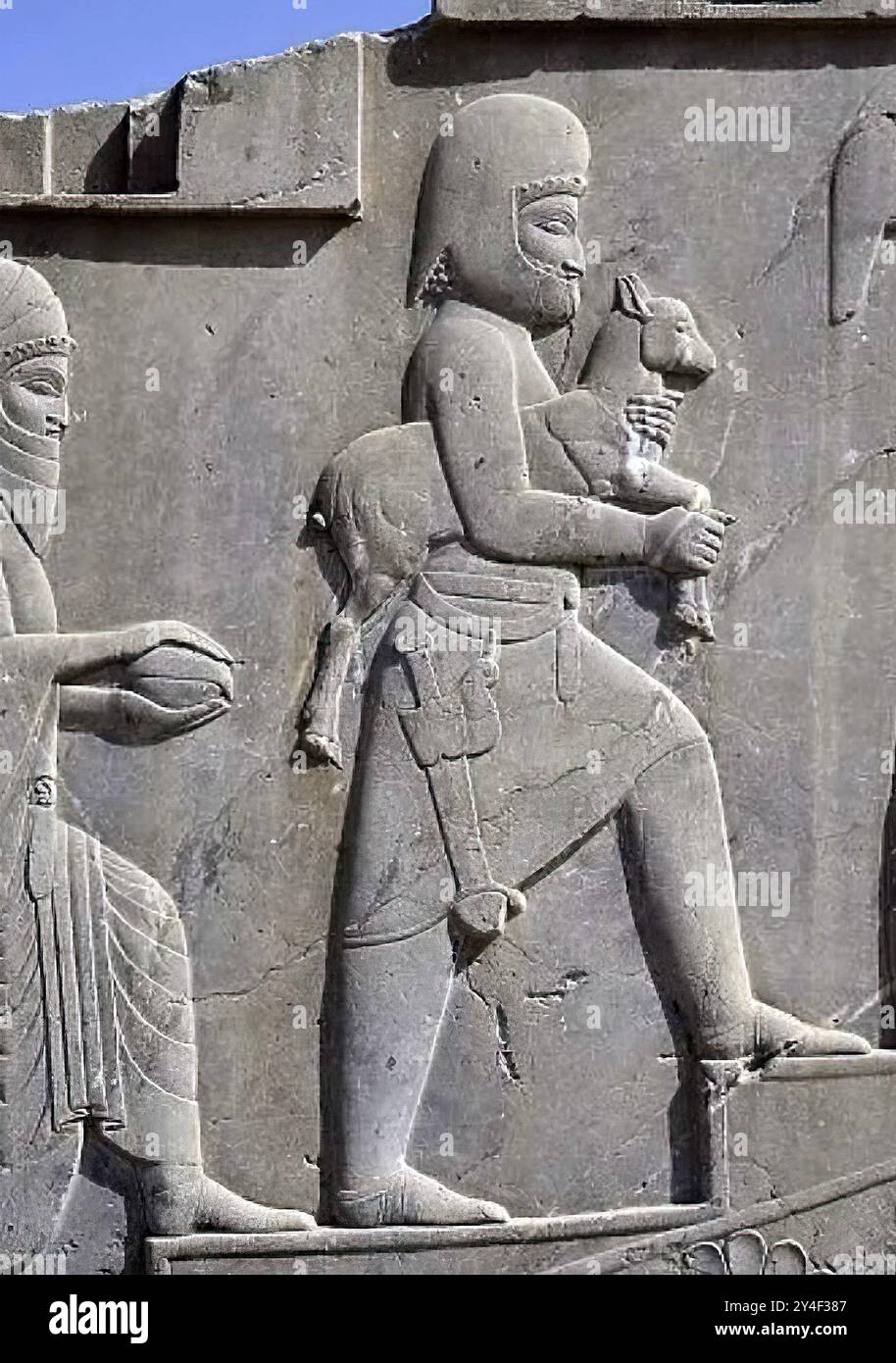 7341. Persepolis, King Darius’, Wall carving of tribute bearers. Achaemenid period, c. 5th. C BC. Stock Photohttps://www.alamy.com/image-license-details/?v=1https://www.alamy.com/7341-persepolis-king-darius-wall-carving-of-tribute-bearers-achaemenid-period-c-5th-c-bc-image622363735.html
7341. Persepolis, King Darius’, Wall carving of tribute bearers. Achaemenid period, c. 5th. C BC. Stock Photohttps://www.alamy.com/image-license-details/?v=1https://www.alamy.com/7341-persepolis-king-darius-wall-carving-of-tribute-bearers-achaemenid-period-c-5th-c-bc-image622363735.htmlRF2Y4F387–7341. Persepolis, King Darius’, Wall carving of tribute bearers. Achaemenid period, c. 5th. C BC.
 Bracelet. Iran, Achaemenid period (550-330 B.C.). Jewelry and Adornments; bracelets. Silver Stock Photohttps://www.alamy.com/image-license-details/?v=1https://www.alamy.com/bracelet-iran-achaemenid-period-550-330-bc-jewelry-and-adornments-bracelets-silver-image464698791.html
Bracelet. Iran, Achaemenid period (550-330 B.C.). Jewelry and Adornments; bracelets. Silver Stock Photohttps://www.alamy.com/image-license-details/?v=1https://www.alamy.com/bracelet-iran-achaemenid-period-550-330-bc-jewelry-and-adornments-bracelets-silver-image464698791.htmlRM2J00T1B–Bracelet. Iran, Achaemenid period (550-330 B.C.). Jewelry and Adornments; bracelets. Silver
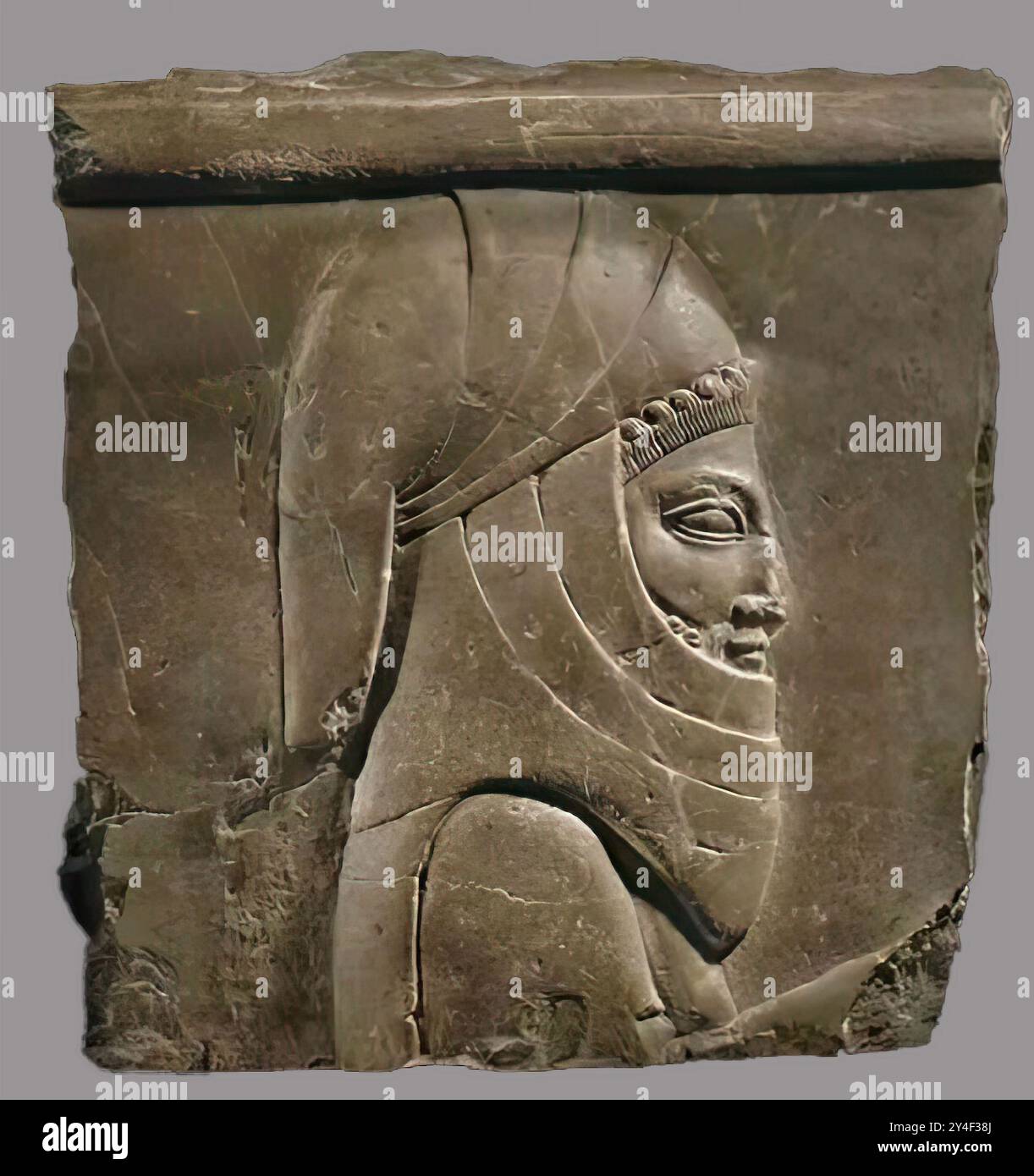 7341. Persepolis, King Darius’, Wall carving, head of tribute bearer. Achaemenid period, c. 5th. C BC. Stock Photohttps://www.alamy.com/image-license-details/?v=1https://www.alamy.com/7341-persepolis-king-darius-wall-carving-head-of-tribute-bearer-achaemenid-period-c-5th-c-bc-image622363746.html
7341. Persepolis, King Darius’, Wall carving, head of tribute bearer. Achaemenid period, c. 5th. C BC. Stock Photohttps://www.alamy.com/image-license-details/?v=1https://www.alamy.com/7341-persepolis-king-darius-wall-carving-head-of-tribute-bearer-achaemenid-period-c-5th-c-bc-image622363746.htmlRF2Y4F38J–7341. Persepolis, King Darius’, Wall carving, head of tribute bearer. Achaemenid period, c. 5th. C BC.
 Fragment of a Lion Head, Achaemenid period (550-330 BC). Stock Photohttps://www.alamy.com/image-license-details/?v=1https://www.alamy.com/fragment-of-a-lion-head-achaemenid-period-550-330-bc-image568866527.html
Fragment of a Lion Head, Achaemenid period (550-330 BC). Stock Photohttps://www.alamy.com/image-license-details/?v=1https://www.alamy.com/fragment-of-a-lion-head-achaemenid-period-550-330-bc-image568866527.htmlRM2T1E31K–Fragment of a Lion Head, Achaemenid period (550-330 BC).
 Deer carrier climbing a ladder 5th century BC Achaemenid period, Persepolis, Limestone. ( Persepolis was the ceremonial capital of the Achaemenid Empire (ca. 550–330 BC). It is situated 60 km northeast of the city of Shiraz in Fars Province, Iran. ) Stock Photohttps://www.alamy.com/image-license-details/?v=1https://www.alamy.com/deer-carrier-climbing-a-ladder-5th-century-bc-achaemenid-period-persepolis-limestone-persepolis-was-the-ceremonial-capital-of-the-achaemenid-empire-ca-550330-bc-it-is-situated-60-km-northeast-of-the-city-of-shiraz-in-fars-province-iran-image329675385.html
Deer carrier climbing a ladder 5th century BC Achaemenid period, Persepolis, Limestone. ( Persepolis was the ceremonial capital of the Achaemenid Empire (ca. 550–330 BC). It is situated 60 km northeast of the city of Shiraz in Fars Province, Iran. ) Stock Photohttps://www.alamy.com/image-license-details/?v=1https://www.alamy.com/deer-carrier-climbing-a-ladder-5th-century-bc-achaemenid-period-persepolis-limestone-persepolis-was-the-ceremonial-capital-of-the-achaemenid-empire-ca-550330-bc-it-is-situated-60-km-northeast-of-the-city-of-shiraz-in-fars-province-iran-image329675385.htmlRM2A4A08W–Deer carrier climbing a ladder 5th century BC Achaemenid period, Persepolis, Limestone. ( Persepolis was the ceremonial capital of the Achaemenid Empire (ca. 550–330 BC). It is situated 60 km northeast of the city of Shiraz in Fars Province, Iran. )
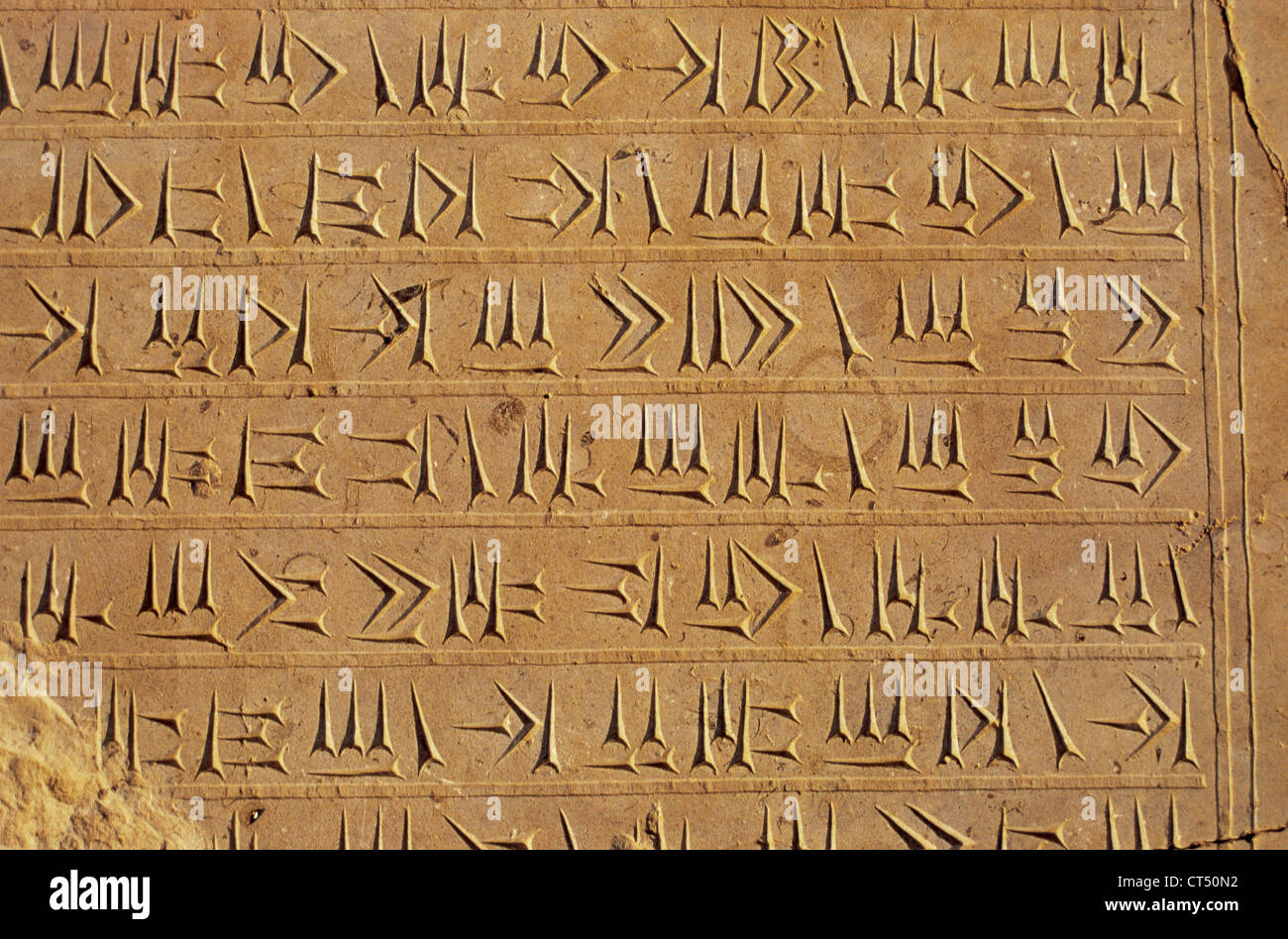 Persian Empire. Achaemenid period. Cuneiform writing on the wall of the Palace of Persepolis. Stock Photohttps://www.alamy.com/image-license-details/?v=1https://www.alamy.com/stock-photo-persian-empire-achaemenid-period-cuneiform-writing-on-the-wall-of-49282830.html
Persian Empire. Achaemenid period. Cuneiform writing on the wall of the Palace of Persepolis. Stock Photohttps://www.alamy.com/image-license-details/?v=1https://www.alamy.com/stock-photo-persian-empire-achaemenid-period-cuneiform-writing-on-the-wall-of-49282830.htmlRMCT50N2–Persian Empire. Achaemenid period. Cuneiform writing on the wall of the Palace of Persepolis.
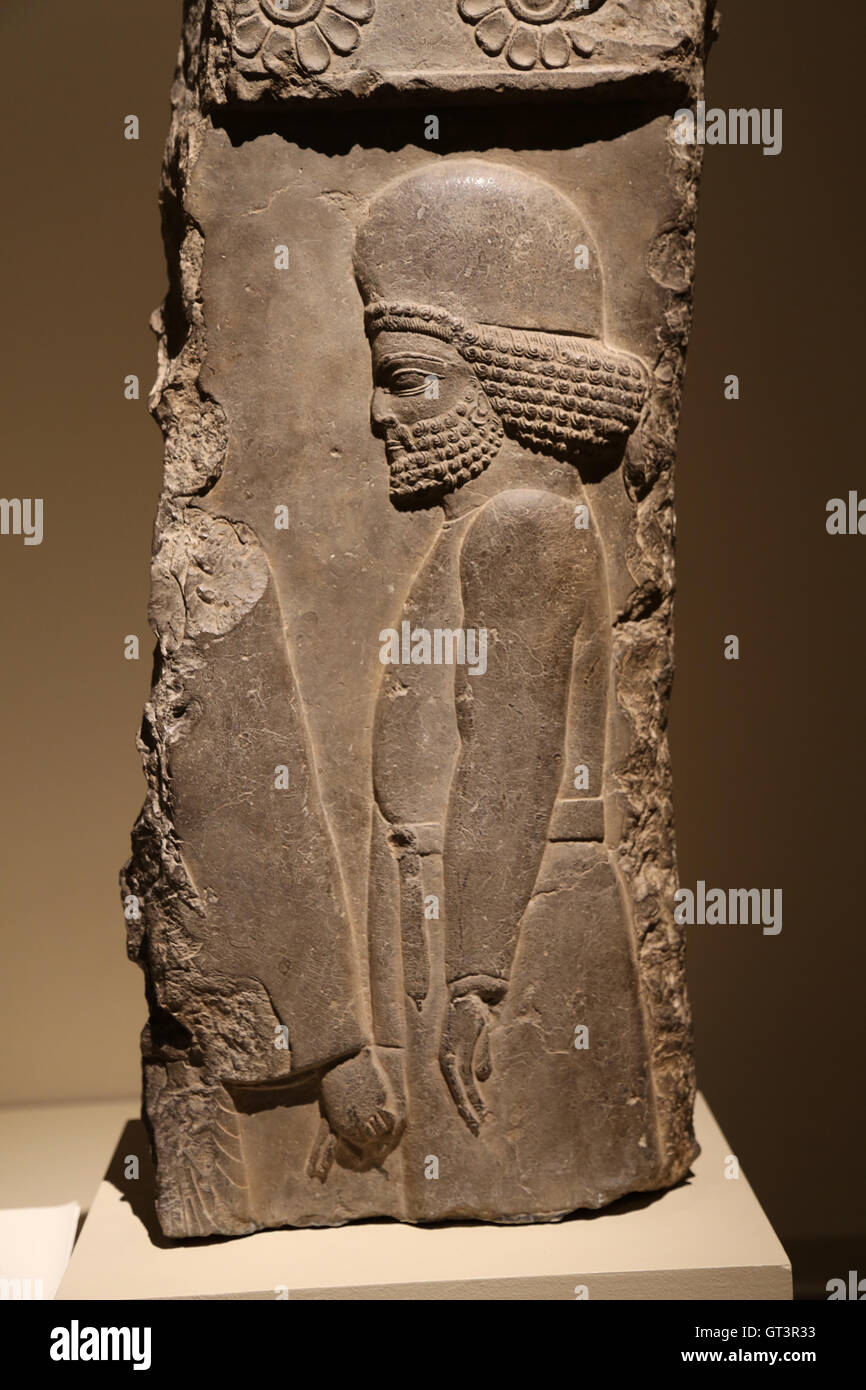 Achaemenid period. Reign of Artaxerxes II, 405-360 B.C. Figure in a procession. Palace of Darius I. Persepolis. Iran. Stock Photohttps://www.alamy.com/image-license-details/?v=1https://www.alamy.com/stock-photo-achaemenid-period-reign-of-artaxerxes-ii-405-360-bc-figure-in-a-procession-118097927.html
Achaemenid period. Reign of Artaxerxes II, 405-360 B.C. Figure in a procession. Palace of Darius I. Persepolis. Iran. Stock Photohttps://www.alamy.com/image-license-details/?v=1https://www.alamy.com/stock-photo-achaemenid-period-reign-of-artaxerxes-ii-405-360-bc-figure-in-a-procession-118097927.htmlRMGT3R33–Achaemenid period. Reign of Artaxerxes II, 405-360 B.C. Figure in a procession. Palace of Darius I. Persepolis. Iran.
 Achaemenid period. 5th century BC. Legendary creature with human head and bull body. Possibly it was part of a capital. From Persepolis. National Museum of Iran. Tehran, Islamic Republic of Iran. Stock Photohttps://www.alamy.com/image-license-details/?v=1https://www.alamy.com/achaemenid-period-5th-century-bc-legendary-creature-with-human-head-and-bull-body-possibly-it-was-part-of-a-capital-from-persepolis-national-museum-of-iran-tehran-islamic-republic-of-iran-image222666200.html
Achaemenid period. 5th century BC. Legendary creature with human head and bull body. Possibly it was part of a capital. From Persepolis. National Museum of Iran. Tehran, Islamic Republic of Iran. Stock Photohttps://www.alamy.com/image-license-details/?v=1https://www.alamy.com/achaemenid-period-5th-century-bc-legendary-creature-with-human-head-and-bull-body-possibly-it-was-part-of-a-capital-from-persepolis-national-museum-of-iran-tehran-islamic-republic-of-iran-image222666200.htmlRMPX7908–Achaemenid period. 5th century BC. Legendary creature with human head and bull body. Possibly it was part of a capital. From Persepolis. National Museum of Iran. Tehran, Islamic Republic of Iran.
 Achaemenid period. Sealed contract, dated from the reign of Alexander the Great. Uruk, Iraq. Reign of Alexander the Great, year Stock Photohttps://www.alamy.com/image-license-details/?v=1https://www.alamy.com/stock-photo-achaemenid-period-sealed-contract-dated-from-the-reign-of-alexander-89913721.html
Achaemenid period. Sealed contract, dated from the reign of Alexander the Great. Uruk, Iraq. Reign of Alexander the Great, year Stock Photohttps://www.alamy.com/image-license-details/?v=1https://www.alamy.com/stock-photo-achaemenid-period-sealed-contract-dated-from-the-reign-of-alexander-89913721.htmlRMF67WT9–Achaemenid period. Sealed contract, dated from the reign of Alexander the Great. Uruk, Iraq. Reign of Alexander the Great, year
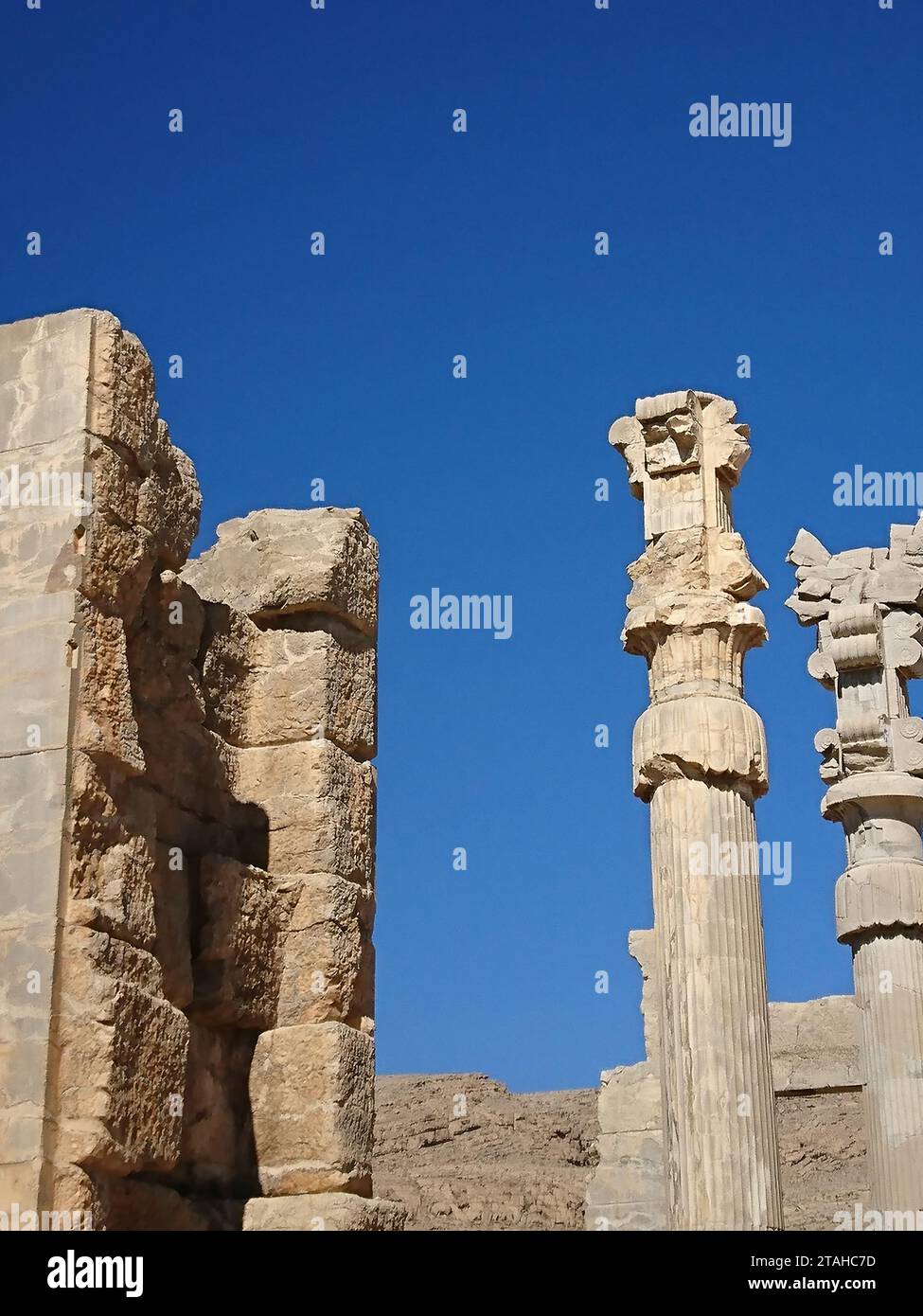 Hieroglyphs carved on the wall of an ancient temple. Remains of Persepolis. Achaemenid period. Antiquities before Christ Stock Photohttps://www.alamy.com/image-license-details/?v=1https://www.alamy.com/hieroglyphs-carved-on-the-wall-of-an-ancient-temple-remains-of-persepolis-achaemenid-period-antiquities-before-christ-image574471505.html
Hieroglyphs carved on the wall of an ancient temple. Remains of Persepolis. Achaemenid period. Antiquities before Christ Stock Photohttps://www.alamy.com/image-license-details/?v=1https://www.alamy.com/hieroglyphs-carved-on-the-wall-of-an-ancient-temple-remains-of-persepolis-achaemenid-period-antiquities-before-christ-image574471505.htmlRF2TAHC7D–Hieroglyphs carved on the wall of an ancient temple. Remains of Persepolis. Achaemenid period. Antiquities before Christ
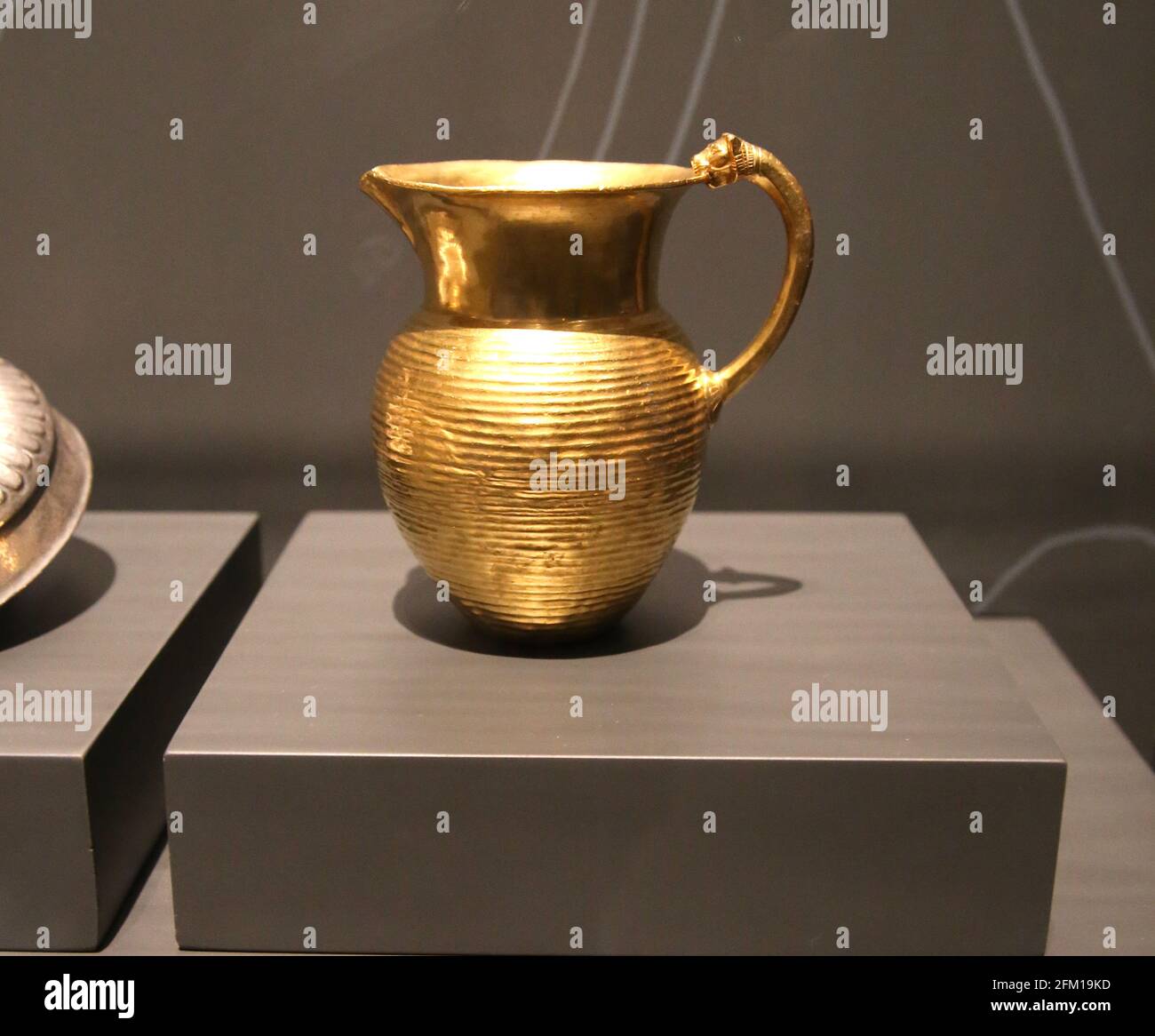 Achaemenid period. Oxus Treasure. 500-300 BC. The jug. Golden. Takht-i Kuwad. Tajikistan. British Museum. United Kingdom Stock Photohttps://www.alamy.com/image-license-details/?v=1https://www.alamy.com/achaemenid-period-oxus-treasure-500-300-bc-the-jug-golden-takht-i-kuwad-tajikistan-british-museum-united-kingdom-image425371505.html
Achaemenid period. Oxus Treasure. 500-300 BC. The jug. Golden. Takht-i Kuwad. Tajikistan. British Museum. United Kingdom Stock Photohttps://www.alamy.com/image-license-details/?v=1https://www.alamy.com/achaemenid-period-oxus-treasure-500-300-bc-the-jug-golden-takht-i-kuwad-tajikistan-british-museum-united-kingdom-image425371505.htmlRM2FM19KD–Achaemenid period. Oxus Treasure. 500-300 BC. The jug. Golden. Takht-i Kuwad. Tajikistan. British Museum. United Kingdom
 Stone relief with lions from Persepolis, Achaemenid period, National Museum, Tehran, Tehran, Iran Stock Photohttps://www.alamy.com/image-license-details/?v=1https://www.alamy.com/stone-relief-with-lions-from-persepolis-achaemenid-period-national-museum-tehran-tehran-iran-image457545681.html
Stone relief with lions from Persepolis, Achaemenid period, National Museum, Tehran, Tehran, Iran Stock Photohttps://www.alamy.com/image-license-details/?v=1https://www.alamy.com/stone-relief-with-lions-from-persepolis-achaemenid-period-national-museum-tehran-tehran-iran-image457545681.htmlRM2HGB055–Stone relief with lions from Persepolis, Achaemenid period, National Museum, Tehran, Tehran, Iran
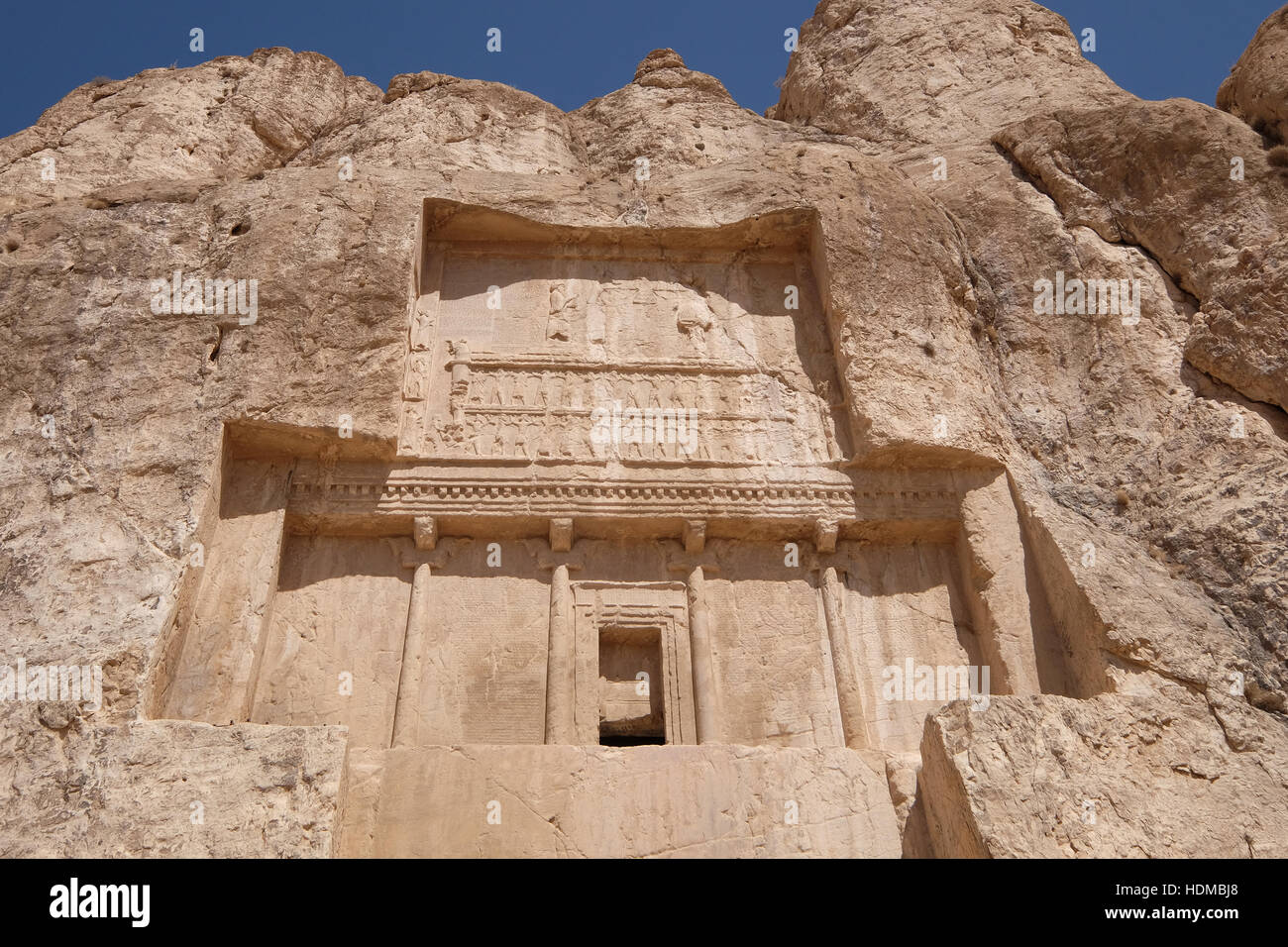 Naqsh-e Rustam is an ancient site consisting of colossal tombs of Persian Kings. It's located in Fars Province in Iran. Stock Photohttps://www.alamy.com/image-license-details/?v=1https://www.alamy.com/stock-photo-naqsh-e-rustam-is-an-ancient-site-consisting-of-colossal-tombs-of-128911280.html
Naqsh-e Rustam is an ancient site consisting of colossal tombs of Persian Kings. It's located in Fars Province in Iran. Stock Photohttps://www.alamy.com/image-license-details/?v=1https://www.alamy.com/stock-photo-naqsh-e-rustam-is-an-ancient-site-consisting-of-colossal-tombs-of-128911280.htmlRFHDMBJ8–Naqsh-e Rustam is an ancient site consisting of colossal tombs of Persian Kings. It's located in Fars Province in Iran.
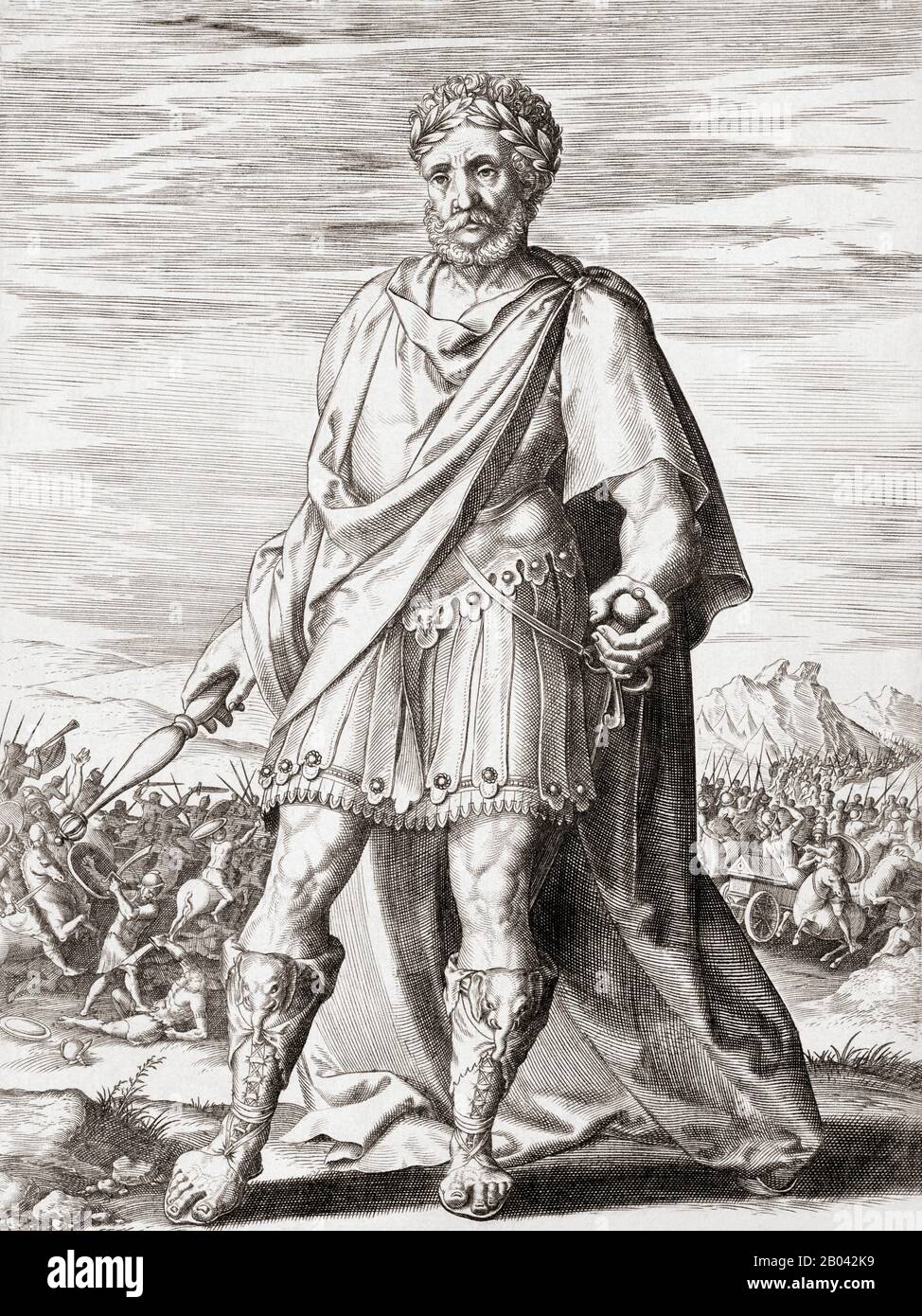 King Darius III of Persia, c. 380 -330 BC. Last king of the Achaemenid Empire of Persia. Stock Photohttps://www.alamy.com/image-license-details/?v=1https://www.alamy.com/king-darius-iii-of-persia-c-380-330-bc-last-king-of-the-achaemenid-empire-of-persia-image344297277.html
King Darius III of Persia, c. 380 -330 BC. Last king of the Achaemenid Empire of Persia. Stock Photohttps://www.alamy.com/image-license-details/?v=1https://www.alamy.com/king-darius-iii-of-persia-c-380-330-bc-last-king-of-the-achaemenid-empire-of-persia-image344297277.htmlRM2B042K9–King Darius III of Persia, c. 380 -330 BC. Last king of the Achaemenid Empire of Persia.
 Art inspired by Vessel terminating in the forepart of a fantastic leonine creature, Achaemenid, ca. 5th century B.C., Iran, Achaemenid, Gold, H. 17 cm, Metalwork-Vessels, Horn-shaped vessels ending in an animal's head have a long history in the Near East as well as in Greece and Italy, Classic works modernized by Artotop with a splash of modernity. Shapes, color and value, eye-catching visual impact on art. Emotions through freedom of artworks in a contemporary way. A timeless message pursuing a wildly creative new direction. Artists turning to the digital medium and creating the Artotop NFT Stock Photohttps://www.alamy.com/image-license-details/?v=1https://www.alamy.com/art-inspired-by-vessel-terminating-in-the-forepart-of-a-fantastic-leonine-creature-achaemenid-ca-5th-century-bc-iran-achaemenid-gold-h-17-cm-metalwork-vessels-horn-shaped-vessels-ending-in-an-animals-head-have-a-long-history-in-the-near-east-as-well-as-in-greece-and-italy-classic-works-modernized-by-artotop-with-a-splash-of-modernity-shapes-color-and-value-eye-catching-visual-impact-on-art-emotions-through-freedom-of-artworks-in-a-contemporary-way-a-timeless-message-pursuing-a-wildly-creative-new-direction-artists-turning-to-the-digital-medium-and-creating-the-artotop-nft-image462944658.html
Art inspired by Vessel terminating in the forepart of a fantastic leonine creature, Achaemenid, ca. 5th century B.C., Iran, Achaemenid, Gold, H. 17 cm, Metalwork-Vessels, Horn-shaped vessels ending in an animal's head have a long history in the Near East as well as in Greece and Italy, Classic works modernized by Artotop with a splash of modernity. Shapes, color and value, eye-catching visual impact on art. Emotions through freedom of artworks in a contemporary way. A timeless message pursuing a wildly creative new direction. Artists turning to the digital medium and creating the Artotop NFT Stock Photohttps://www.alamy.com/image-license-details/?v=1https://www.alamy.com/art-inspired-by-vessel-terminating-in-the-forepart-of-a-fantastic-leonine-creature-achaemenid-ca-5th-century-bc-iran-achaemenid-gold-h-17-cm-metalwork-vessels-horn-shaped-vessels-ending-in-an-animals-head-have-a-long-history-in-the-near-east-as-well-as-in-greece-and-italy-classic-works-modernized-by-artotop-with-a-splash-of-modernity-shapes-color-and-value-eye-catching-visual-impact-on-art-emotions-through-freedom-of-artworks-in-a-contemporary-way-a-timeless-message-pursuing-a-wildly-creative-new-direction-artists-turning-to-the-digital-medium-and-creating-the-artotop-nft-image462944658.htmlRF2HW4XHP–Art inspired by Vessel terminating in the forepart of a fantastic leonine creature, Achaemenid, ca. 5th century B.C., Iran, Achaemenid, Gold, H. 17 cm, Metalwork-Vessels, Horn-shaped vessels ending in an animal's head have a long history in the Near East as well as in Greece and Italy, Classic works modernized by Artotop with a splash of modernity. Shapes, color and value, eye-catching visual impact on art. Emotions through freedom of artworks in a contemporary way. A timeless message pursuing a wildly creative new direction. Artists turning to the digital medium and creating the Artotop NFT
 A phalanx of Alexander the Great's Macedonian troops in combat with the Persian forces of the Achaemenid Empire. Stock Photohttps://www.alamy.com/image-license-details/?v=1https://www.alamy.com/a-phalanx-of-alexander-the-greats-macedonian-troops-in-combat-with-the-persian-forces-of-the-achaemenid-empire-image450139353.html
A phalanx of Alexander the Great's Macedonian troops in combat with the Persian forces of the Achaemenid Empire. Stock Photohttps://www.alamy.com/image-license-details/?v=1https://www.alamy.com/a-phalanx-of-alexander-the-greats-macedonian-troops-in-combat-with-the-persian-forces-of-the-achaemenid-empire-image450139353.htmlRM2H49H9D–A phalanx of Alexander the Great's Macedonian troops in combat with the Persian forces of the Achaemenid Empire.
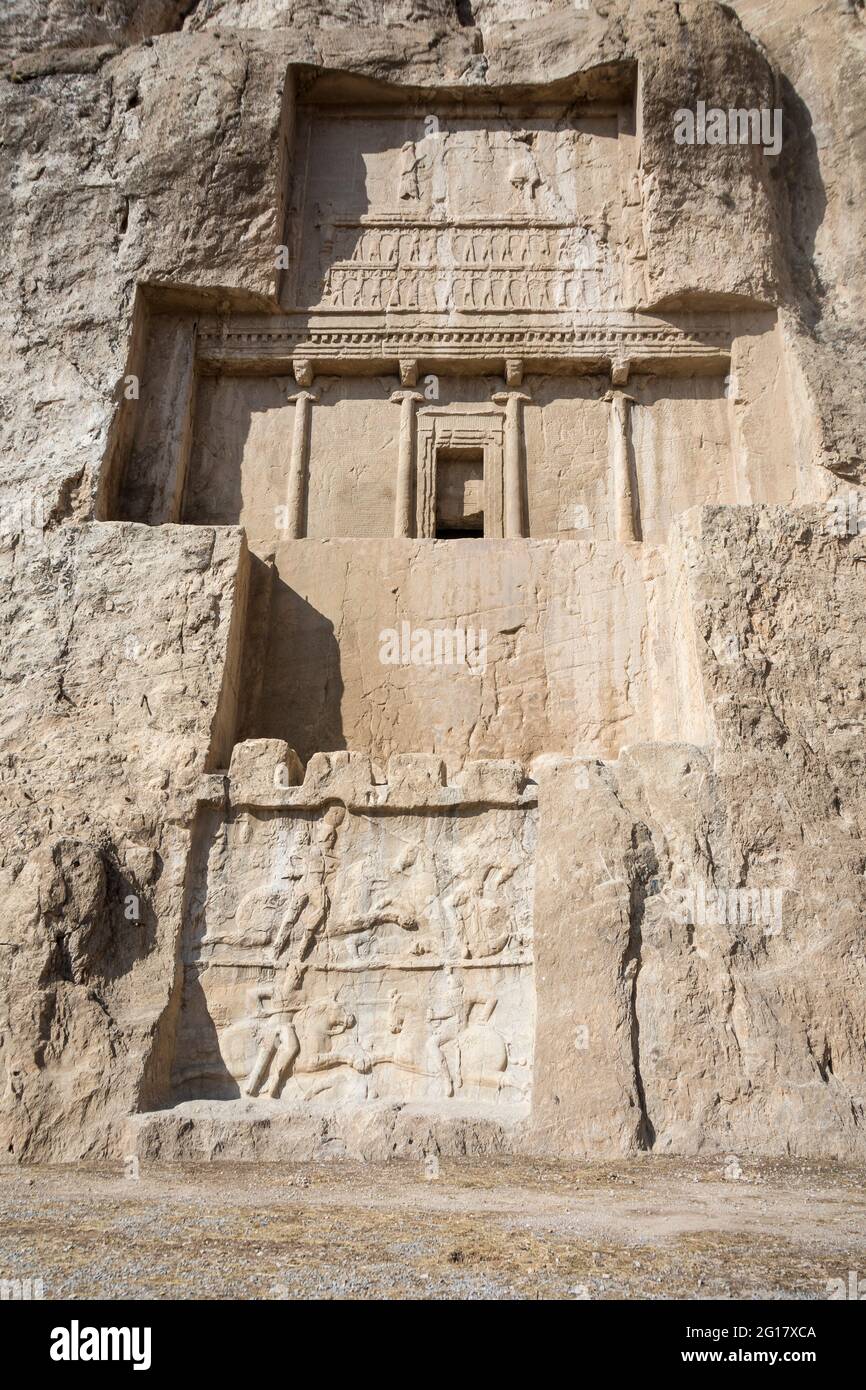 Naqsh-e Rostam,necropolis of the Achaemenid dynasty near Persepolis, with tomb of Darius I,cut high into the cliff face. Iran. Stock Photohttps://www.alamy.com/image-license-details/?v=1https://www.alamy.com/naqsh-e-rostamnecropolis-of-the-achaemenid-dynasty-near-persepolis-with-tomb-of-darius-icut-high-into-the-cliff-face-iran-image431048250.html
Naqsh-e Rostam,necropolis of the Achaemenid dynasty near Persepolis, with tomb of Darius I,cut high into the cliff face. Iran. Stock Photohttps://www.alamy.com/image-license-details/?v=1https://www.alamy.com/naqsh-e-rostamnecropolis-of-the-achaemenid-dynasty-near-persepolis-with-tomb-of-darius-icut-high-into-the-cliff-face-iran-image431048250.htmlRF2G17XCA–Naqsh-e Rostam,necropolis of the Achaemenid dynasty near Persepolis, with tomb of Darius I,cut high into the cliff face. Iran.
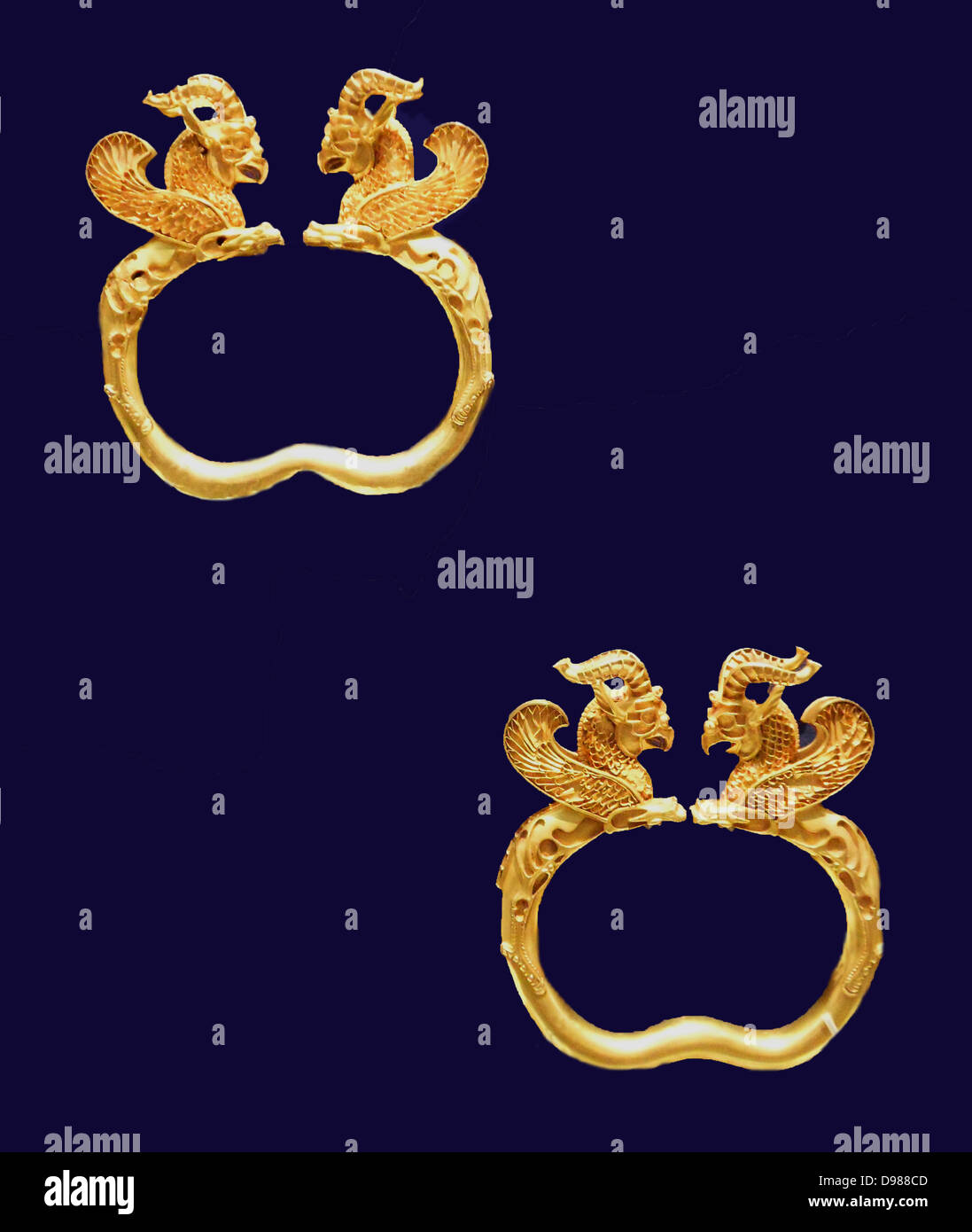 Gold griffin-headed armlet from the Oxus treasureAchaemenid Persian, 5th-4th century BC. From the region of Takht-i Kuwad, Tadjikistan. This gold bracelet is part of the Oxus treasure, the most important collection of gold and silver to have survived from the Achaemenid period. There is a companion piece in the Victoria and Albert Museum. The bracelets are similar to objects being brought as tribute on reliefs at the Persian centre of Persepolis. Stock Photohttps://www.alamy.com/image-license-details/?v=1https://www.alamy.com/stock-photo-gold-griffin-headed-armlet-from-the-oxus-treasureachaemenid-persian-57345245.html
Gold griffin-headed armlet from the Oxus treasureAchaemenid Persian, 5th-4th century BC. From the region of Takht-i Kuwad, Tadjikistan. This gold bracelet is part of the Oxus treasure, the most important collection of gold and silver to have survived from the Achaemenid period. There is a companion piece in the Victoria and Albert Museum. The bracelets are similar to objects being brought as tribute on reliefs at the Persian centre of Persepolis. Stock Photohttps://www.alamy.com/image-license-details/?v=1https://www.alamy.com/stock-photo-gold-griffin-headed-armlet-from-the-oxus-treasureachaemenid-persian-57345245.htmlRMD988CD–Gold griffin-headed armlet from the Oxus treasureAchaemenid Persian, 5th-4th century BC. From the region of Takht-i Kuwad, Tadjikistan. This gold bracelet is part of the Oxus treasure, the most important collection of gold and silver to have survived from the Achaemenid period. There is a companion piece in the Victoria and Albert Museum. The bracelets are similar to objects being brought as tribute on reliefs at the Persian centre of Persepolis.
 The capture of Babylon by Cyrus the Great, ruler of the Achaemenid Empire, in 539 BC. The event ended the Neo-Babylonian Empire. After a 19th century work by an unidentified artist. Stock Photohttps://www.alamy.com/image-license-details/?v=1https://www.alamy.com/the-capture-of-babylon-by-cyrus-the-great-ruler-of-the-achaemenid-empire-in-539-bc-the-event-ended-the-neo-babylonian-empire-after-a-19th-century-work-by-an-unidentified-artist-image435532241.html
The capture of Babylon by Cyrus the Great, ruler of the Achaemenid Empire, in 539 BC. The event ended the Neo-Babylonian Empire. After a 19th century work by an unidentified artist. Stock Photohttps://www.alamy.com/image-license-details/?v=1https://www.alamy.com/the-capture-of-babylon-by-cyrus-the-great-ruler-of-the-achaemenid-empire-in-539-bc-the-event-ended-the-neo-babylonian-empire-after-a-19th-century-work-by-an-unidentified-artist-image435532241.htmlRM2G8G5PW–The capture of Babylon by Cyrus the Great, ruler of the Achaemenid Empire, in 539 BC. The event ended the Neo-Babylonian Empire. After a 19th century work by an unidentified artist.
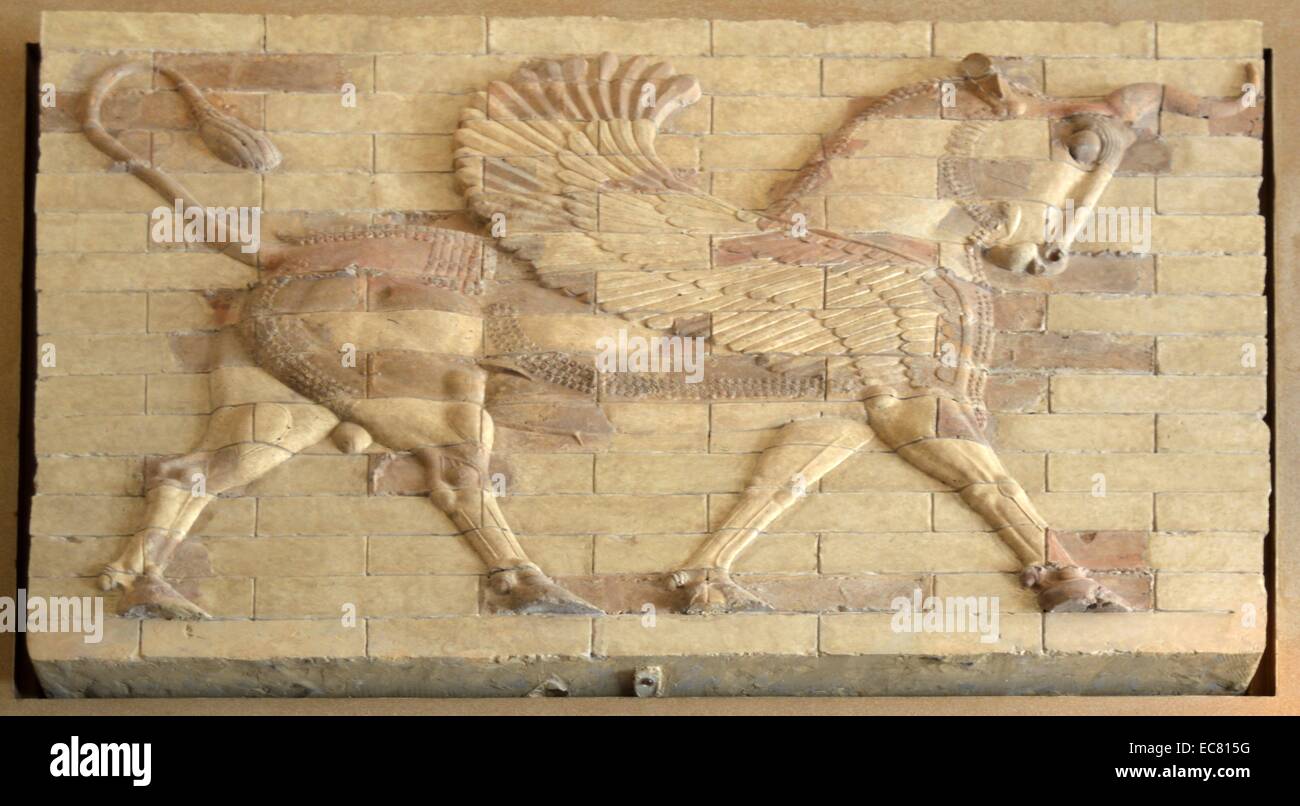 Decorative panels of moulded terracotta bricks. Achaemenid period. Palace of Darius 1st. Stock Photohttps://www.alamy.com/image-license-details/?v=1https://www.alamy.com/stock-photo-decorative-panels-of-moulded-terracotta-bricks-achaemenid-period-palace-76393900.html
Decorative panels of moulded terracotta bricks. Achaemenid period. Palace of Darius 1st. Stock Photohttps://www.alamy.com/image-license-details/?v=1https://www.alamy.com/stock-photo-decorative-panels-of-moulded-terracotta-bricks-achaemenid-period-palace-76393900.htmlRMEC815G–Decorative panels of moulded terracotta bricks. Achaemenid period. Palace of Darius 1st.
 Cylinder Seal. Iran, Achaemenid period, circa 550-330 B.C.. Tools and Equipment; seals. Marble Stock Photohttps://www.alamy.com/image-license-details/?v=1https://www.alamy.com/cylinder-seal-iran-achaemenid-period-circa-550-330-bc-tools-and-equipment-seals-marble-image464667743.html
Cylinder Seal. Iran, Achaemenid period, circa 550-330 B.C.. Tools and Equipment; seals. Marble Stock Photohttps://www.alamy.com/image-license-details/?v=1https://www.alamy.com/cylinder-seal-iran-achaemenid-period-circa-550-330-bc-tools-and-equipment-seals-marble-image464667743.htmlRM2HYYCCF–Cylinder Seal. Iran, Achaemenid period, circa 550-330 B.C.. Tools and Equipment; seals. Marble
 The Battle of Gaugamela, aka the Battle of Arbela, 331 BC, between the forces of Darius III, last king of the Achaemenid Empire of Persia, and Alexander the Great of Macedon. This was the decisive battle of Alexander the Great's invasion of the Persian Achaemenid Empire. Stock Photohttps://www.alamy.com/image-license-details/?v=1https://www.alamy.com/the-battle-of-gaugamela-aka-the-battle-of-arbela-331-bc-between-the-forces-of-darius-iii-last-king-of-the-achaemenid-empire-of-persia-and-alexander-the-great-of-macedon-this-was-the-decisive-battle-of-alexander-the-greats-invasion-of-the-persian-achaemenid-empire-image342249676.html
The Battle of Gaugamela, aka the Battle of Arbela, 331 BC, between the forces of Darius III, last king of the Achaemenid Empire of Persia, and Alexander the Great of Macedon. This was the decisive battle of Alexander the Great's invasion of the Persian Achaemenid Empire. Stock Photohttps://www.alamy.com/image-license-details/?v=1https://www.alamy.com/the-battle-of-gaugamela-aka-the-battle-of-arbela-331-bc-between-the-forces-of-darius-iii-last-king-of-the-achaemenid-empire-of-persia-and-alexander-the-great-of-macedon-this-was-the-decisive-battle-of-alexander-the-greats-invasion-of-the-persian-achaemenid-empire-image342249676.htmlRM2ATPPXM–The Battle of Gaugamela, aka the Battle of Arbela, 331 BC, between the forces of Darius III, last king of the Achaemenid Empire of Persia, and Alexander the Great of Macedon. This was the decisive battle of Alexander the Great's invasion of the Persian Achaemenid Empire.
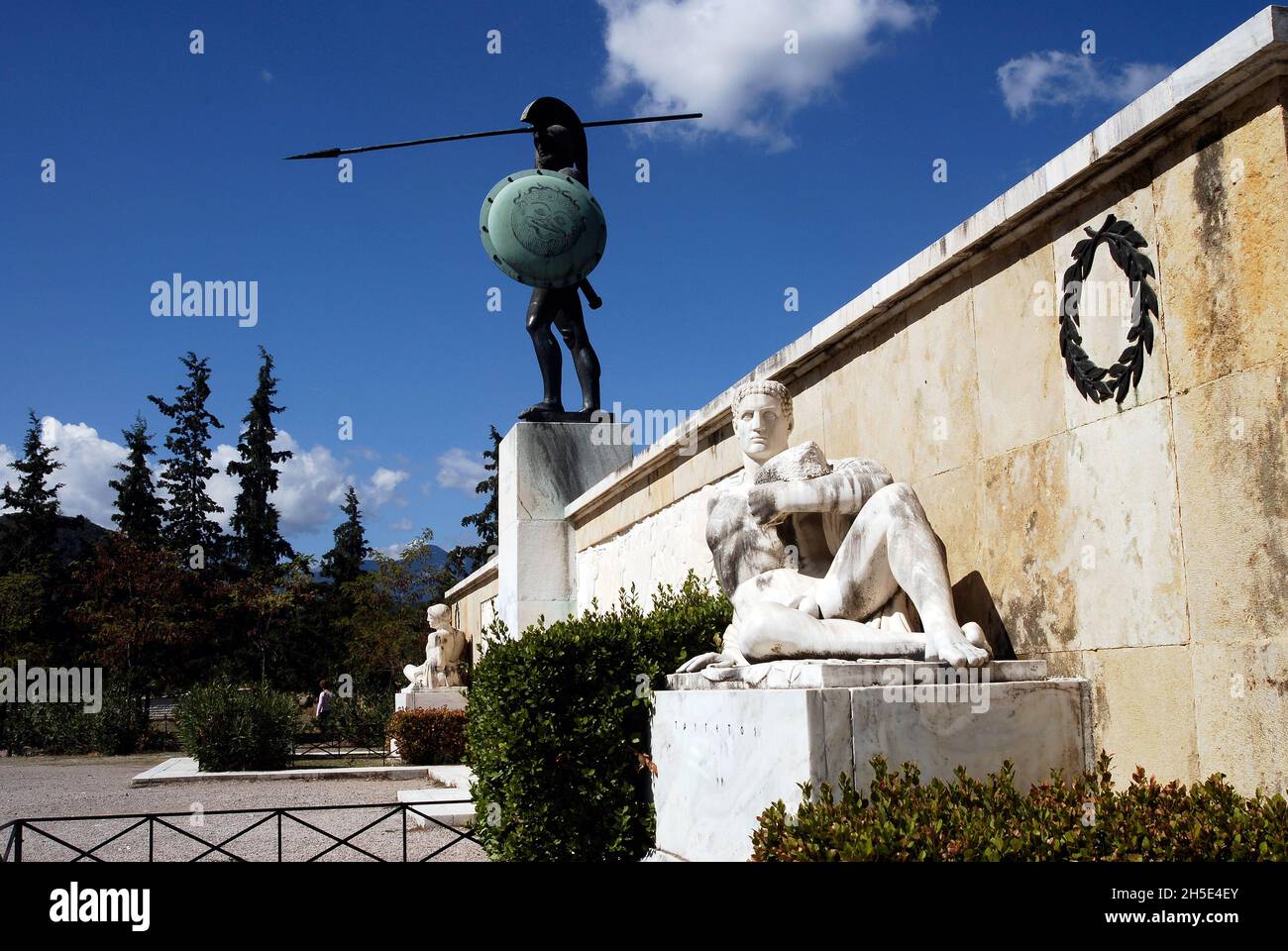 Greece Battle of Thermopylae Leonidas monument Stock Photohttps://www.alamy.com/image-license-details/?v=1https://www.alamy.com/greece-battle-of-thermopylae-leonidas-monument-image450853731.html
Greece Battle of Thermopylae Leonidas monument Stock Photohttps://www.alamy.com/image-license-details/?v=1https://www.alamy.com/greece-battle-of-thermopylae-leonidas-monument-image450853731.htmlRF2H5E4EY–Greece Battle of Thermopylae Leonidas monument
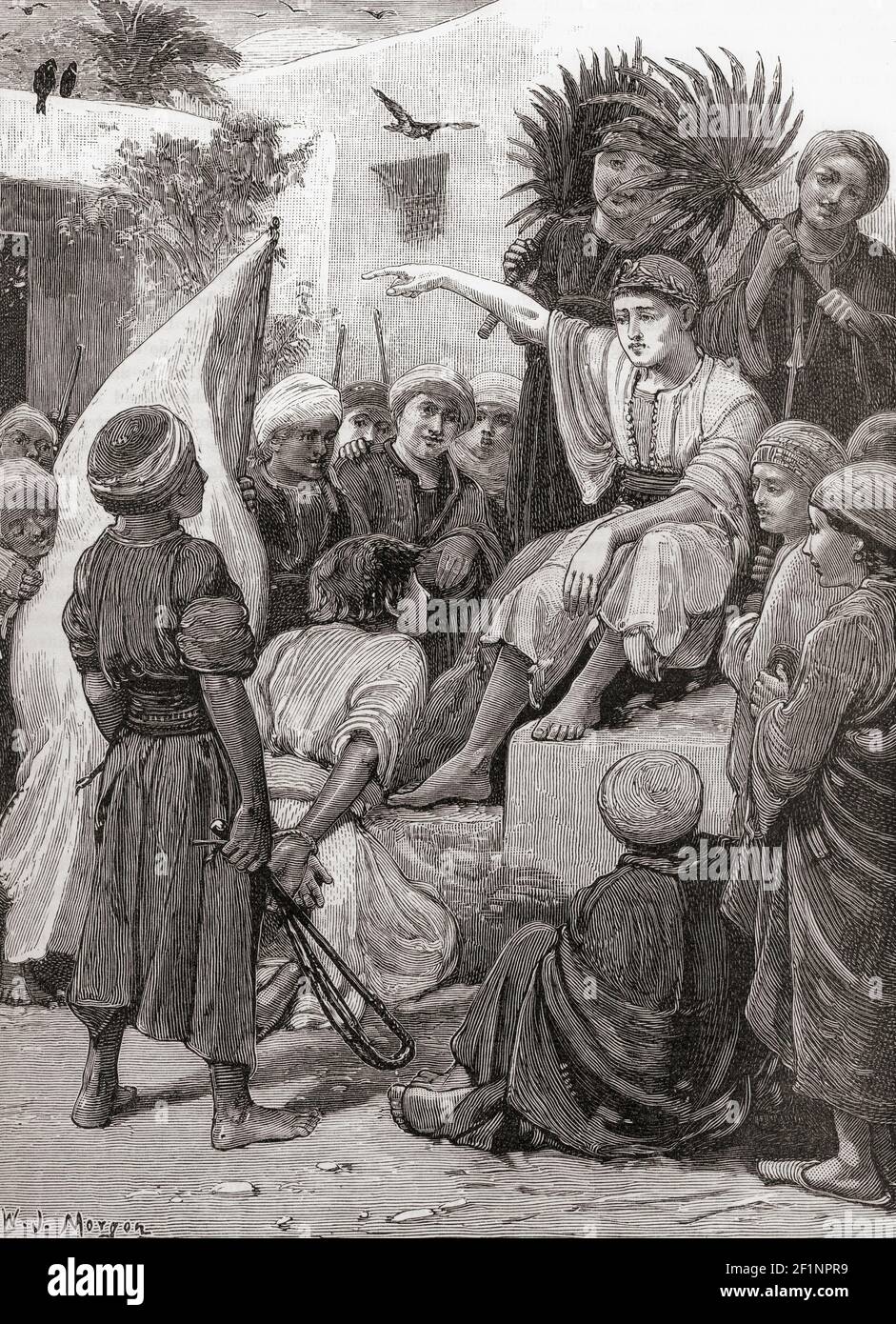 Cyrus as a young boy pretending to be king. Cyrus II of Persia, c. 600 – 530 BC, aka Cyrus the Great, and Cyrus the Elder. Founder of the Achaemenid Empire, the first Persian Empire. From Cassell's Universal History, published 1888. Stock Photohttps://www.alamy.com/image-license-details/?v=1https://www.alamy.com/cyrus-as-a-young-boy-pretending-to-be-king-cyrus-ii-of-persia-c-600-530-bc-aka-cyrus-the-great-and-cyrus-the-elder-founder-of-the-achaemenid-empire-the-first-persian-empire-from-cassells-universal-history-published-1888-image414142381.html
Cyrus as a young boy pretending to be king. Cyrus II of Persia, c. 600 – 530 BC, aka Cyrus the Great, and Cyrus the Elder. Founder of the Achaemenid Empire, the first Persian Empire. From Cassell's Universal History, published 1888. Stock Photohttps://www.alamy.com/image-license-details/?v=1https://www.alamy.com/cyrus-as-a-young-boy-pretending-to-be-king-cyrus-ii-of-persia-c-600-530-bc-aka-cyrus-the-great-and-cyrus-the-elder-founder-of-the-achaemenid-empire-the-first-persian-empire-from-cassells-universal-history-published-1888-image414142381.htmlRM2F1NPR9–Cyrus as a young boy pretending to be king. Cyrus II of Persia, c. 600 – 530 BC, aka Cyrus the Great, and Cyrus the Elder. Founder of the Achaemenid Empire, the first Persian Empire. From Cassell's Universal History, published 1888.
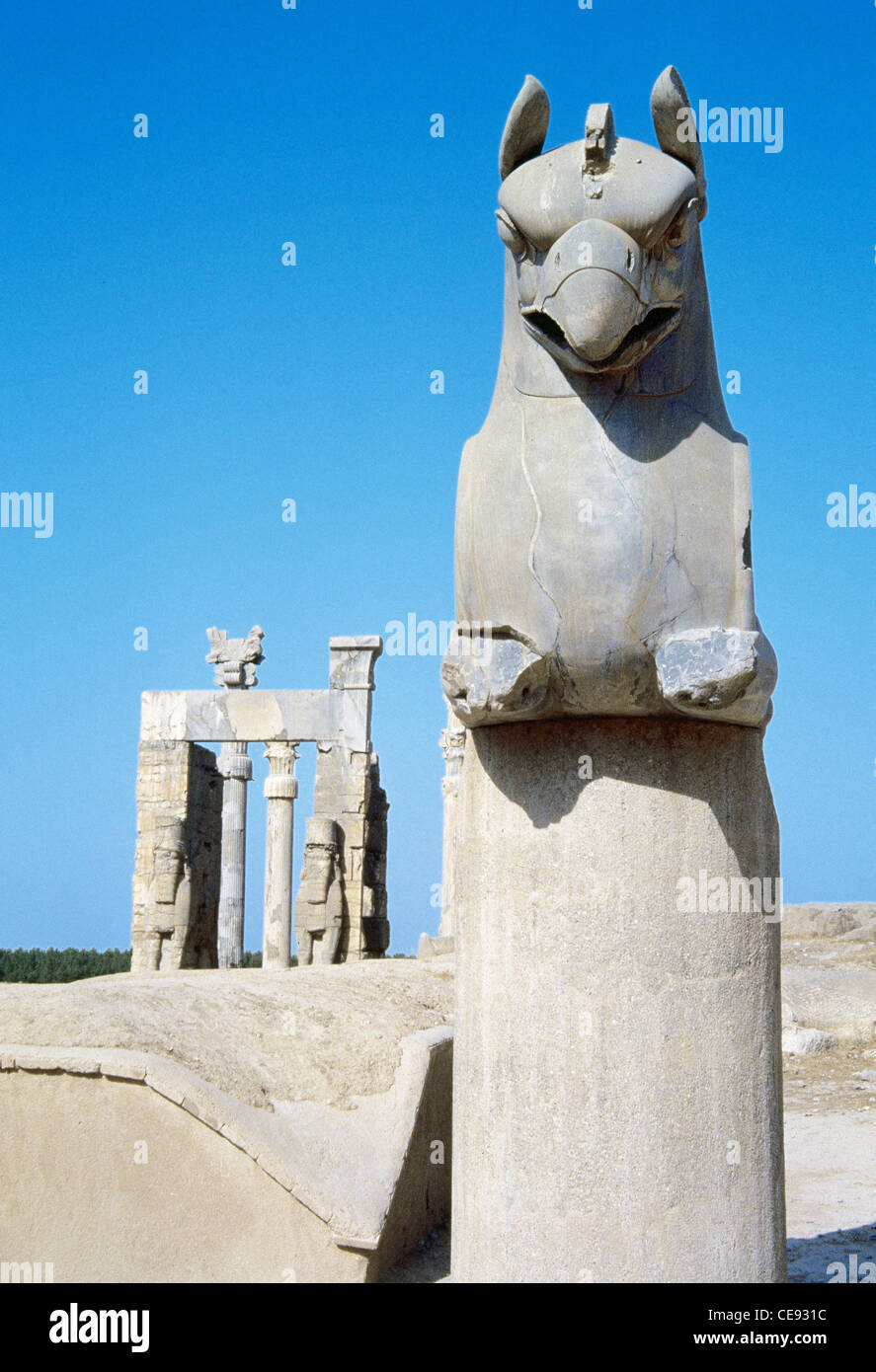 Persian Art. Achaemenid period. Persepolis (Takht-e-Jamshid). Capital with a griffin and the gate of All Nations. Stock Photohttps://www.alamy.com/image-license-details/?v=1https://www.alamy.com/stock-photo-persian-art-achaemenid-period-persepolis-takht-e-jamshid-capital-with-43225880.html
Persian Art. Achaemenid period. Persepolis (Takht-e-Jamshid). Capital with a griffin and the gate of All Nations. Stock Photohttps://www.alamy.com/image-license-details/?v=1https://www.alamy.com/stock-photo-persian-art-achaemenid-period-persepolis-takht-e-jamshid-capital-with-43225880.htmlRMCE931C–Persian Art. Achaemenid period. Persepolis (Takht-e-Jamshid). Capital with a griffin and the gate of All Nations.
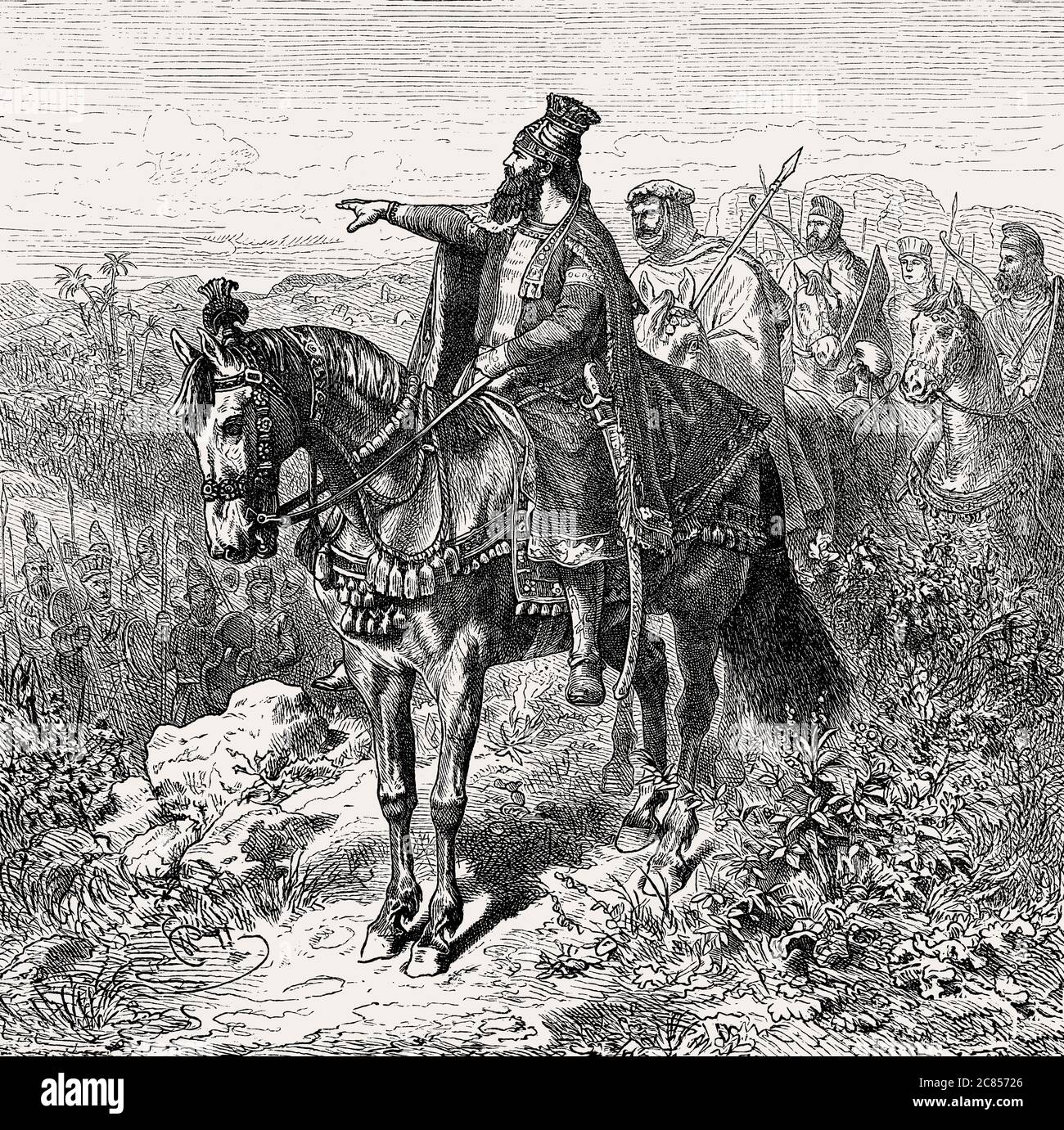 Cyrus the Great, king of the Persian Achaemenid Empire Stock Photohttps://www.alamy.com/image-license-details/?v=1https://www.alamy.com/cyrus-the-great-king-of-the-persian-achaemenid-empire-image366450286.html
Cyrus the Great, king of the Persian Achaemenid Empire Stock Photohttps://www.alamy.com/image-license-details/?v=1https://www.alamy.com/cyrus-the-great-king-of-the-persian-achaemenid-empire-image366450286.htmlRM2C85726–Cyrus the Great, king of the Persian Achaemenid Empire
 Persian Art. Achaemenid period. Persepolis (Takht-e-Jamshid). Capital with a griffin, dated during the reign of Xerxes (486-465 BC). In the background, the Gate of all Nations or Gate of Xerxes. Islamic Republic of Iran. Stock Photohttps://www.alamy.com/image-license-details/?v=1https://www.alamy.com/persian-art-achaemenid-period-persepolis-takht-e-jamshid-capital-with-a-griffin-dated-during-the-reign-of-xerxes-486-465-bc-in-the-background-the-gate-of-all-nations-or-gate-of-xerxes-islamic-republic-of-iran-image220340467.html
Persian Art. Achaemenid period. Persepolis (Takht-e-Jamshid). Capital with a griffin, dated during the reign of Xerxes (486-465 BC). In the background, the Gate of all Nations or Gate of Xerxes. Islamic Republic of Iran. Stock Photohttps://www.alamy.com/image-license-details/?v=1https://www.alamy.com/persian-art-achaemenid-period-persepolis-takht-e-jamshid-capital-with-a-griffin-dated-during-the-reign-of-xerxes-486-465-bc-in-the-background-the-gate-of-all-nations-or-gate-of-xerxes-islamic-republic-of-iran-image220340467.htmlRMPPDAEB–Persian Art. Achaemenid period. Persepolis (Takht-e-Jamshid). Capital with a griffin, dated during the reign of Xerxes (486-465 BC). In the background, the Gate of all Nations or Gate of Xerxes. Islamic Republic of Iran.
 Iskandar (Alexander the Great) Battling the Zangi, c. 1550, Gold, colors, and ink on paper, Iran, Safavid period (1501-1736), The Macedonian king Alexander the Great (256–323 BCE), known in Persian as Iskandar, is celebrated in the Shahnameh as the valiant figure who defeats the Achaemenid dynasty and takes the role of a great Iranian King. However, in keeping with the epic, many of his achievements were exaggerated and fictionalized. In this painting, mounted on gold-sprinkled paper, Iskandar is seen with his army, defending Egypt from an attack from the Zangi, the Persian term Stock Photohttps://www.alamy.com/image-license-details/?v=1https://www.alamy.com/iskandar-alexander-the-great-battling-the-zangi-c-1550-gold-colors-and-ink-on-paper-iran-safavid-period-1501-1736-the-macedonian-king-alexander-the-great-256323-bce-known-in-persian-as-iskandar-is-celebrated-in-the-shahnameh-as-the-valiant-figure-who-defeats-the-achaemenid-dynasty-and-takes-the-role-of-a-great-iranian-king-however-in-keeping-with-the-epic-many-of-his-achievements-were-exaggerated-and-fictionalized-in-this-painting-mounted-on-gold-sprinkled-paper-iskandar-is-seen-with-his-army-defending-egypt-from-an-attack-from-the-zangi-the-persian-term-image573485222.html
Iskandar (Alexander the Great) Battling the Zangi, c. 1550, Gold, colors, and ink on paper, Iran, Safavid period (1501-1736), The Macedonian king Alexander the Great (256–323 BCE), known in Persian as Iskandar, is celebrated in the Shahnameh as the valiant figure who defeats the Achaemenid dynasty and takes the role of a great Iranian King. However, in keeping with the epic, many of his achievements were exaggerated and fictionalized. In this painting, mounted on gold-sprinkled paper, Iskandar is seen with his army, defending Egypt from an attack from the Zangi, the Persian term Stock Photohttps://www.alamy.com/image-license-details/?v=1https://www.alamy.com/iskandar-alexander-the-great-battling-the-zangi-c-1550-gold-colors-and-ink-on-paper-iran-safavid-period-1501-1736-the-macedonian-king-alexander-the-great-256323-bce-known-in-persian-as-iskandar-is-celebrated-in-the-shahnameh-as-the-valiant-figure-who-defeats-the-achaemenid-dynasty-and-takes-the-role-of-a-great-iranian-king-however-in-keeping-with-the-epic-many-of-his-achievements-were-exaggerated-and-fictionalized-in-this-painting-mounted-on-gold-sprinkled-paper-iskandar-is-seen-with-his-army-defending-egypt-from-an-attack-from-the-zangi-the-persian-term-image573485222.htmlRM2T90E72–Iskandar (Alexander the Great) Battling the Zangi, c. 1550, Gold, colors, and ink on paper, Iran, Safavid period (1501-1736), The Macedonian king Alexander the Great (256–323 BCE), known in Persian as Iskandar, is celebrated in the Shahnameh as the valiant figure who defeats the Achaemenid dynasty and takes the role of a great Iranian King. However, in keeping with the epic, many of his achievements were exaggerated and fictionalized. In this painting, mounted on gold-sprinkled paper, Iskandar is seen with his army, defending Egypt from an attack from the Zangi, the Persian term
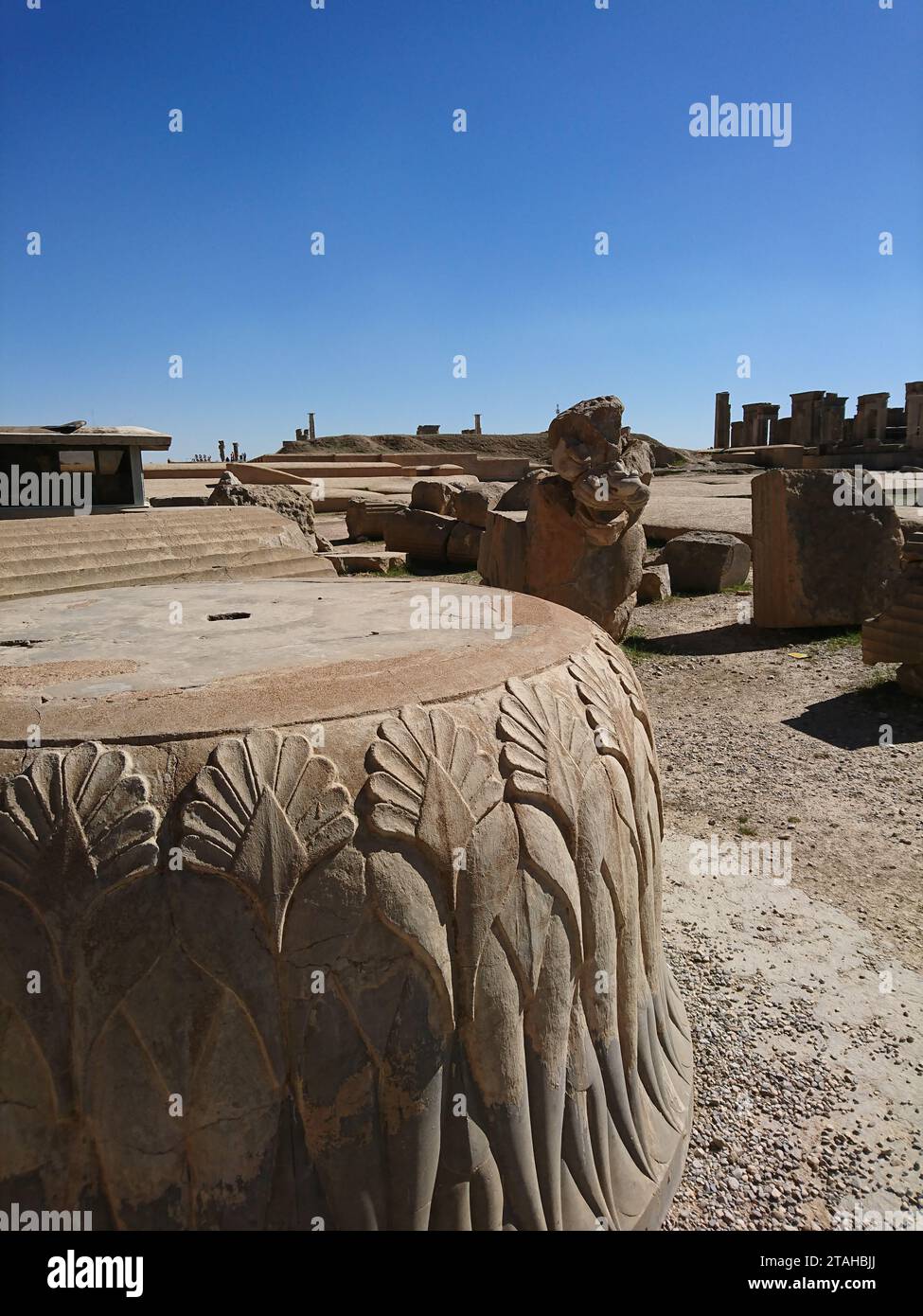 Hieroglyphs carved on the wall of an ancient temple. Remains of Persepolis. Achaemenid period. Antiquities before Christ Stock Photohttps://www.alamy.com/image-license-details/?v=1https://www.alamy.com/hieroglyphs-carved-on-the-wall-of-an-ancient-temple-remains-of-persepolis-achaemenid-period-antiquities-before-christ-image574471034.html
Hieroglyphs carved on the wall of an ancient temple. Remains of Persepolis. Achaemenid period. Antiquities before Christ Stock Photohttps://www.alamy.com/image-license-details/?v=1https://www.alamy.com/hieroglyphs-carved-on-the-wall-of-an-ancient-temple-remains-of-persepolis-achaemenid-period-antiquities-before-christ-image574471034.htmlRF2TAHBJJ–Hieroglyphs carved on the wall of an ancient temple. Remains of Persepolis. Achaemenid period. Antiquities before Christ
 Achaemenid period. Oxus Treasure. 500-300 BC. The jug and two bowls. Golden and silver . Takht-i Kuwad. Tajikistan. British Museum. Stock Photohttps://www.alamy.com/image-license-details/?v=1https://www.alamy.com/achaemenid-period-oxus-treasure-500-300-bc-the-jug-and-two-bowls-golden-and-silver-takht-i-kuwad-tajikistan-british-museum-image425371877.html
Achaemenid period. Oxus Treasure. 500-300 BC. The jug and two bowls. Golden and silver . Takht-i Kuwad. Tajikistan. British Museum. Stock Photohttps://www.alamy.com/image-license-details/?v=1https://www.alamy.com/achaemenid-period-oxus-treasure-500-300-bc-the-jug-and-two-bowls-golden-and-silver-takht-i-kuwad-tajikistan-british-museum-image425371877.htmlRM2FM1A4N–Achaemenid period. Oxus Treasure. 500-300 BC. The jug and two bowls. Golden and silver . Takht-i Kuwad. Tajikistan. British Museum.
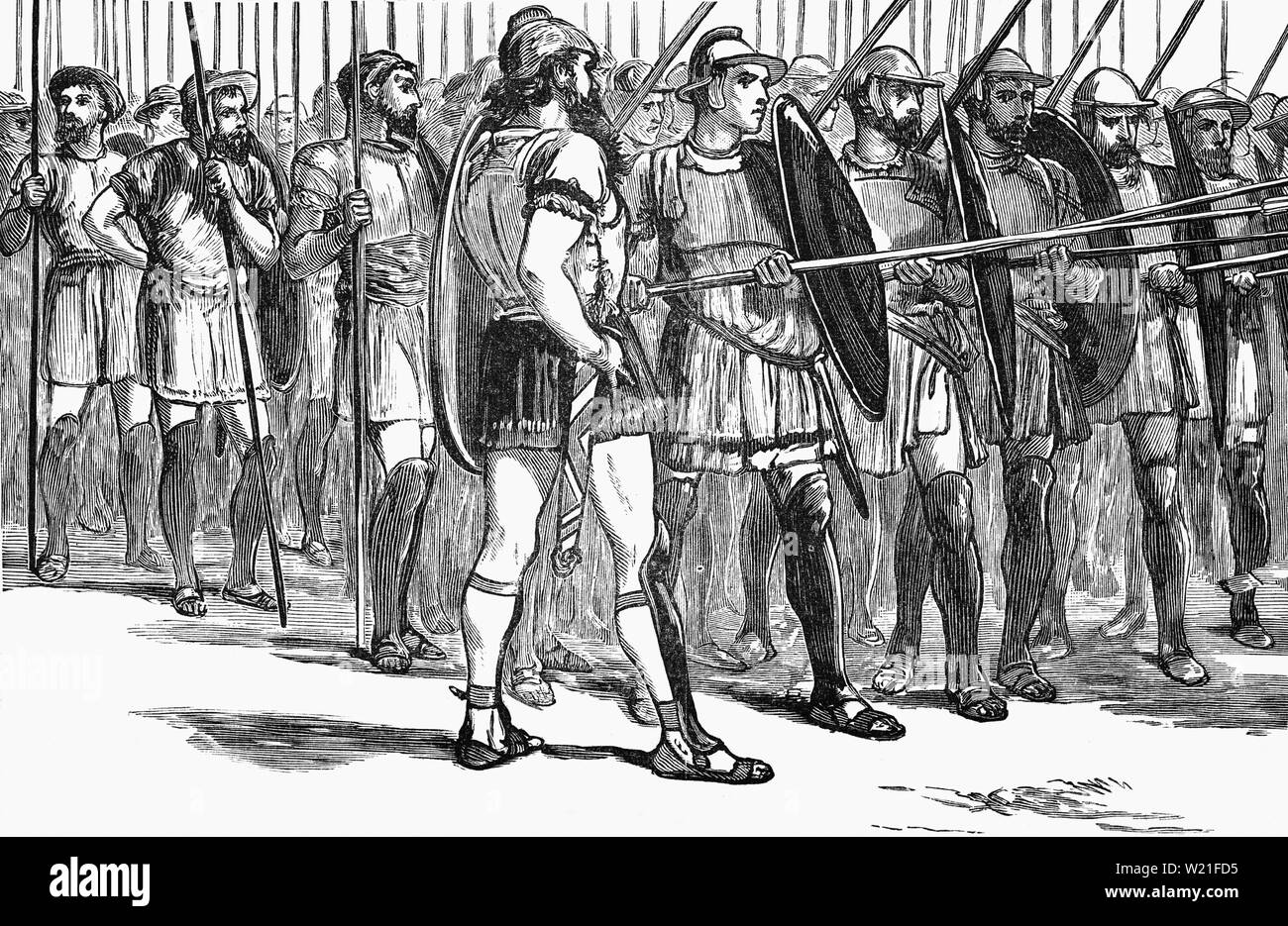 A Macedonian phalanx, an infantry formation developed by Philip II (382–336 BCE) and used by his son Alexander the Great to conquer the Achaemenid Empire and other armies. Phalanxes remained dominant on battlefields throughout the Ancient Macedonian Period, until they were ultimately displaced by the Roman legions. They were professional soldiers, and were among the first troops ever to be drilled, allowing them to execute complex maneuvers well beyond the reach of most other armies. They fought packed in a close rectangular formation, usually eight men deep, with a leader at the head of each Stock Photohttps://www.alamy.com/image-license-details/?v=1https://www.alamy.com/a-macedonian-phalanx-an-infantry-formation-developed-by-philip-ii-382336-bce-and-used-by-his-son-alexander-the-great-to-conquer-the-achaemenid-empire-and-other-armies-phalanxes-remained-dominant-on-battlefields-throughout-the-ancient-macedonian-period-until-they-were-ultimately-displaced-by-the-roman-legions-they-were-professional-soldiers-and-were-among-the-first-troops-ever-to-be-drilled-allowing-them-to-execute-complex-maneuvers-well-beyond-the-reach-of-most-other-armies-they-fought-packed-in-a-close-rectangular-formation-usually-eight-men-deep-with-a-leader-at-the-head-of-each-image259418913.html
A Macedonian phalanx, an infantry formation developed by Philip II (382–336 BCE) and used by his son Alexander the Great to conquer the Achaemenid Empire and other armies. Phalanxes remained dominant on battlefields throughout the Ancient Macedonian Period, until they were ultimately displaced by the Roman legions. They were professional soldiers, and were among the first troops ever to be drilled, allowing them to execute complex maneuvers well beyond the reach of most other armies. They fought packed in a close rectangular formation, usually eight men deep, with a leader at the head of each Stock Photohttps://www.alamy.com/image-license-details/?v=1https://www.alamy.com/a-macedonian-phalanx-an-infantry-formation-developed-by-philip-ii-382336-bce-and-used-by-his-son-alexander-the-great-to-conquer-the-achaemenid-empire-and-other-armies-phalanxes-remained-dominant-on-battlefields-throughout-the-ancient-macedonian-period-until-they-were-ultimately-displaced-by-the-roman-legions-they-were-professional-soldiers-and-were-among-the-first-troops-ever-to-be-drilled-allowing-them-to-execute-complex-maneuvers-well-beyond-the-reach-of-most-other-armies-they-fought-packed-in-a-close-rectangular-formation-usually-eight-men-deep-with-a-leader-at-the-head-of-each-image259418913.htmlRMW21FD5–A Macedonian phalanx, an infantry formation developed by Philip II (382–336 BCE) and used by his son Alexander the Great to conquer the Achaemenid Empire and other armies. Phalanxes remained dominant on battlefields throughout the Ancient Macedonian Period, until they were ultimately displaced by the Roman legions. They were professional soldiers, and were among the first troops ever to be drilled, allowing them to execute complex maneuvers well beyond the reach of most other armies. They fought packed in a close rectangular formation, usually eight men deep, with a leader at the head of each
 Achaemenid. Horn-shaped rhyton. Silver and gold. 5thC BC. Made in Syria. Turkey, Kahramanmaras. British Museum. Stock Photohttps://www.alamy.com/image-license-details/?v=1https://www.alamy.com/achaemenid-horn-shaped-rhyton-silver-and-gold-5thc-bc-made-in-syria-turkey-kahramanmaras-british-museum-image425364648.html
Achaemenid. Horn-shaped rhyton. Silver and gold. 5thC BC. Made in Syria. Turkey, Kahramanmaras. British Museum. Stock Photohttps://www.alamy.com/image-license-details/?v=1https://www.alamy.com/achaemenid-horn-shaped-rhyton-silver-and-gold-5thc-bc-made-in-syria-turkey-kahramanmaras-british-museum-image425364648.htmlRM2FM10XG–Achaemenid. Horn-shaped rhyton. Silver and gold. 5thC BC. Made in Syria. Turkey, Kahramanmaras. British Museum.
 Naqsh-e Rustam is an ancient site consisting of colossal tombs of Persian Kings. Its located in Fars Province, Iran Stock Photohttps://www.alamy.com/image-license-details/?v=1https://www.alamy.com/stock-photo-naqsh-e-rustam-is-an-ancient-site-consisting-of-colossal-tombs-of-128911283.html
Naqsh-e Rustam is an ancient site consisting of colossal tombs of Persian Kings. Its located in Fars Province, Iran Stock Photohttps://www.alamy.com/image-license-details/?v=1https://www.alamy.com/stock-photo-naqsh-e-rustam-is-an-ancient-site-consisting-of-colossal-tombs-of-128911283.htmlRFHDMBJB–Naqsh-e Rustam is an ancient site consisting of colossal tombs of Persian Kings. Its located in Fars Province, Iran
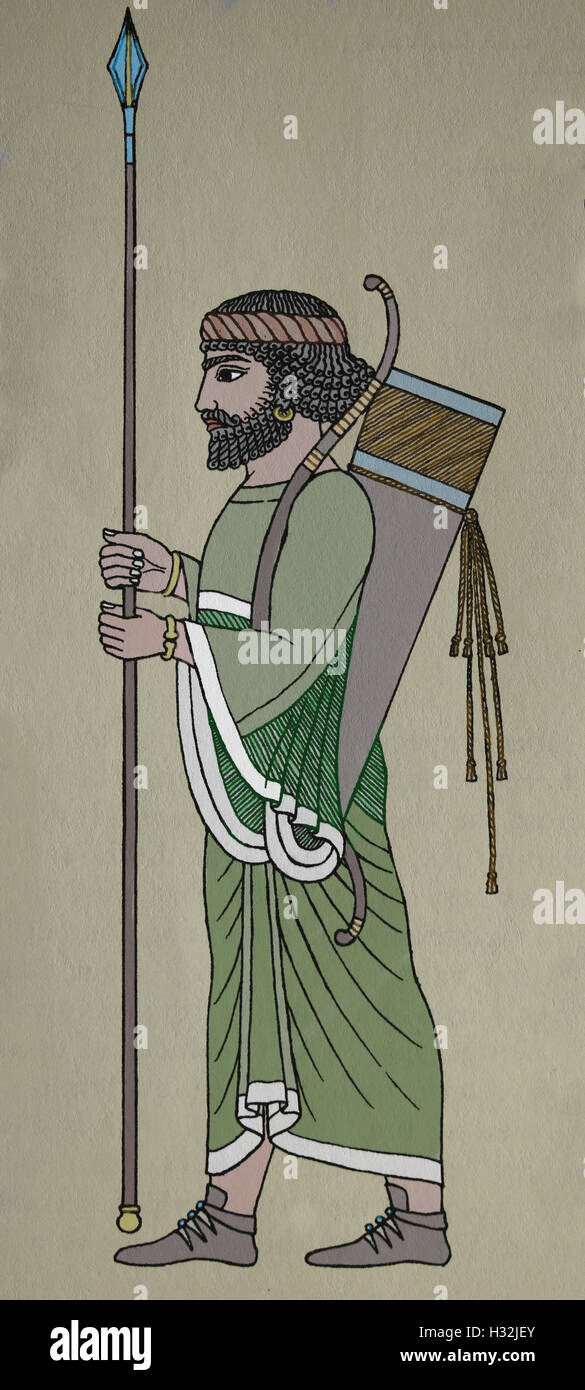 Achaemenid Empire. Persian soldier. 6th c. BC. Susa. Iran. Engraving, color. 19th c. Stock Photohttps://www.alamy.com/image-license-details/?v=1https://www.alamy.com/stock-photo-achaemenid-empire-persian-soldier-6th-c-bc-susa-iran-engraving-color-122374979.html
Achaemenid Empire. Persian soldier. 6th c. BC. Susa. Iran. Engraving, color. 19th c. Stock Photohttps://www.alamy.com/image-license-details/?v=1https://www.alamy.com/stock-photo-achaemenid-empire-persian-soldier-6th-c-bc-susa-iran-engraving-color-122374979.htmlRMH32JEY–Achaemenid Empire. Persian soldier. 6th c. BC. Susa. Iran. Engraving, color. 19th c.
 Art inspired by Plaque with horned lion-griffins, Achaemenid, ca. 6th–4th century B.C., Iran, Achaemenid, Gold, H. 13.6 cm, W. 9.8 cm, Metalwork-Ornaments, In the sixth century B.C., under the leadership of Cyrus the Great, the Persians established themselves at the head of an empire, Classic works modernized by Artotop with a splash of modernity. Shapes, color and value, eye-catching visual impact on art. Emotions through freedom of artworks in a contemporary way. A timeless message pursuing a wildly creative new direction. Artists turning to the digital medium and creating the Artotop NFT Stock Photohttps://www.alamy.com/image-license-details/?v=1https://www.alamy.com/art-inspired-by-plaque-with-horned-lion-griffins-achaemenid-ca-6th4th-century-bc-iran-achaemenid-gold-h-136-cm-w-98-cm-metalwork-ornaments-in-the-sixth-century-bc-under-the-leadership-of-cyrus-the-great-the-persians-established-themselves-at-the-head-of-an-empire-classic-works-modernized-by-artotop-with-a-splash-of-modernity-shapes-color-and-value-eye-catching-visual-impact-on-art-emotions-through-freedom-of-artworks-in-a-contemporary-way-a-timeless-message-pursuing-a-wildly-creative-new-direction-artists-turning-to-the-digital-medium-and-creating-the-artotop-nft-image462944700.html
Art inspired by Plaque with horned lion-griffins, Achaemenid, ca. 6th–4th century B.C., Iran, Achaemenid, Gold, H. 13.6 cm, W. 9.8 cm, Metalwork-Ornaments, In the sixth century B.C., under the leadership of Cyrus the Great, the Persians established themselves at the head of an empire, Classic works modernized by Artotop with a splash of modernity. Shapes, color and value, eye-catching visual impact on art. Emotions through freedom of artworks in a contemporary way. A timeless message pursuing a wildly creative new direction. Artists turning to the digital medium and creating the Artotop NFT Stock Photohttps://www.alamy.com/image-license-details/?v=1https://www.alamy.com/art-inspired-by-plaque-with-horned-lion-griffins-achaemenid-ca-6th4th-century-bc-iran-achaemenid-gold-h-136-cm-w-98-cm-metalwork-ornaments-in-the-sixth-century-bc-under-the-leadership-of-cyrus-the-great-the-persians-established-themselves-at-the-head-of-an-empire-classic-works-modernized-by-artotop-with-a-splash-of-modernity-shapes-color-and-value-eye-catching-visual-impact-on-art-emotions-through-freedom-of-artworks-in-a-contemporary-way-a-timeless-message-pursuing-a-wildly-creative-new-direction-artists-turning-to-the-digital-medium-and-creating-the-artotop-nft-image462944700.htmlRF2HW4XK8–Art inspired by Plaque with horned lion-griffins, Achaemenid, ca. 6th–4th century B.C., Iran, Achaemenid, Gold, H. 13.6 cm, W. 9.8 cm, Metalwork-Ornaments, In the sixth century B.C., under the leadership of Cyrus the Great, the Persians established themselves at the head of an empire, Classic works modernized by Artotop with a splash of modernity. Shapes, color and value, eye-catching visual impact on art. Emotions through freedom of artworks in a contemporary way. A timeless message pursuing a wildly creative new direction. Artists turning to the digital medium and creating the Artotop NFT
 Servant bearing food and drink. Palace of Darius I. Reign of Artaxerxes III. 358-338 BC. B.C. Persepolis. Iran. Achaemenid Stock Photohttps://www.alamy.com/image-license-details/?v=1https://www.alamy.com/stock-photo-servant-bearing-food-and-drink-palace-of-darius-i-reign-of-artaxerxes-118098045.html
Servant bearing food and drink. Palace of Darius I. Reign of Artaxerxes III. 358-338 BC. B.C. Persepolis. Iran. Achaemenid Stock Photohttps://www.alamy.com/image-license-details/?v=1https://www.alamy.com/stock-photo-servant-bearing-food-and-drink-palace-of-darius-i-reign-of-artaxerxes-118098045.htmlRMGT3R79–Servant bearing food and drink. Palace of Darius I. Reign of Artaxerxes III. 358-338 BC. B.C. Persepolis. Iran. Achaemenid
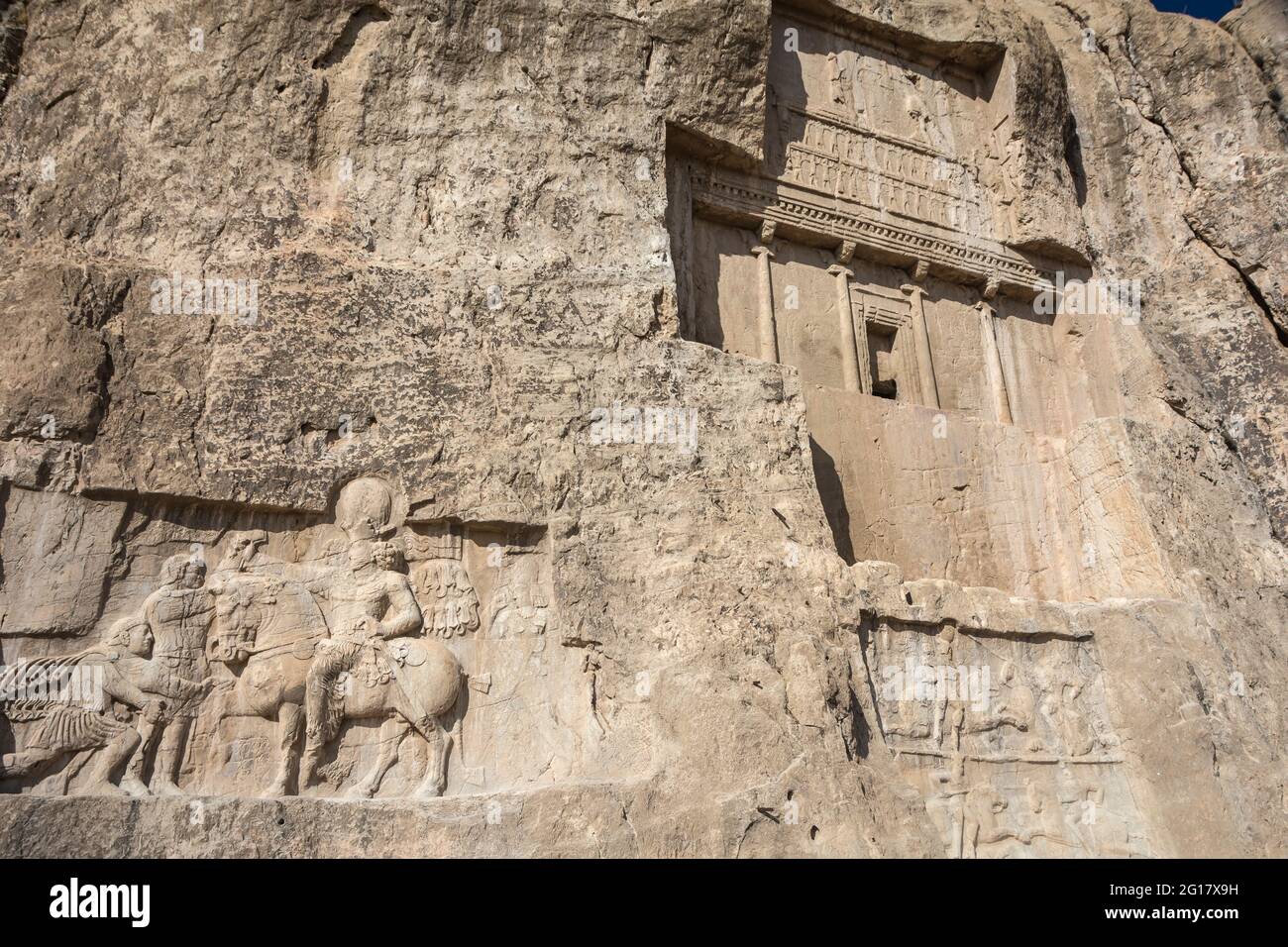 Naqsh-e Rostam,necropolis of the Achaemenid dynasty near Persepolis, with tomb of Darius I and the relief of Shapur I cut into the rocks. Iran. Stock Photohttps://www.alamy.com/image-license-details/?v=1https://www.alamy.com/naqsh-e-rostamnecropolis-of-the-achaemenid-dynasty-near-persepolis-with-tomb-of-darius-i-and-the-relief-of-shapur-i-cut-into-the-rocks-iran-image431048173.html
Naqsh-e Rostam,necropolis of the Achaemenid dynasty near Persepolis, with tomb of Darius I and the relief of Shapur I cut into the rocks. Iran. Stock Photohttps://www.alamy.com/image-license-details/?v=1https://www.alamy.com/naqsh-e-rostamnecropolis-of-the-achaemenid-dynasty-near-persepolis-with-tomb-of-darius-i-and-the-relief-of-shapur-i-cut-into-the-rocks-iran-image431048173.htmlRF2G17X9H–Naqsh-e Rostam,necropolis of the Achaemenid dynasty near Persepolis, with tomb of Darius I and the relief of Shapur I cut into the rocks. Iran.
 Iran. Persepolis. Capital of the Achaemenid Empire (ca. 550-330 BC). Palatial city built by King Darius I and destroyed by Alexander the Great in 330 Stock Photohttps://www.alamy.com/image-license-details/?v=1https://www.alamy.com/iran-persepolis-capital-of-the-achaemenid-empire-ca-550-330-bc-palatial-city-built-by-king-darius-i-and-destroyed-by-alexander-the-great-in-330-image447935583.html
Iran. Persepolis. Capital of the Achaemenid Empire (ca. 550-330 BC). Palatial city built by King Darius I and destroyed by Alexander the Great in 330 Stock Photohttps://www.alamy.com/image-license-details/?v=1https://www.alamy.com/iran-persepolis-capital-of-the-achaemenid-empire-ca-550-330-bc-palatial-city-built-by-king-darius-i-and-destroyed-by-alexander-the-great-in-330-image447935583.htmlRM2H0N6BB–Iran. Persepolis. Capital of the Achaemenid Empire (ca. 550-330 BC). Palatial city built by King Darius I and destroyed by Alexander the Great in 330
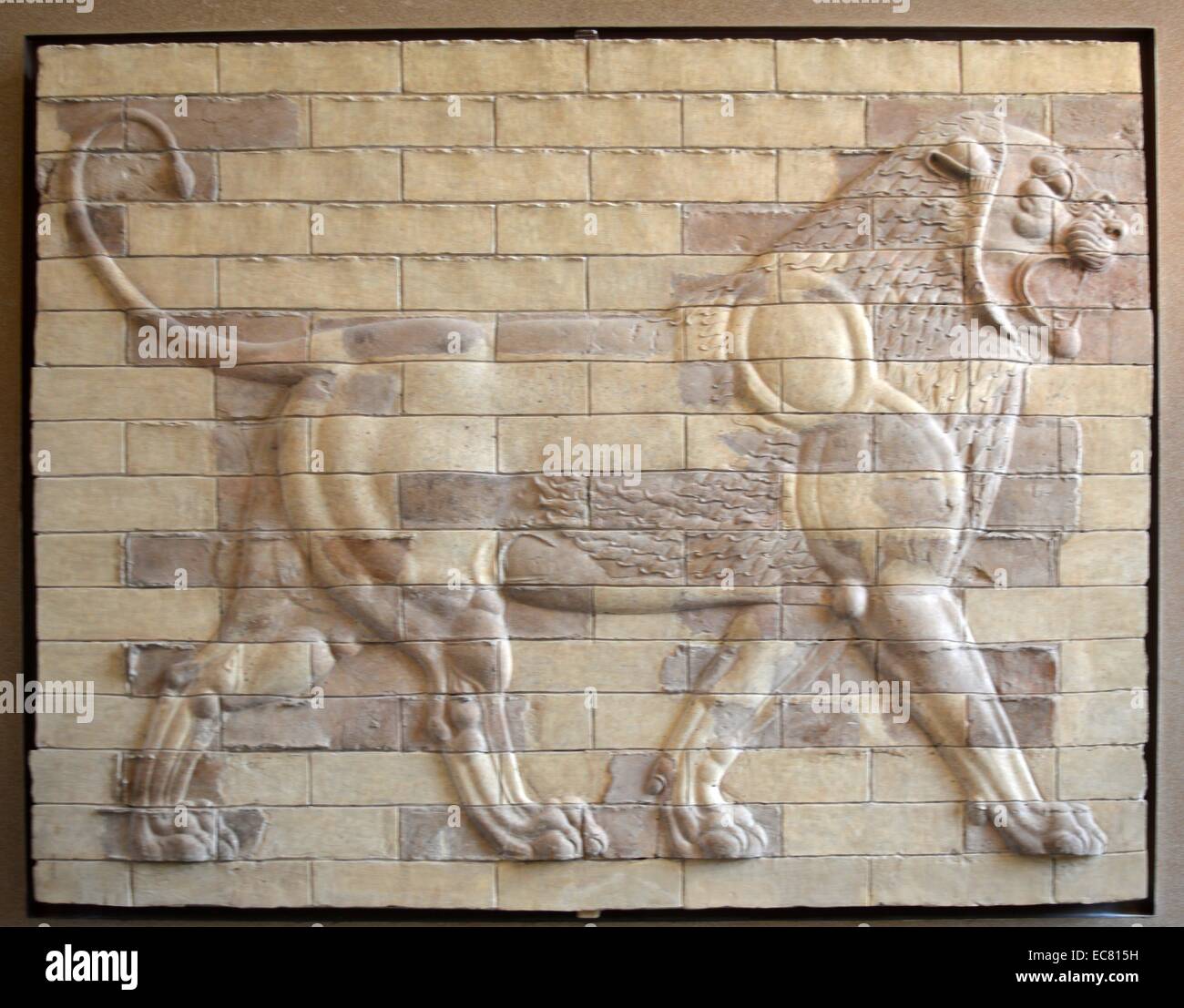 Decorative panels of moulded terracotta bricks. Achaemenid period. Palace of Darius 1st. Stock Photohttps://www.alamy.com/image-license-details/?v=1https://www.alamy.com/stock-photo-decorative-panels-of-moulded-terracotta-bricks-achaemenid-period-palace-76393901.html
Decorative panels of moulded terracotta bricks. Achaemenid period. Palace of Darius 1st. Stock Photohttps://www.alamy.com/image-license-details/?v=1https://www.alamy.com/stock-photo-decorative-panels-of-moulded-terracotta-bricks-achaemenid-period-palace-76393901.htmlRMEC815H–Decorative panels of moulded terracotta bricks. Achaemenid period. Palace of Darius 1st.
 Cylinder Seal. Iran, Achaemenid period, circa 550-330 B.C.. Tools and Equipment; seals. Blue chalcedony Stock Photohttps://www.alamy.com/image-license-details/?v=1https://www.alamy.com/cylinder-seal-iran-achaemenid-period-circa-550-330-bc-tools-and-equipment-seals-blue-chalcedony-image464763132.html
Cylinder Seal. Iran, Achaemenid period, circa 550-330 B.C.. Tools and Equipment; seals. Blue chalcedony Stock Photohttps://www.alamy.com/image-license-details/?v=1https://www.alamy.com/cylinder-seal-iran-achaemenid-period-circa-550-330-bc-tools-and-equipment-seals-blue-chalcedony-image464763132.htmlRM2J03P38–Cylinder Seal. Iran, Achaemenid period, circa 550-330 B.C.. Tools and Equipment; seals. Blue chalcedony
 Exterior view depicting the Assyrian palace of Kouyunjik in Niniveh, Upper Mesopotamia. Wood Engraving (c. 1870), 19th century. Stock Photohttps://www.alamy.com/image-license-details/?v=1https://www.alamy.com/exterior-view-depicting-the-assyrian-palace-of-kouyunjik-in-niniveh-upper-mesopotamia-wood-engraving-c-1870-19th-century-image222800090.html
Exterior view depicting the Assyrian palace of Kouyunjik in Niniveh, Upper Mesopotamia. Wood Engraving (c. 1870), 19th century. Stock Photohttps://www.alamy.com/image-license-details/?v=1https://www.alamy.com/exterior-view-depicting-the-assyrian-palace-of-kouyunjik-in-niniveh-upper-mesopotamia-wood-engraving-c-1870-19th-century-image222800090.htmlRMPXDBP2–Exterior view depicting the Assyrian palace of Kouyunjik in Niniveh, Upper Mesopotamia. Wood Engraving (c. 1870), 19th century.
 Greece Battle of Thermopylae Leonidas monument Stock Photohttps://www.alamy.com/image-license-details/?v=1https://www.alamy.com/greece-battle-of-thermopylae-leonidas-monument-image450853740.html
Greece Battle of Thermopylae Leonidas monument Stock Photohttps://www.alamy.com/image-license-details/?v=1https://www.alamy.com/greece-battle-of-thermopylae-leonidas-monument-image450853740.htmlRF2H5E4F8–Greece Battle of Thermopylae Leonidas monument
 Bagaeus delivering his messages to the Persian guards. Bagaeus an Achaemenid nobleman, ordered by Darius I to kill Oroetus, or Oroetes, he used the written orders from Darius in order to assure himself of the obedience of the bodyguards of Oreates. From Cassell's Universal History, published 1888. Stock Photohttps://www.alamy.com/image-license-details/?v=1https://www.alamy.com/bagaeus-delivering-his-messages-to-the-persian-guards-bagaeus-an-achaemenid-nobleman-ordered-by-darius-i-to-kill-oroetus-or-oroetes-he-used-the-written-orders-from-darius-in-order-to-assure-himself-of-the-obedience-of-the-bodyguards-of-oreates-from-cassells-universal-history-published-1888-image415030241.html
Bagaeus delivering his messages to the Persian guards. Bagaeus an Achaemenid nobleman, ordered by Darius I to kill Oroetus, or Oroetes, he used the written orders from Darius in order to assure himself of the obedience of the bodyguards of Oreates. From Cassell's Universal History, published 1888. Stock Photohttps://www.alamy.com/image-license-details/?v=1https://www.alamy.com/bagaeus-delivering-his-messages-to-the-persian-guards-bagaeus-an-achaemenid-nobleman-ordered-by-darius-i-to-kill-oroetus-or-oroetes-he-used-the-written-orders-from-darius-in-order-to-assure-himself-of-the-obedience-of-the-bodyguards-of-oreates-from-cassells-universal-history-published-1888-image415030241.htmlRM2F3678H–Bagaeus delivering his messages to the Persian guards. Bagaeus an Achaemenid nobleman, ordered by Darius I to kill Oroetus, or Oroetes, he used the written orders from Darius in order to assure himself of the obedience of the bodyguards of Oreates. From Cassell's Universal History, published 1888.
 Persian art. Achaemenid period. Apadana Palace. Ruins. First palace built under Darius I in the new capital, Persepolis. Stock Photohttps://www.alamy.com/image-license-details/?v=1https://www.alamy.com/stock-photo-persian-art-achaemenid-period-apadana-palace-ruins-first-palace-built-50673597.html
Persian art. Achaemenid period. Apadana Palace. Ruins. First palace built under Darius I in the new capital, Persepolis. Stock Photohttps://www.alamy.com/image-license-details/?v=1https://www.alamy.com/stock-photo-persian-art-achaemenid-period-apadana-palace-ruins-first-palace-built-50673597.htmlRMCXCAK9–Persian art. Achaemenid period. Apadana Palace. Ruins. First palace built under Darius I in the new capital, Persepolis.
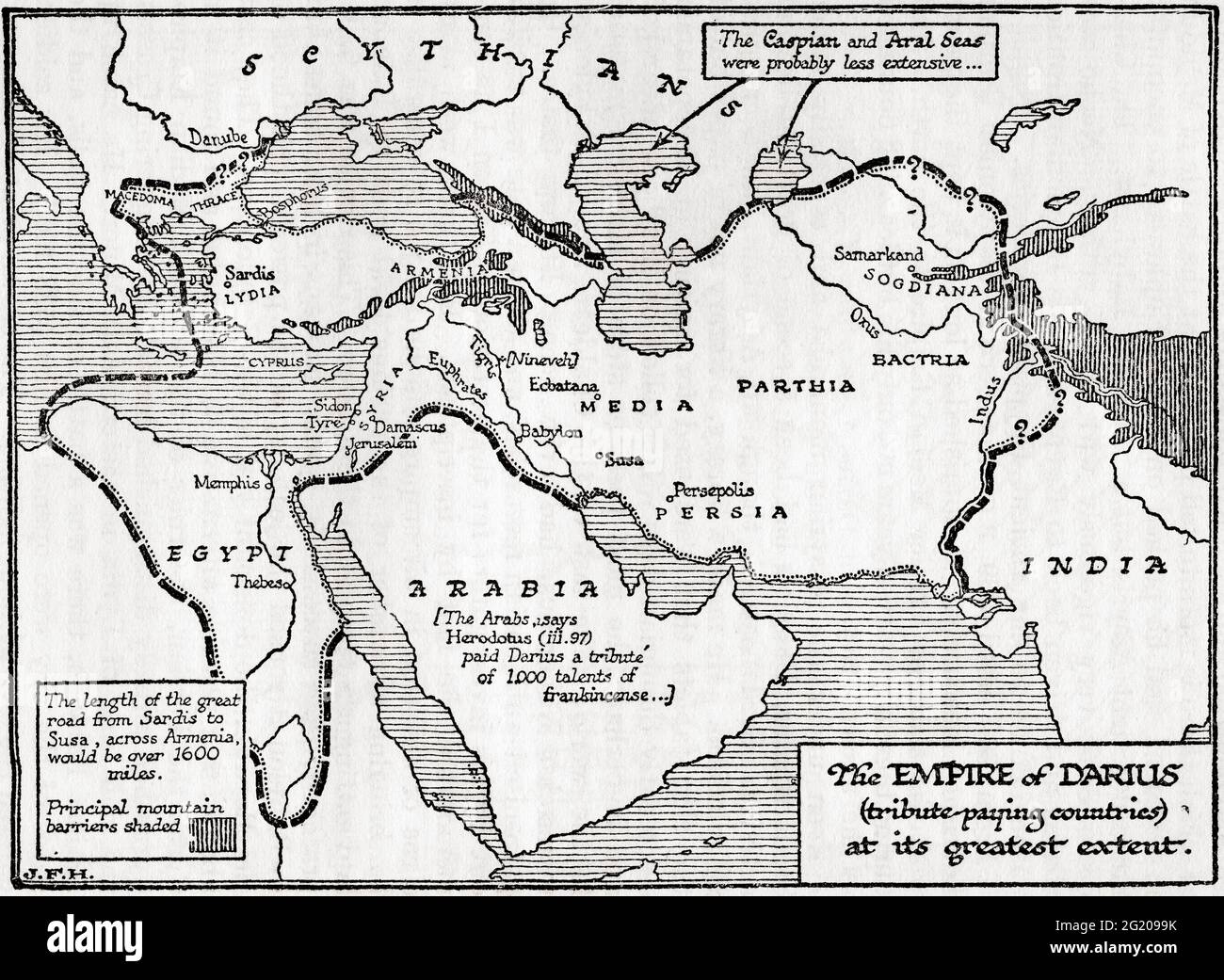 Map of the empire of Darius (tribute paying countries) at its greatest extent. Darius I, c. 550 – 486 BC, aka Darius the Great. Third Iranian King of Kings of the Achaemenid Empire. From A Short History of the World, published c.1936 Stock Photohttps://www.alamy.com/image-license-details/?v=1https://www.alamy.com/map-of-the-empire-of-darius-tribute-paying-countries-at-its-greatest-extent-darius-i-c-550-486-bc-aka-darius-the-great-third-iranian-king-of-kings-of-the-achaemenid-empire-from-a-short-history-of-the-world-published-c1936-image431495839.html
Map of the empire of Darius (tribute paying countries) at its greatest extent. Darius I, c. 550 – 486 BC, aka Darius the Great. Third Iranian King of Kings of the Achaemenid Empire. From A Short History of the World, published c.1936 Stock Photohttps://www.alamy.com/image-license-details/?v=1https://www.alamy.com/map-of-the-empire-of-darius-tribute-paying-countries-at-its-greatest-extent-darius-i-c-550-486-bc-aka-darius-the-great-third-iranian-king-of-kings-of-the-achaemenid-empire-from-a-short-history-of-the-world-published-c1936-image431495839.htmlRM2G2099K–Map of the empire of Darius (tribute paying countries) at its greatest extent. Darius I, c. 550 – 486 BC, aka Darius the Great. Third Iranian King of Kings of the Achaemenid Empire. From A Short History of the World, published c.1936
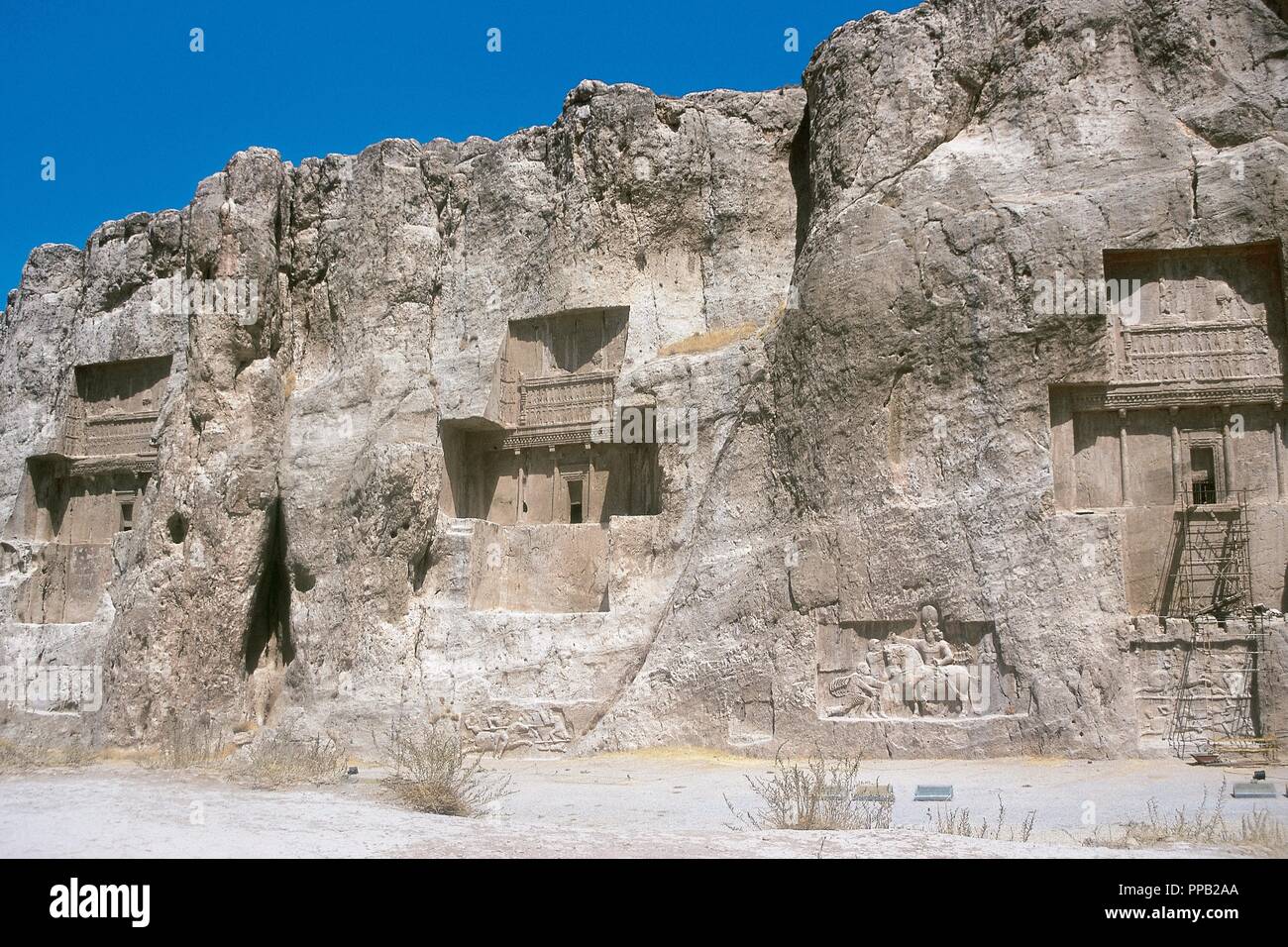 Persian Art. Achaemenid Period. 6th and 5th century B.C. Tombs of kings Darius I, Xerxes I and Darius II, carved into the rock. Necropolis of Naqsh-e Rustam. Around Persepolis. Iran. Stock Photohttps://www.alamy.com/image-license-details/?v=1https://www.alamy.com/persian-art-achaemenid-period-6th-and-5th-century-bc-tombs-of-kings-darius-i-xerxes-i-and-darius-ii-carved-into-the-rock-necropolis-of-naqsh-e-rustam-around-persepolis-iran-image220290178.html
Persian Art. Achaemenid Period. 6th and 5th century B.C. Tombs of kings Darius I, Xerxes I and Darius II, carved into the rock. Necropolis of Naqsh-e Rustam. Around Persepolis. Iran. Stock Photohttps://www.alamy.com/image-license-details/?v=1https://www.alamy.com/persian-art-achaemenid-period-6th-and-5th-century-bc-tombs-of-kings-darius-i-xerxes-i-and-darius-ii-carved-into-the-rock-necropolis-of-naqsh-e-rustam-around-persepolis-iran-image220290178.htmlRMPPB2AA–Persian Art. Achaemenid Period. 6th and 5th century B.C. Tombs of kings Darius I, Xerxes I and Darius II, carved into the rock. Necropolis of Naqsh-e Rustam. Around Persepolis. Iran.
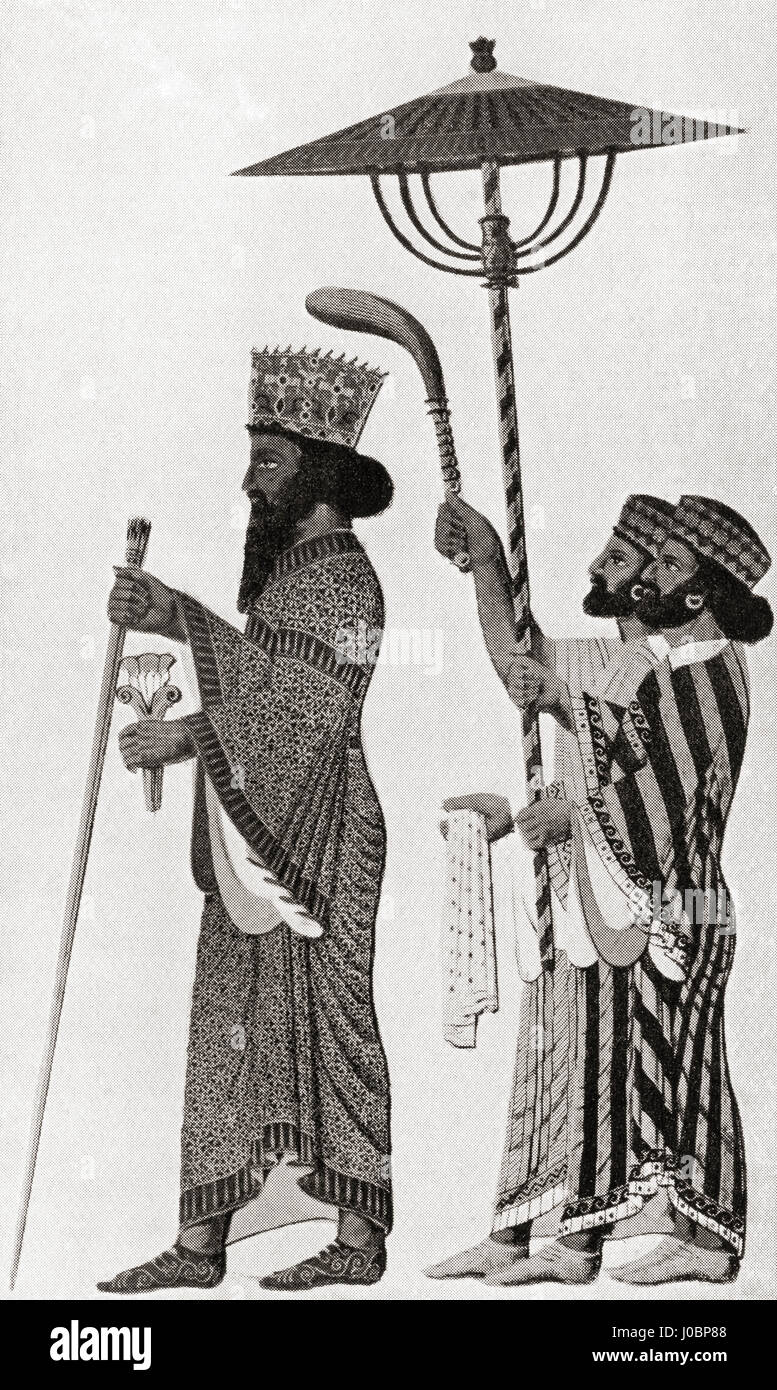 Darius I, aka Darius the Great, c. 550–486 BC. Third king of the Persian Achaemenid Empire. Seen here with state umbrellas and attendants, from a carving on one of the door jambs of the palace of Darius I at Persepolis. From Hutchinson's History of the Nations, published 1915 Stock Photohttps://www.alamy.com/image-license-details/?v=1https://www.alamy.com/stock-photo-darius-i-aka-darius-the-great-c-550486-bc-third-king-of-the-persian-137941896.html
Darius I, aka Darius the Great, c. 550–486 BC. Third king of the Persian Achaemenid Empire. Seen here with state umbrellas and attendants, from a carving on one of the door jambs of the palace of Darius I at Persepolis. From Hutchinson's History of the Nations, published 1915 Stock Photohttps://www.alamy.com/image-license-details/?v=1https://www.alamy.com/stock-photo-darius-i-aka-darius-the-great-c-550486-bc-third-king-of-the-persian-137941896.htmlRMJ0BP88–Darius I, aka Darius the Great, c. 550–486 BC. Third king of the Persian Achaemenid Empire. Seen here with state umbrellas and attendants, from a carving on one of the door jambs of the palace of Darius I at Persepolis. From Hutchinson's History of the Nations, published 1915
 Hieroglyphs carved on the wall of an ancient temple. Remains of Persepolis. Achaemenid period. Antiquities before Christ Stock Photohttps://www.alamy.com/image-license-details/?v=1https://www.alamy.com/hieroglyphs-carved-on-the-wall-of-an-ancient-temple-remains-of-persepolis-achaemenid-period-antiquities-before-christ-image574471261.html
Hieroglyphs carved on the wall of an ancient temple. Remains of Persepolis. Achaemenid period. Antiquities before Christ Stock Photohttps://www.alamy.com/image-license-details/?v=1https://www.alamy.com/hieroglyphs-carved-on-the-wall-of-an-ancient-temple-remains-of-persepolis-achaemenid-period-antiquities-before-christ-image574471261.htmlRF2TAHBXN–Hieroglyphs carved on the wall of an ancient temple. Remains of Persepolis. Achaemenid period. Antiquities before Christ
 Darius I, King of the Achaemenid Empire, opens the tomb of the Babylonian Queen Nitocris. A story tells that Nitocris had herself entombed above a city gate, believing that Darius would not use that gate because he would not walk beneath a corpse. From an 18th century print after a painting by Eustache Lesueur. Stock Photohttps://www.alamy.com/image-license-details/?v=1https://www.alamy.com/darius-i-king-of-the-achaemenid-empire-opens-the-tomb-of-the-babylonian-queen-nitocris-a-story-tells-that-nitocris-had-herself-entombed-above-a-city-gate-believing-that-darius-would-not-use-that-gate-because-he-would-not-walk-beneath-a-corpse-from-an-18th-century-print-after-a-painting-by-eustache-lesueur-image478236329.html
Darius I, King of the Achaemenid Empire, opens the tomb of the Babylonian Queen Nitocris. A story tells that Nitocris had herself entombed above a city gate, believing that Darius would not use that gate because he would not walk beneath a corpse. From an 18th century print after a painting by Eustache Lesueur. Stock Photohttps://www.alamy.com/image-license-details/?v=1https://www.alamy.com/darius-i-king-of-the-achaemenid-empire-opens-the-tomb-of-the-babylonian-queen-nitocris-a-story-tells-that-nitocris-had-herself-entombed-above-a-city-gate-believing-that-darius-would-not-use-that-gate-because-he-would-not-walk-beneath-a-corpse-from-an-18th-century-print-after-a-painting-by-eustache-lesueur-image478236329.htmlRM2JP1F8W–Darius I, King of the Achaemenid Empire, opens the tomb of the Babylonian Queen Nitocris. A story tells that Nitocris had herself entombed above a city gate, believing that Darius would not use that gate because he would not walk beneath a corpse. From an 18th century print after a painting by Eustache Lesueur.
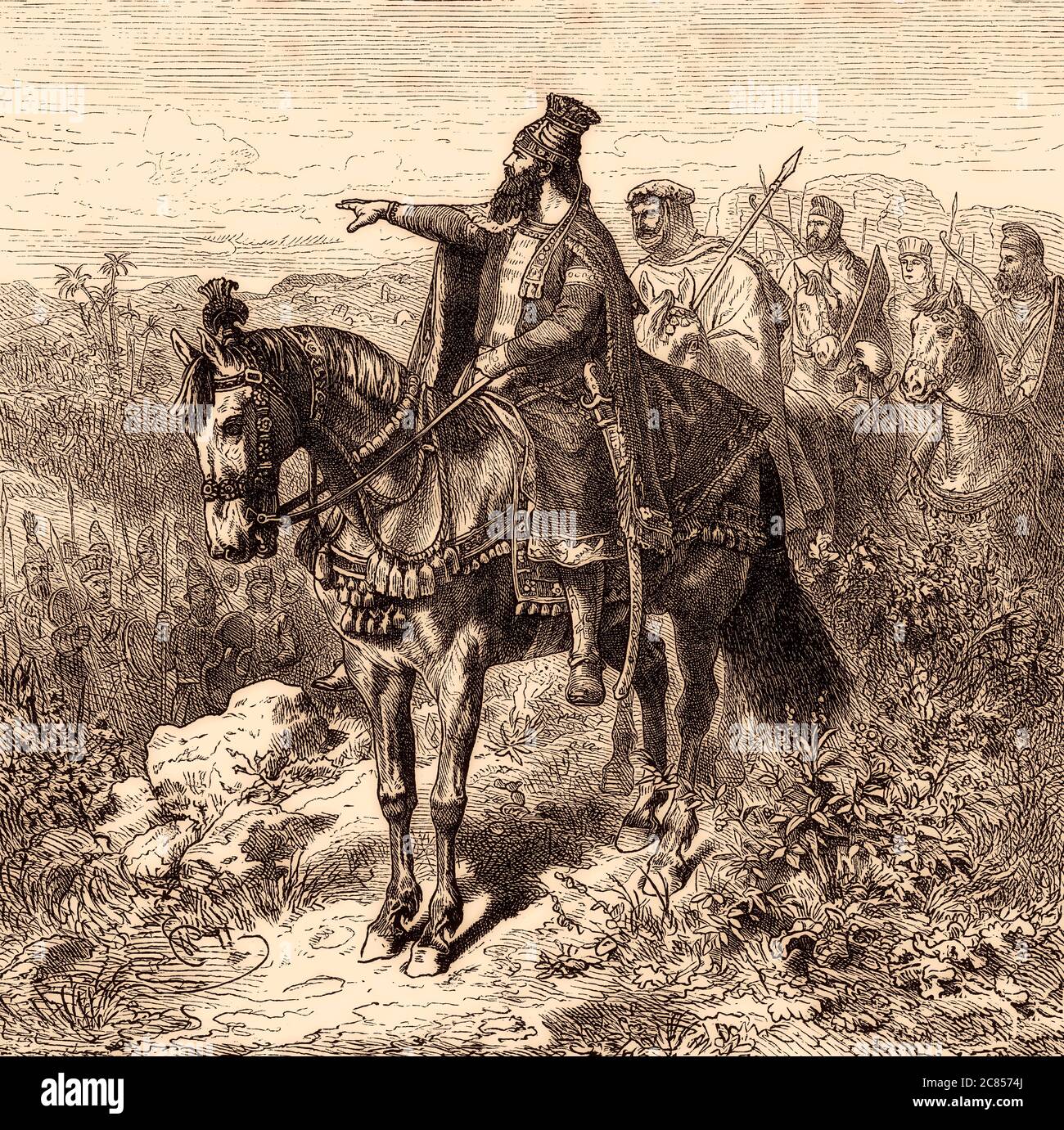 Cyrus the Great, king of the Persian Achaemenid Empire Stock Photohttps://www.alamy.com/image-license-details/?v=1https://www.alamy.com/cyrus-the-great-king-of-the-persian-achaemenid-empire-image366450354.html
Cyrus the Great, king of the Persian Achaemenid Empire Stock Photohttps://www.alamy.com/image-license-details/?v=1https://www.alamy.com/cyrus-the-great-king-of-the-persian-achaemenid-empire-image366450354.htmlRM2C8574J–Cyrus the Great, king of the Persian Achaemenid Empire
 Alexander the Great discovers the body of King Darius III. After a 19th century work by Gustave Dore. Alexander the Great, 356 BC - 323 BC. King Darius III, c.380 BC - 330 BC. Stock Photohttps://www.alamy.com/image-license-details/?v=1https://www.alamy.com/alexander-the-great-discovers-the-body-of-king-darius-iii-after-a-19th-century-work-by-gustave-dore-alexander-the-great-356-bc-323-bc-king-darius-iii-c380-bc-330-bc-image397958827.html
Alexander the Great discovers the body of King Darius III. After a 19th century work by Gustave Dore. Alexander the Great, 356 BC - 323 BC. King Darius III, c.380 BC - 330 BC. Stock Photohttps://www.alamy.com/image-license-details/?v=1https://www.alamy.com/alexander-the-great-discovers-the-body-of-king-darius-iii-after-a-19th-century-work-by-gustave-dore-alexander-the-great-356-bc-323-bc-king-darius-iii-c380-bc-330-bc-image397958827.htmlRM2E3CGF7–Alexander the Great discovers the body of King Darius III. After a 19th century work by Gustave Dore. Alexander the Great, 356 BC - 323 BC. King Darius III, c.380 BC - 330 BC.
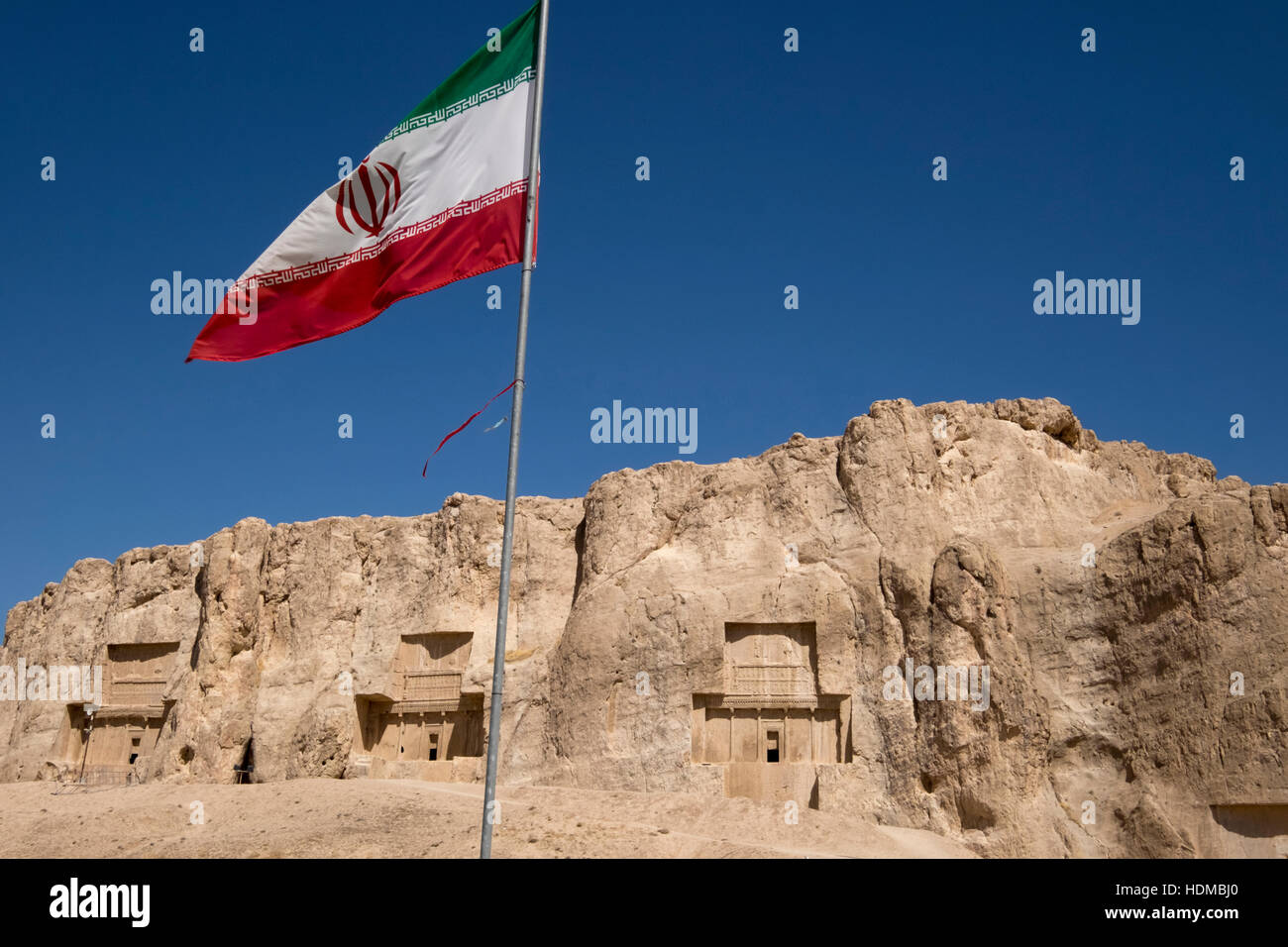 Naqsh-e Rustam is an ancient site consisting of colossal tombs of Persian Kings. Its located in Fars Province, Iran. Stock Photohttps://www.alamy.com/image-license-details/?v=1https://www.alamy.com/stock-photo-naqsh-e-rustam-is-an-ancient-site-consisting-of-colossal-tombs-of-128911272.html
Naqsh-e Rustam is an ancient site consisting of colossal tombs of Persian Kings. Its located in Fars Province, Iran. Stock Photohttps://www.alamy.com/image-license-details/?v=1https://www.alamy.com/stock-photo-naqsh-e-rustam-is-an-ancient-site-consisting-of-colossal-tombs-of-128911272.htmlRFHDMBJ0–Naqsh-e Rustam is an ancient site consisting of colossal tombs of Persian Kings. Its located in Fars Province, Iran.
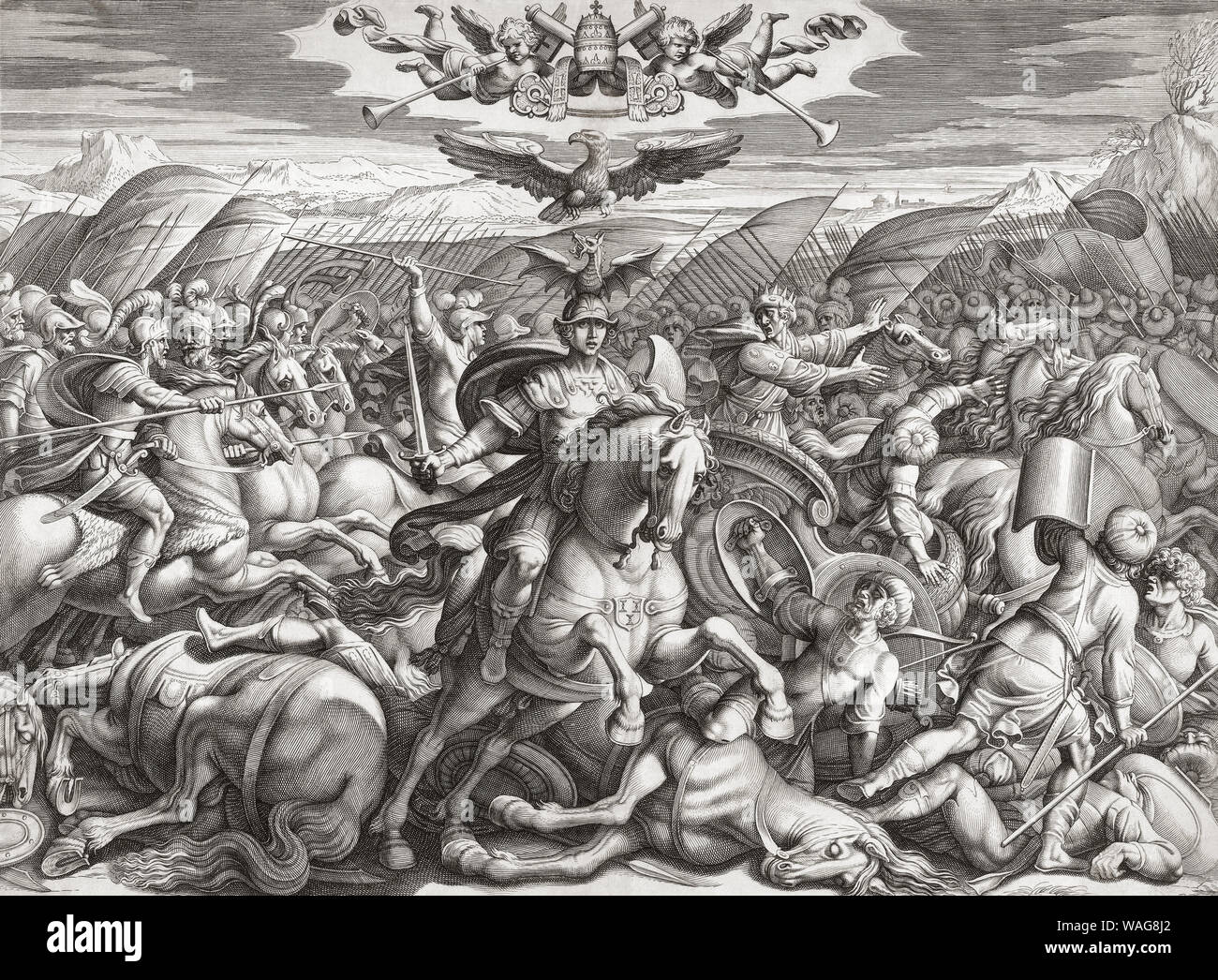 The Battle of Gaugamela, 331 BC, between Alexander the Great (centre) and Darius III (to Alexander’s left). After a work by Antonio Tempesta. Stock Photohttps://www.alamy.com/image-license-details/?v=1https://www.alamy.com/the-battle-of-gaugamela-331-bc-between-alexander-the-great-centre-and-darius-iii-to-alexanders-left-after-a-work-by-antonio-tempesta-image264660090.html
The Battle of Gaugamela, 331 BC, between Alexander the Great (centre) and Darius III (to Alexander’s left). After a work by Antonio Tempesta. Stock Photohttps://www.alamy.com/image-license-details/?v=1https://www.alamy.com/the-battle-of-gaugamela-331-bc-between-alexander-the-great-centre-and-darius-iii-to-alexanders-left-after-a-work-by-antonio-tempesta-image264660090.htmlRMWAG8J2–The Battle of Gaugamela, 331 BC, between Alexander the Great (centre) and Darius III (to Alexander’s left). After a work by Antonio Tempesta.
 Lobed bowl. Takht-i Kuwad, Tajikistan. 500-300 BC. Gold. Oxus Treasure. British Museum. London. GBR. Stock Photohttps://www.alamy.com/image-license-details/?v=1https://www.alamy.com/lobed-bowl-takht-i-kuwad-tajikistan-500-300-bc-gold-oxus-treasure-british-museum-london-gbr-image425371502.html
Lobed bowl. Takht-i Kuwad, Tajikistan. 500-300 BC. Gold. Oxus Treasure. British Museum. London. GBR. Stock Photohttps://www.alamy.com/image-license-details/?v=1https://www.alamy.com/lobed-bowl-takht-i-kuwad-tajikistan-500-300-bc-gold-oxus-treasure-british-museum-london-gbr-image425371502.htmlRM2FM19KA–Lobed bowl. Takht-i Kuwad, Tajikistan. 500-300 BC. Gold. Oxus Treasure. British Museum. London. GBR.
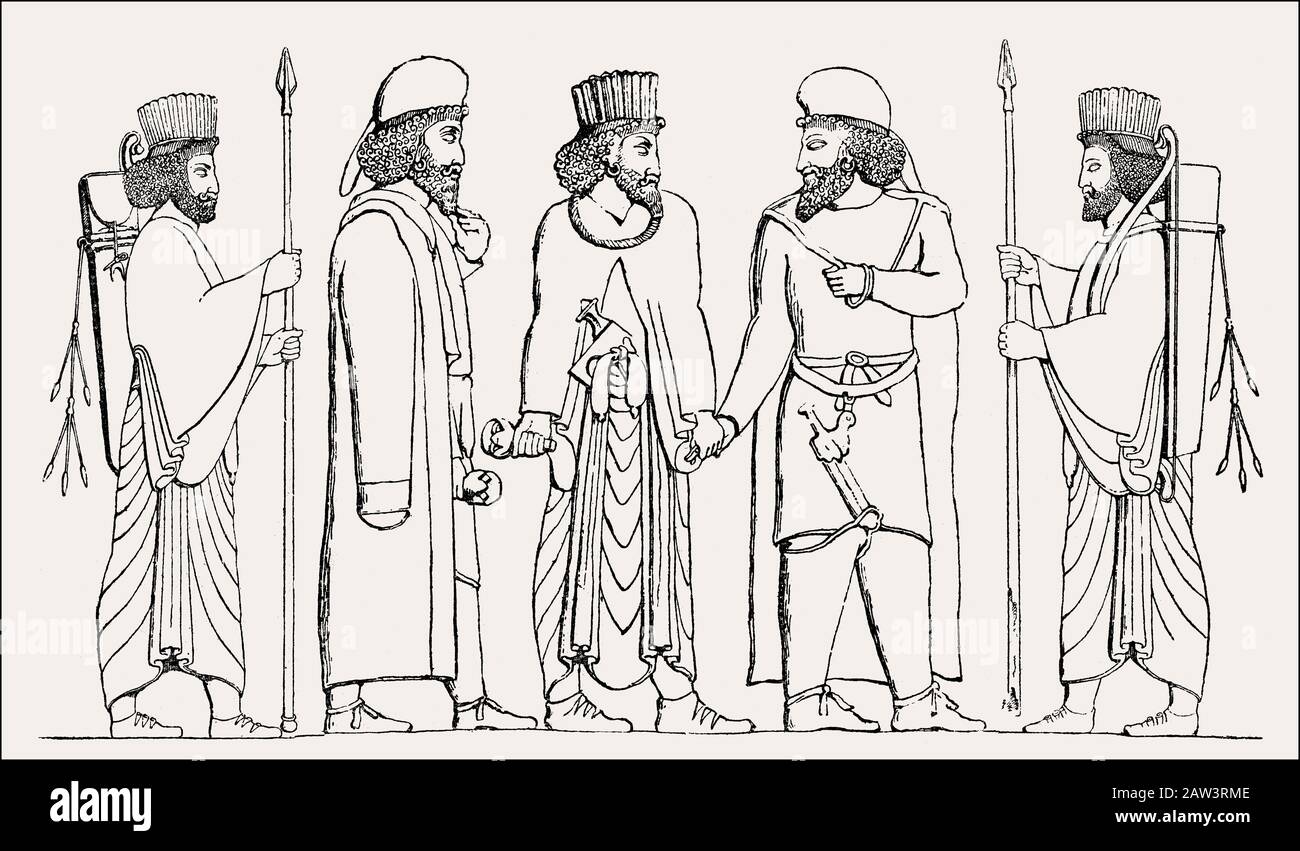 bodyguards of Cyrus the Great, king of the Persian Achaemenid Empire Stock Photohttps://www.alamy.com/image-license-details/?v=1https://www.alamy.com/bodyguards-of-cyrus-the-great-king-of-the-persian-achaemenid-empire-image342447854.html
bodyguards of Cyrus the Great, king of the Persian Achaemenid Empire Stock Photohttps://www.alamy.com/image-license-details/?v=1https://www.alamy.com/bodyguards-of-cyrus-the-great-king-of-the-persian-achaemenid-empire-image342447854.htmlRM2AW3RME–bodyguards of Cyrus the Great, king of the Persian Achaemenid Empire
 Naqsh-e Rostam,necropolis of the Achaemenid dynasty near Persepolis, with tomb of Darius I and the relief of Shapur I cut into the rocks. Iran. Stock Photohttps://www.alamy.com/image-license-details/?v=1https://www.alamy.com/naqsh-e-rostamnecropolis-of-the-achaemenid-dynasty-near-persepolis-with-tomb-of-darius-i-and-the-relief-of-shapur-i-cut-into-the-rocks-iran-image431048164.html
Naqsh-e Rostam,necropolis of the Achaemenid dynasty near Persepolis, with tomb of Darius I and the relief of Shapur I cut into the rocks. Iran. Stock Photohttps://www.alamy.com/image-license-details/?v=1https://www.alamy.com/naqsh-e-rostamnecropolis-of-the-achaemenid-dynasty-near-persepolis-with-tomb-of-darius-i-and-the-relief-of-shapur-i-cut-into-the-rocks-iran-image431048164.htmlRF2G17X98–Naqsh-e Rostam,necropolis of the Achaemenid dynasty near Persepolis, with tomb of Darius I and the relief of Shapur I cut into the rocks. Iran.
 Iran. Persepolis. Capital of the Achaemenid Empire (ca. 550-330 BC). Palatial city built by King Darius I and destroyed by Alexander the Great in 330 Stock Photohttps://www.alamy.com/image-license-details/?v=1https://www.alamy.com/iran-persepolis-capital-of-the-achaemenid-empire-ca-550-330-bc-palatial-city-built-by-king-darius-i-and-destroyed-by-alexander-the-great-in-330-image439551209.html
Iran. Persepolis. Capital of the Achaemenid Empire (ca. 550-330 BC). Palatial city built by King Darius I and destroyed by Alexander the Great in 330 Stock Photohttps://www.alamy.com/image-license-details/?v=1https://www.alamy.com/iran-persepolis-capital-of-the-achaemenid-empire-ca-550-330-bc-palatial-city-built-by-king-darius-i-and-destroyed-by-alexander-the-great-in-330-image439551209.htmlRF2GF381D–Iran. Persepolis. Capital of the Achaemenid Empire (ca. 550-330 BC). Palatial city built by King Darius I and destroyed by Alexander the Great in 330
 Rembrandt Harmenszoon van Rijn's painting titled 'Ahasuerus and Haman at the Feast of Esther' . Rembrandt (1606-1669) Dutch painter and etcher of the Dutch Golden Age and Baroque period. Dated 17th Century Stock Photohttps://www.alamy.com/image-license-details/?v=1https://www.alamy.com/stock-photo-rembrandt-harmenszoon-van-rijns-painting-titled-ahasuerus-and-haman-84970271.html
Rembrandt Harmenszoon van Rijn's painting titled 'Ahasuerus and Haman at the Feast of Esther' . Rembrandt (1606-1669) Dutch painter and etcher of the Dutch Golden Age and Baroque period. Dated 17th Century Stock Photohttps://www.alamy.com/image-license-details/?v=1https://www.alamy.com/stock-photo-rembrandt-harmenszoon-van-rijns-painting-titled-ahasuerus-and-haman-84970271.htmlRMEX6MCF–Rembrandt Harmenszoon van Rijn's painting titled 'Ahasuerus and Haman at the Feast of Esther' . Rembrandt (1606-1669) Dutch painter and etcher of the Dutch Golden Age and Baroque period. Dated 17th Century
 Stamp Seal. West Asia, Achaemenid Period, 6th-late 4th century B.C.. Tools and Equipment; seals. Agate Stock Photohttps://www.alamy.com/image-license-details/?v=1https://www.alamy.com/stamp-seal-west-asia-achaemenid-period-6th-late-4th-century-bc-tools-and-equipment-seals-agate-image464667717.html
Stamp Seal. West Asia, Achaemenid Period, 6th-late 4th century B.C.. Tools and Equipment; seals. Agate Stock Photohttps://www.alamy.com/image-license-details/?v=1https://www.alamy.com/stamp-seal-west-asia-achaemenid-period-6th-late-4th-century-bc-tools-and-equipment-seals-agate-image464667717.htmlRM2HYYCBH–Stamp Seal. West Asia, Achaemenid Period, 6th-late 4th century B.C.. Tools and Equipment; seals. Agate
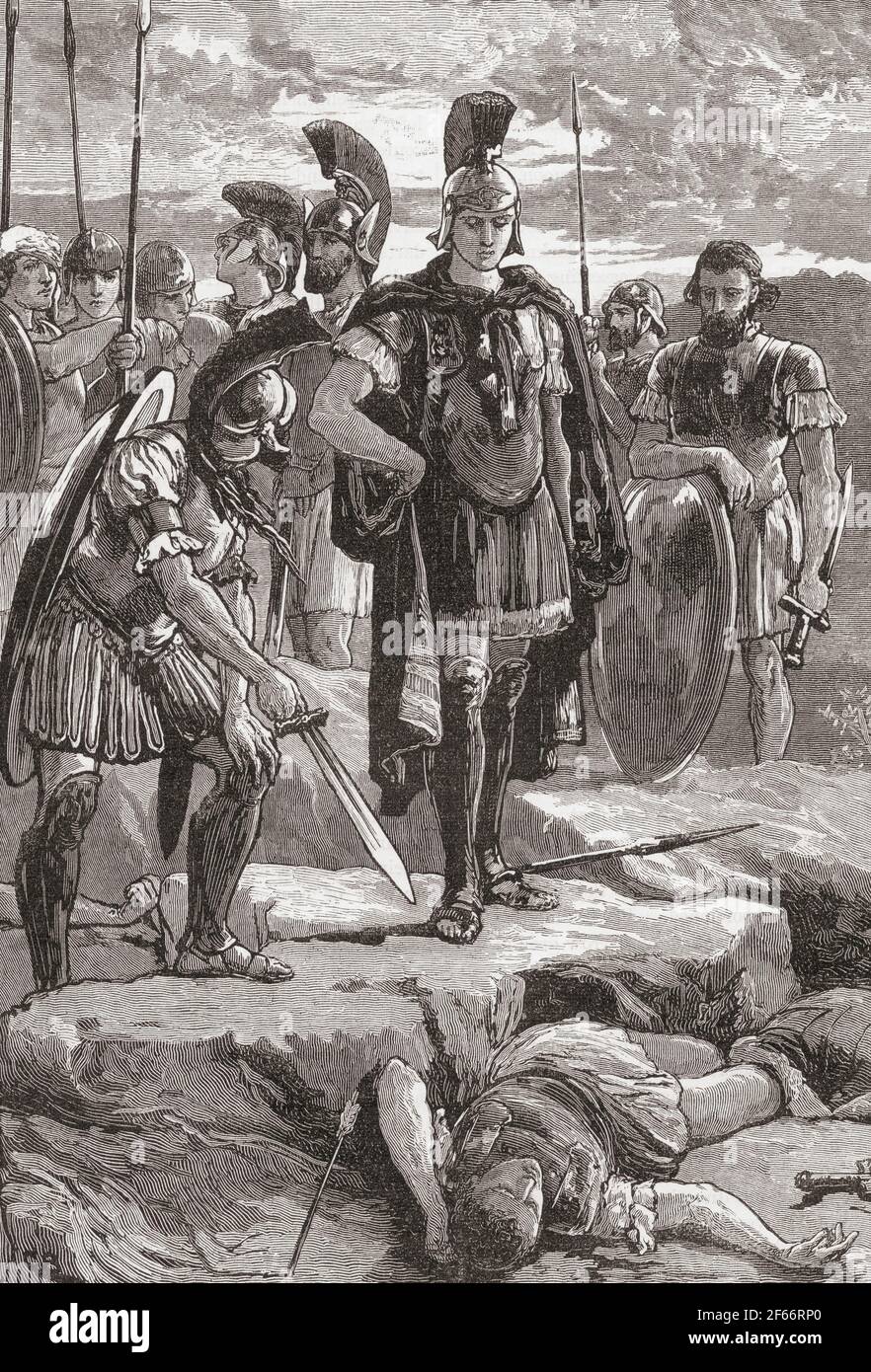 Alexander and the body of Daruis III. Alexander III of Macedon, 20/21 July 356 BC – 10/11 June 323 BC, aka Alexander the Great. King of the ancient Greek kingdom of Macedon. Darius III, c. 380 – 330 BC. Last Achaemenid King of Kings of Persia. From Cassell's Universal History, published 1888. Stock Photohttps://www.alamy.com/image-license-details/?v=1https://www.alamy.com/alexander-and-the-body-of-daruis-iii-alexander-iii-of-macedon-2021-july-356-bc-1011-june-323-bc-aka-alexander-the-great-king-of-the-ancient-greek-kingdom-of-macedon-darius-iii-c-380-330-bc-last-achaemenid-king-of-kings-of-persia-from-cassells-universal-history-published-1888-image416887128.html
Alexander and the body of Daruis III. Alexander III of Macedon, 20/21 July 356 BC – 10/11 June 323 BC, aka Alexander the Great. King of the ancient Greek kingdom of Macedon. Darius III, c. 380 – 330 BC. Last Achaemenid King of Kings of Persia. From Cassell's Universal History, published 1888. Stock Photohttps://www.alamy.com/image-license-details/?v=1https://www.alamy.com/alexander-and-the-body-of-daruis-iii-alexander-iii-of-macedon-2021-july-356-bc-1011-june-323-bc-aka-alexander-the-great-king-of-the-ancient-greek-kingdom-of-macedon-darius-iii-c-380-330-bc-last-achaemenid-king-of-kings-of-persia-from-cassells-universal-history-published-1888-image416887128.htmlRM2F66RP0–Alexander and the body of Daruis III. Alexander III of Macedon, 20/21 July 356 BC – 10/11 June 323 BC, aka Alexander the Great. King of the ancient Greek kingdom of Macedon. Darius III, c. 380 – 330 BC. Last Achaemenid King of Kings of Persia. From Cassell's Universal History, published 1888.
 Greece Battle of Thermopylae Leonidas monument Stock Photohttps://www.alamy.com/image-license-details/?v=1https://www.alamy.com/greece-battle-of-thermopylae-leonidas-monument-image450853839.html
Greece Battle of Thermopylae Leonidas monument Stock Photohttps://www.alamy.com/image-license-details/?v=1https://www.alamy.com/greece-battle-of-thermopylae-leonidas-monument-image450853839.htmlRF2H5E4JR–Greece Battle of Thermopylae Leonidas monument
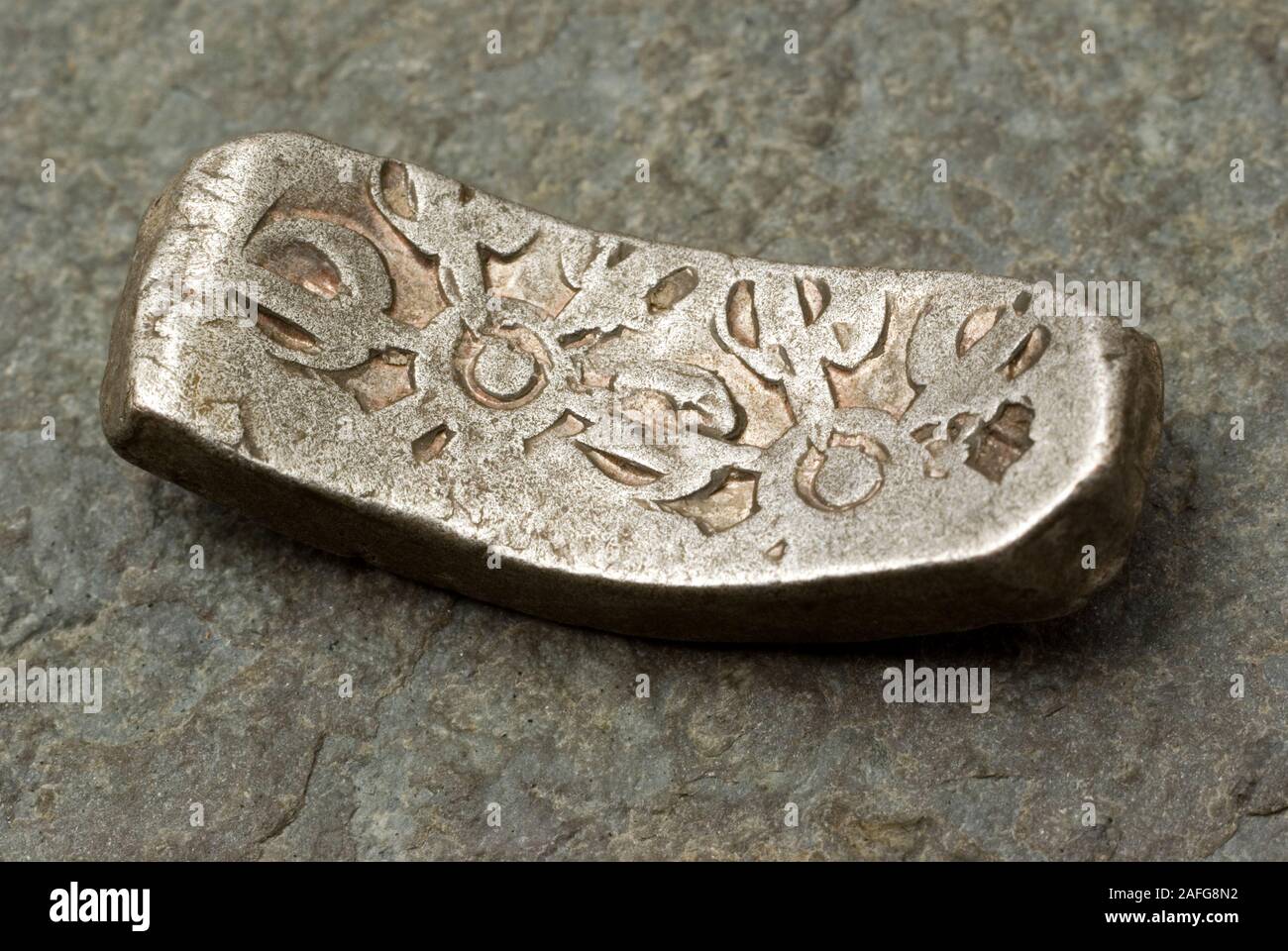 Ancient Indian Coin Circa 500-300 B.C Stock Photohttps://www.alamy.com/image-license-details/?v=1https://www.alamy.com/ancient-indian-coin-circa-500-300-bc-image336574926.html
Ancient Indian Coin Circa 500-300 B.C Stock Photohttps://www.alamy.com/image-license-details/?v=1https://www.alamy.com/ancient-indian-coin-circa-500-300-bc-image336574926.htmlRM2AFG8N2–Ancient Indian Coin Circa 500-300 B.C
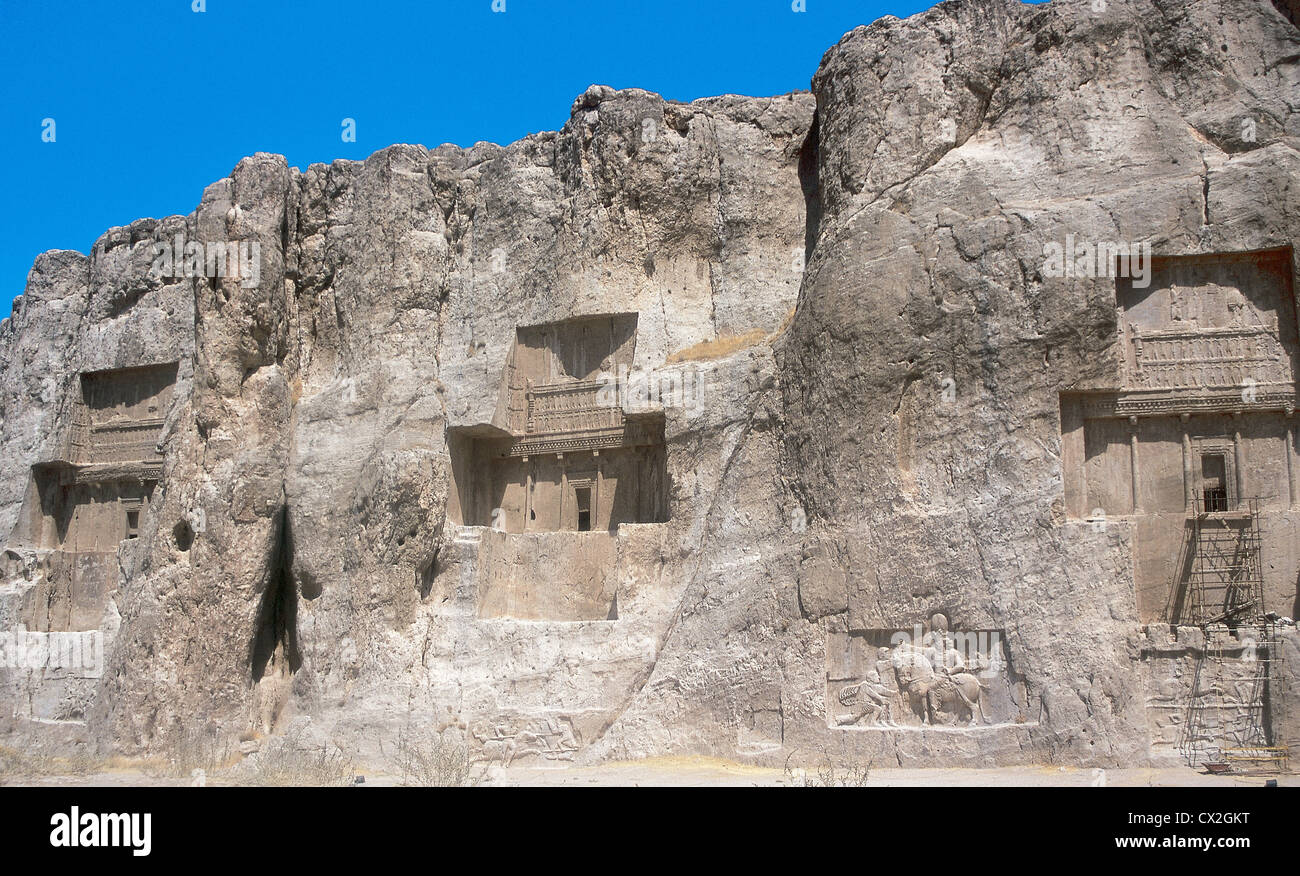 Persian Art. Achaemenid Period. Tombs of Darius I, Xerxes I and Darius II. Necropolis of Naqsh-e Rustam. Around Persepolis. Stock Photohttps://www.alamy.com/image-license-details/?v=1https://www.alamy.com/stock-photo-persian-art-achaemenid-period-tombs-of-darius-i-xerxes-i-and-darius-50458796.html
Persian Art. Achaemenid Period. Tombs of Darius I, Xerxes I and Darius II. Necropolis of Naqsh-e Rustam. Around Persepolis. Stock Photohttps://www.alamy.com/image-license-details/?v=1https://www.alamy.com/stock-photo-persian-art-achaemenid-period-tombs-of-darius-i-xerxes-i-and-darius-50458796.htmlRMCX2GKT–Persian Art. Achaemenid Period. Tombs of Darius I, Xerxes I and Darius II. Necropolis of Naqsh-e Rustam. Around Persepolis.
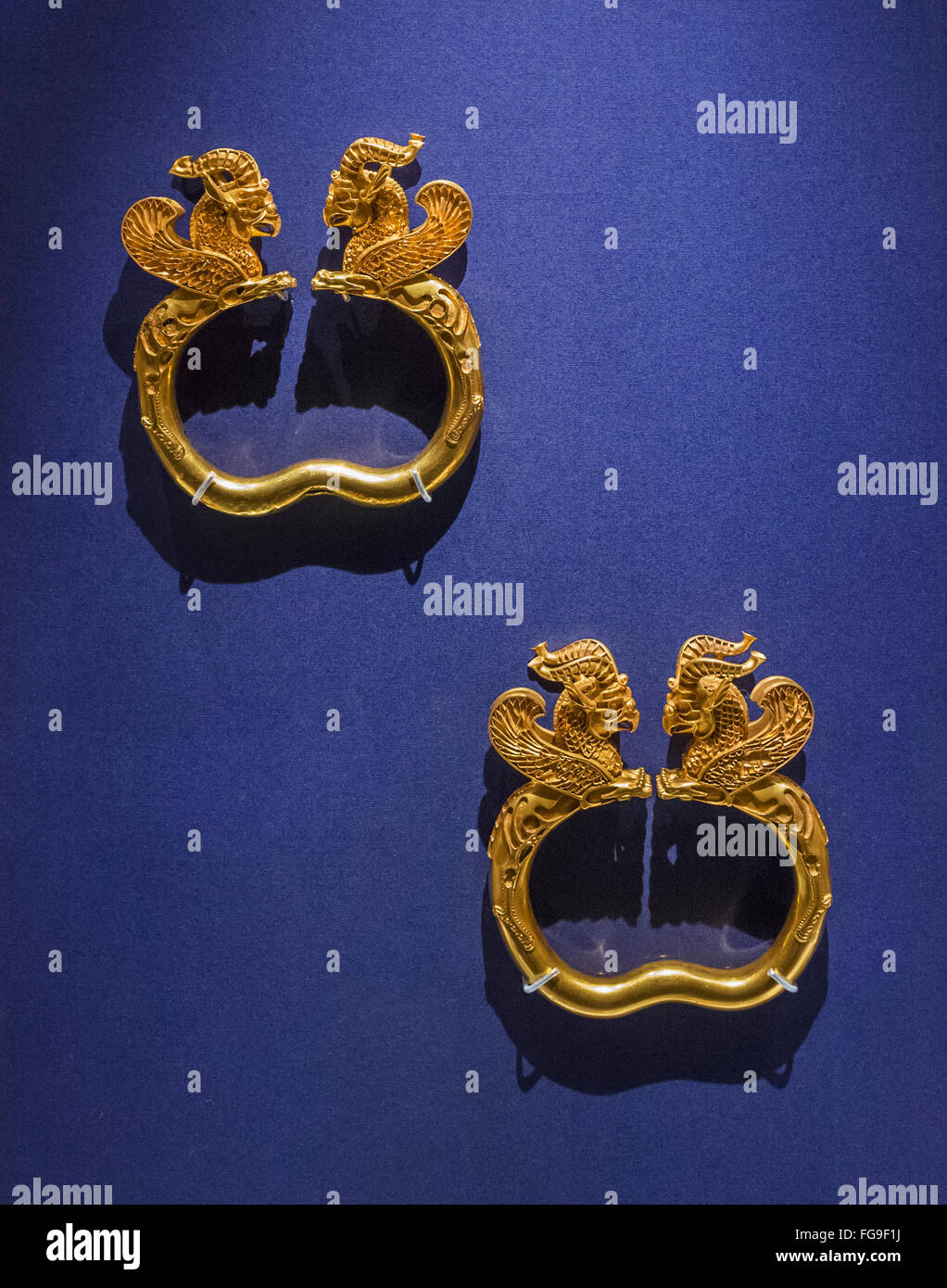 5th to 4th Century BC Achaemenid armlets from the Oxus Treasure, Ancient Iran gallery, British Museum, London, UK Stock Photohttps://www.alamy.com/image-license-details/?v=1https://www.alamy.com/stock-photo-5th-to-4th-century-bc-achaemenid-armlets-from-the-oxus-treasure-ancient-96095710.html
5th to 4th Century BC Achaemenid armlets from the Oxus Treasure, Ancient Iran gallery, British Museum, London, UK Stock Photohttps://www.alamy.com/image-license-details/?v=1https://www.alamy.com/stock-photo-5th-to-4th-century-bc-achaemenid-armlets-from-the-oxus-treasure-ancient-96095710.htmlRMFG9F1J–5th to 4th Century BC Achaemenid armlets from the Oxus Treasure, Ancient Iran gallery, British Museum, London, UK
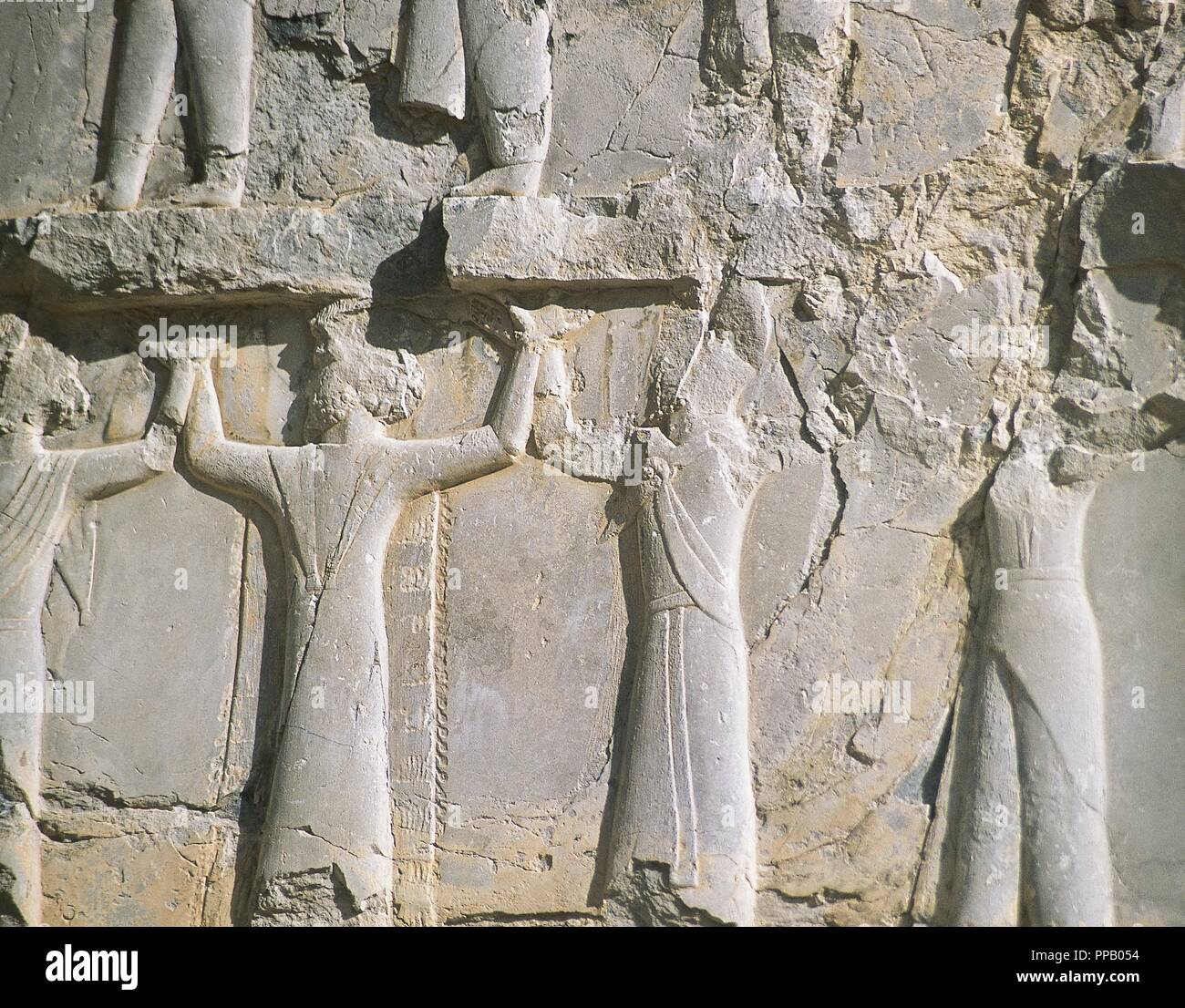 Persian art. Achaemenid period. 5th century B.C. Persepolis (Takht-e-Jamshid). Throne Hall or the Imperial Army's hall of honour, also called the Hundred-Columns Palace. Relief depicting the different peoples of the Empire bearing the royal throne. Islamic Republic of Iran. Stock Photohttps://www.alamy.com/image-license-details/?v=1https://www.alamy.com/persian-art-achaemenid-period-5th-century-bc-persepolis-takht-e-jamshid-throne-hall-or-the-imperial-armys-hall-of-honour-also-called-the-hundred-columns-palace-relief-depicting-the-different-peoples-of-the-empire-bearing-the-royal-throne-islamic-republic-of-iran-image220288464.html
Persian art. Achaemenid period. 5th century B.C. Persepolis (Takht-e-Jamshid). Throne Hall or the Imperial Army's hall of honour, also called the Hundred-Columns Palace. Relief depicting the different peoples of the Empire bearing the royal throne. Islamic Republic of Iran. Stock Photohttps://www.alamy.com/image-license-details/?v=1https://www.alamy.com/persian-art-achaemenid-period-5th-century-bc-persepolis-takht-e-jamshid-throne-hall-or-the-imperial-armys-hall-of-honour-also-called-the-hundred-columns-palace-relief-depicting-the-different-peoples-of-the-empire-bearing-the-royal-throne-islamic-republic-of-iran-image220288464.htmlRMPPB054–Persian art. Achaemenid period. 5th century B.C. Persepolis (Takht-e-Jamshid). Throne Hall or the Imperial Army's hall of honour, also called the Hundred-Columns Palace. Relief depicting the different peoples of the Empire bearing the royal throne. Islamic Republic of Iran.
 Iran. Naqsh-e Rostam. Cube of Zoroaster (Kaba Zartosht) fire temple. Late 6th century BC-early 5th century BC. Achaemenid period. Near Shiraz. Stock Photohttps://www.alamy.com/image-license-details/?v=1https://www.alamy.com/iran-naqsh-e-rostam-cube-of-zoroaster-kaba-zartosht-fire-temple-late-6th-century-bc-early-5th-century-bc-achaemenid-period-near-shiraz-image179742453.html
Iran. Naqsh-e Rostam. Cube of Zoroaster (Kaba Zartosht) fire temple. Late 6th century BC-early 5th century BC. Achaemenid period. Near Shiraz. Stock Photohttps://www.alamy.com/image-license-details/?v=1https://www.alamy.com/iran-naqsh-e-rostam-cube-of-zoroaster-kaba-zartosht-fire-temple-late-6th-century-bc-early-5th-century-bc-achaemenid-period-near-shiraz-image179742453.htmlRMMCBY99–Iran. Naqsh-e Rostam. Cube of Zoroaster (Kaba Zartosht) fire temple. Late 6th century BC-early 5th century BC. Achaemenid period. Near Shiraz.
 Hieroglyphs carved on the wall of an ancient temple. Remains of Persepolis. Achaemenid period. Antiquities before Christ Stock Photohttps://www.alamy.com/image-license-details/?v=1https://www.alamy.com/hieroglyphs-carved-on-the-wall-of-an-ancient-temple-remains-of-persepolis-achaemenid-period-antiquities-before-christ-image574469114.html
Hieroglyphs carved on the wall of an ancient temple. Remains of Persepolis. Achaemenid period. Antiquities before Christ Stock Photohttps://www.alamy.com/image-license-details/?v=1https://www.alamy.com/hieroglyphs-carved-on-the-wall-of-an-ancient-temple-remains-of-persepolis-achaemenid-period-antiquities-before-christ-image574469114.htmlRF2TAH962–Hieroglyphs carved on the wall of an ancient temple. Remains of Persepolis. Achaemenid period. Antiquities before Christ
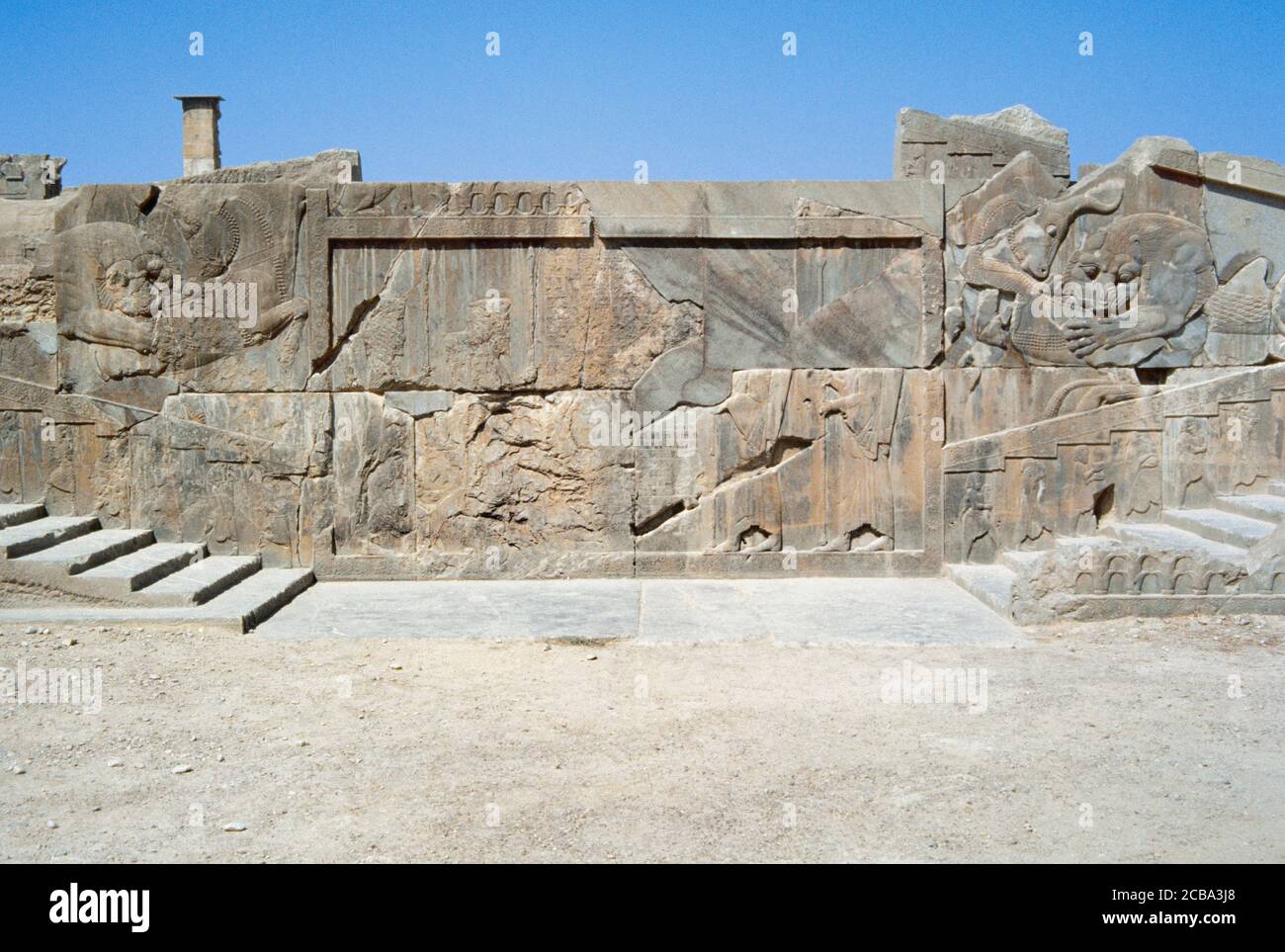 Iran. Persepolis. Capital of the Achaemenid Empire (ca. 550-330 BC). Palatial city built by King Darius I and destroyed by Alexander the Great in 330 BC. Staircase of the Palace of Xerxes (Hadish). The walls are decorated with Lion-Bull motifs (symbol of the time cycle of the day; lion represents the sun and the bull represents the night). Stock Photohttps://www.alamy.com/image-license-details/?v=1https://www.alamy.com/iran-persepolis-capital-of-the-achaemenid-empire-ca-550-330-bc-palatial-city-built-by-king-darius-i-and-destroyed-by-alexander-the-great-in-330-bc-staircase-of-the-palace-of-xerxes-hadish-the-walls-are-decorated-with-lion-bull-motifs-symbol-of-the-time-cycle-of-the-day-lion-represents-the-sun-and-the-bull-represents-the-night-image368401328.html
Iran. Persepolis. Capital of the Achaemenid Empire (ca. 550-330 BC). Palatial city built by King Darius I and destroyed by Alexander the Great in 330 BC. Staircase of the Palace of Xerxes (Hadish). The walls are decorated with Lion-Bull motifs (symbol of the time cycle of the day; lion represents the sun and the bull represents the night). Stock Photohttps://www.alamy.com/image-license-details/?v=1https://www.alamy.com/iran-persepolis-capital-of-the-achaemenid-empire-ca-550-330-bc-palatial-city-built-by-king-darius-i-and-destroyed-by-alexander-the-great-in-330-bc-staircase-of-the-palace-of-xerxes-hadish-the-walls-are-decorated-with-lion-bull-motifs-symbol-of-the-time-cycle-of-the-day-lion-represents-the-sun-and-the-bull-represents-the-night-image368401328.htmlRM2CBA3J8–Iran. Persepolis. Capital of the Achaemenid Empire (ca. 550-330 BC). Palatial city built by King Darius I and destroyed by Alexander the Great in 330 BC. Staircase of the Palace of Xerxes (Hadish). The walls are decorated with Lion-Bull motifs (symbol of the time cycle of the day; lion represents the sun and the bull represents the night).
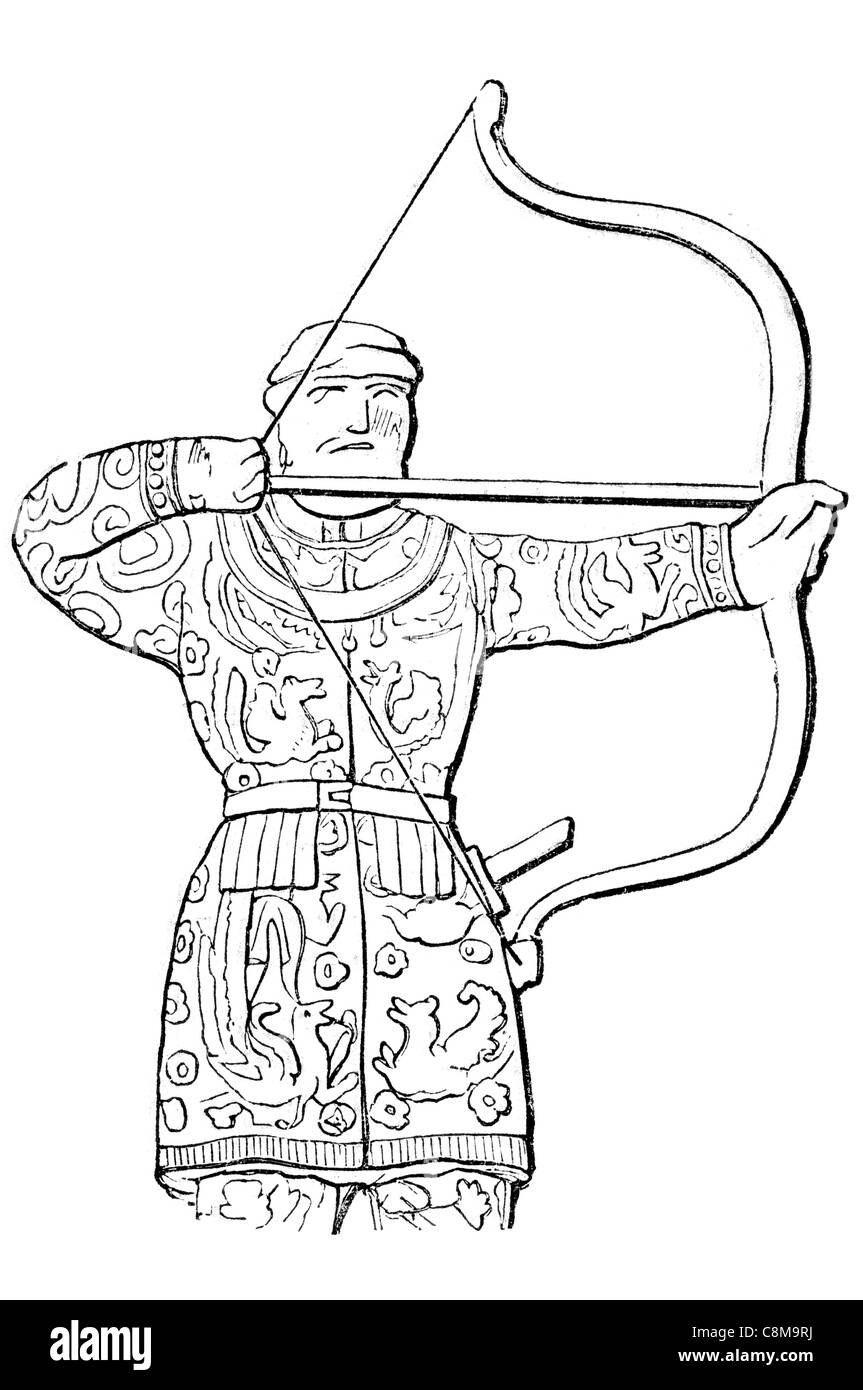 Persian Archer bow arrow warrior soldier sword army military Perspolis ceremonial Achaemenid Empire Shiraz Iran Takht-e Jamshid Stock Photohttps://www.alamy.com/image-license-details/?v=1https://www.alamy.com/stock-photo-persian-archer-bow-arrow-warrior-soldier-sword-army-military-perspolis-39784742.html
Persian Archer bow arrow warrior soldier sword army military Perspolis ceremonial Achaemenid Empire Shiraz Iran Takht-e Jamshid Stock Photohttps://www.alamy.com/image-license-details/?v=1https://www.alamy.com/stock-photo-persian-archer-bow-arrow-warrior-soldier-sword-army-military-perspolis-39784742.htmlRMC8M9RJ–Persian Archer bow arrow warrior soldier sword army military Perspolis ceremonial Achaemenid Empire Shiraz Iran Takht-e Jamshid
 Mausoleum of Cyrus the Great. Achaemenid king of Persia (559-530 BC), he was the founder of the Achaemenid Empire. The design of the tomb is credited to Mesopotamian or Elamite ziggurats. The cella is attributed to Urartu tombs of an earlier period. Pasargadae. Iran. Stock Photohttps://www.alamy.com/image-license-details/?v=1https://www.alamy.com/mausoleum-of-cyrus-the-great-achaemenid-king-of-persia-559-530-bc-he-was-the-founder-of-the-achaemenid-empire-the-design-of-the-tomb-is-credited-to-mesopotamian-or-elamite-ziggurats-the-cella-is-attributed-to-urartu-tombs-of-an-earlier-period-pasargadae-iran-image186815662.html
Mausoleum of Cyrus the Great. Achaemenid king of Persia (559-530 BC), he was the founder of the Achaemenid Empire. The design of the tomb is credited to Mesopotamian or Elamite ziggurats. The cella is attributed to Urartu tombs of an earlier period. Pasargadae. Iran. Stock Photohttps://www.alamy.com/image-license-details/?v=1https://www.alamy.com/mausoleum-of-cyrus-the-great-achaemenid-king-of-persia-559-530-bc-he-was-the-founder-of-the-achaemenid-empire-the-design-of-the-tomb-is-credited-to-mesopotamian-or-elamite-ziggurats-the-cella-is-attributed-to-urartu-tombs-of-an-earlier-period-pasargadae-iran-image186815662.htmlRMMRX57X–Mausoleum of Cyrus the Great. Achaemenid king of Persia (559-530 BC), he was the founder of the Achaemenid Empire. The design of the tomb is credited to Mesopotamian or Elamite ziggurats. The cella is attributed to Urartu tombs of an earlier period. Pasargadae. Iran.
 Persepolis, Fars Province, Iran Stock Photohttps://www.alamy.com/image-license-details/?v=1https://www.alamy.com/stock-photo-persepolis-fars-province-iran-126641930.html
Persepolis, Fars Province, Iran Stock Photohttps://www.alamy.com/image-license-details/?v=1https://www.alamy.com/stock-photo-persepolis-fars-province-iran-126641930.htmlRMHA1122–Persepolis, Fars Province, Iran
 Relief: two servants bearing food and drink, ca. 358–338 B.C Stock Photohttps://www.alamy.com/image-license-details/?v=1https://www.alamy.com/stock-image-relief-two-servants-bearing-food-and-drink-ca-358338-bc-162427096.html
Relief: two servants bearing food and drink, ca. 358–338 B.C Stock Photohttps://www.alamy.com/image-license-details/?v=1https://www.alamy.com/stock-image-relief-two-servants-bearing-food-and-drink-ca-358338-bc-162427096.htmlRMKC75BM–Relief: two servants bearing food and drink, ca. 358–338 B.C
 Bowl. Takht-i Kuwad, Tajikistan. 500-300 BC. Silver. Oxus Treasure. British Museum. London. GBR. Stock Photohttps://www.alamy.com/image-license-details/?v=1https://www.alamy.com/bowl-takht-i-kuwad-tajikistan-500-300-bc-silver-oxus-treasure-british-museum-london-gbr-image425371503.html
Bowl. Takht-i Kuwad, Tajikistan. 500-300 BC. Silver. Oxus Treasure. British Museum. London. GBR. Stock Photohttps://www.alamy.com/image-license-details/?v=1https://www.alamy.com/bowl-takht-i-kuwad-tajikistan-500-300-bc-silver-oxus-treasure-british-museum-london-gbr-image425371503.htmlRM2FM19KB–Bowl. Takht-i Kuwad, Tajikistan. 500-300 BC. Silver. Oxus Treasure. British Museum. London. GBR.
 Alexander the Great before the dead Darius III; Battle of Gaugamela; 331 BC Stock Photohttps://www.alamy.com/image-license-details/?v=1https://www.alamy.com/alexander-the-great-before-the-dead-darius-iii-battle-of-gaugamela-331-bc-image342448145.html
Alexander the Great before the dead Darius III; Battle of Gaugamela; 331 BC Stock Photohttps://www.alamy.com/image-license-details/?v=1https://www.alamy.com/alexander-the-great-before-the-dead-darius-iii-battle-of-gaugamela-331-bc-image342448145.htmlRM2AW3T2W–Alexander the Great before the dead Darius III; Battle of Gaugamela; 331 BC
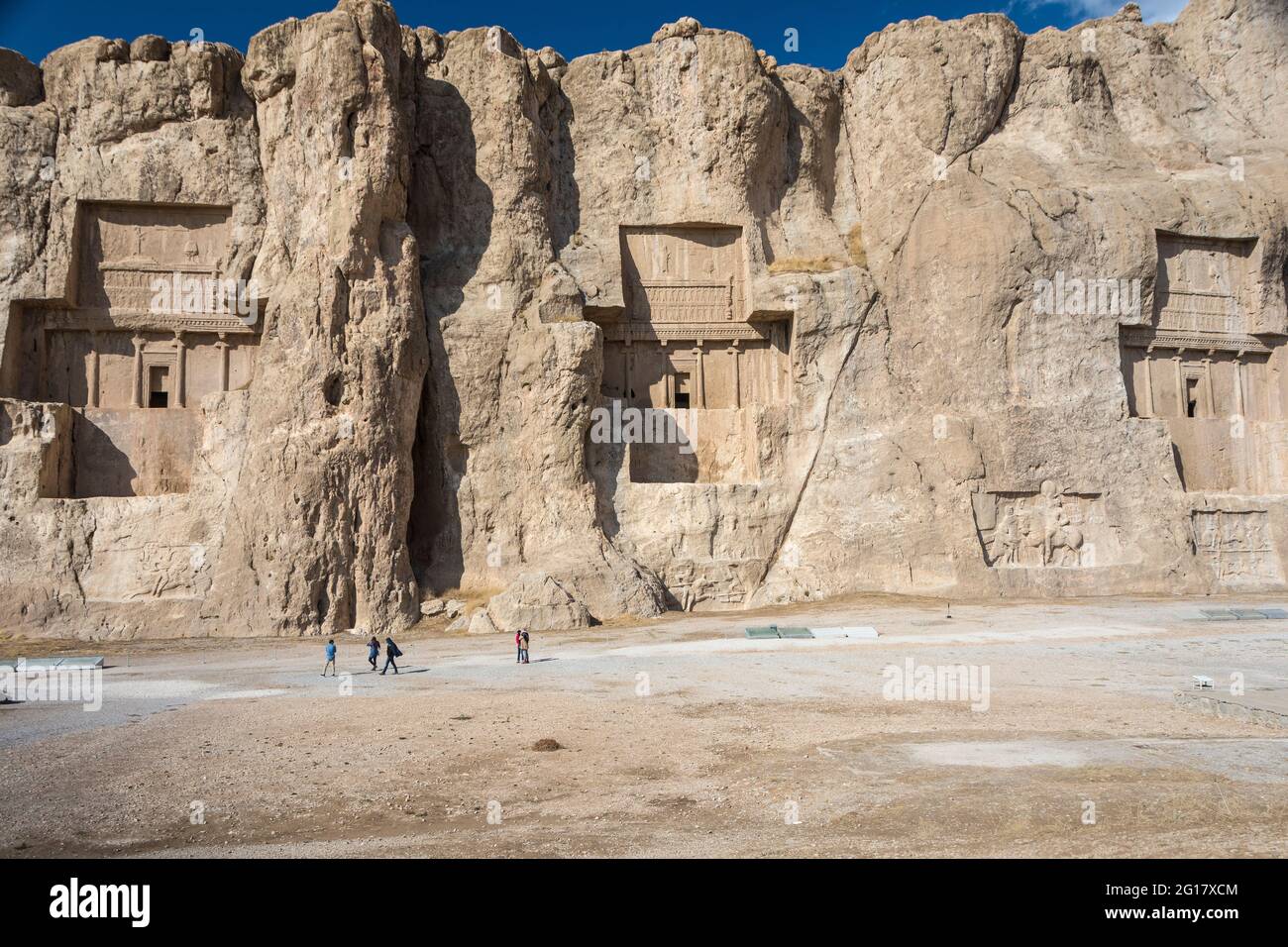 Naqsh-e Rostam,necropolis of the Achaemenid dynasty near Persepolis, with tombs of Darius II,Artaxerxes I,Darius I,cut high into the cliff face. Iran. Stock Photohttps://www.alamy.com/image-license-details/?v=1https://www.alamy.com/naqsh-e-rostamnecropolis-of-the-achaemenid-dynasty-near-persepolis-with-tombs-of-darius-iiartaxerxes-idarius-icut-high-into-the-cliff-face-iran-image431048260.html
Naqsh-e Rostam,necropolis of the Achaemenid dynasty near Persepolis, with tombs of Darius II,Artaxerxes I,Darius I,cut high into the cliff face. Iran. Stock Photohttps://www.alamy.com/image-license-details/?v=1https://www.alamy.com/naqsh-e-rostamnecropolis-of-the-achaemenid-dynasty-near-persepolis-with-tombs-of-darius-iiartaxerxes-idarius-icut-high-into-the-cliff-face-iran-image431048260.htmlRM2G17XCM–Naqsh-e Rostam,necropolis of the Achaemenid dynasty near Persepolis, with tombs of Darius II,Artaxerxes I,Darius I,cut high into the cliff face. Iran.